Building and Construction
VerifiedAdded on 2022/11/28
|40
|8249
|431
AI Summary
This document provides information on establishing clear lines of communication on a construction site, selecting the best communication methods, project plans and specifications, cost estimation for building projects, progress payments, on-site communication activities, and more.
Contribute Materials
Your contribution can guide someone’s learning journey. Share your
documents today.
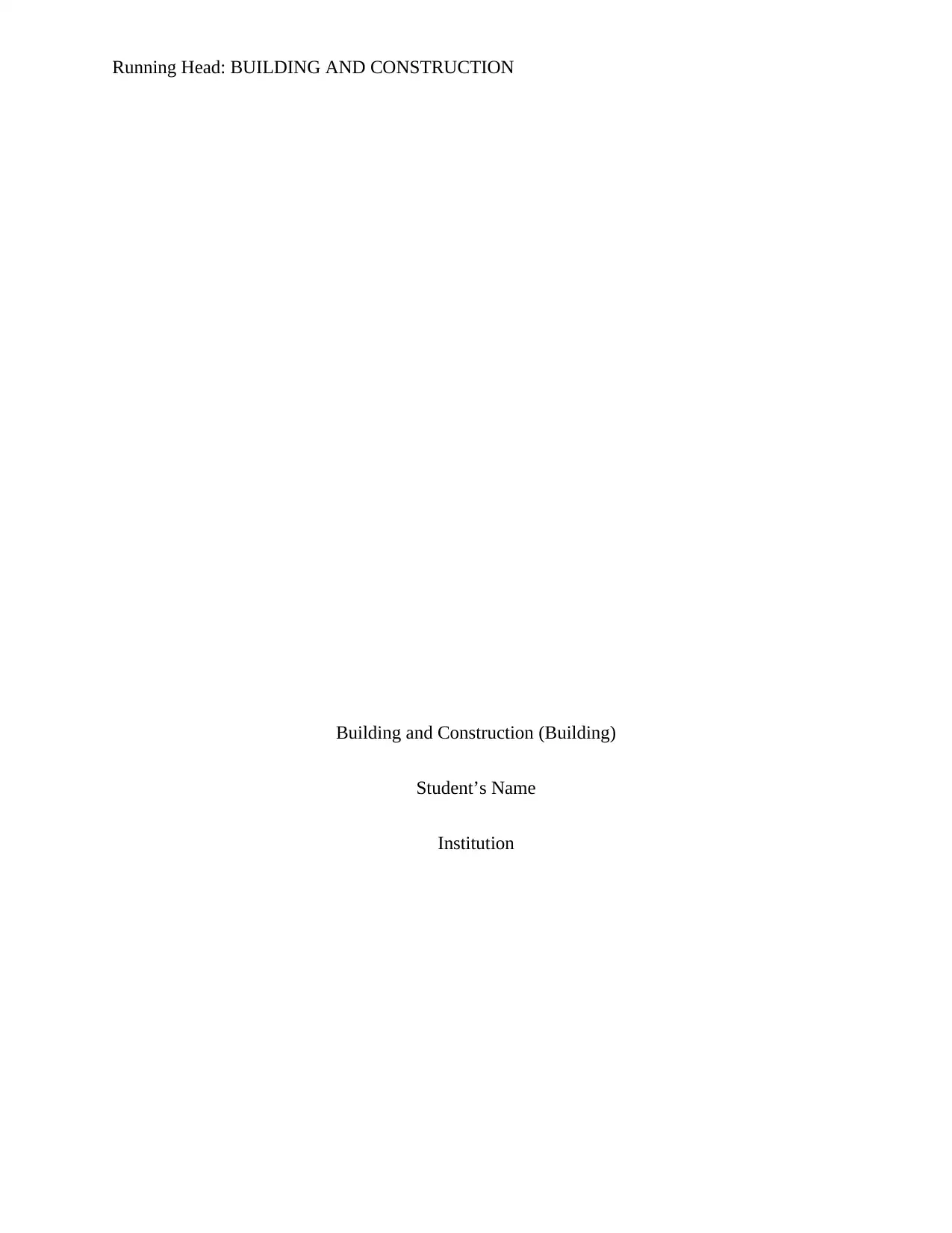
Running Head: BUILDING AND CONSTRUCTION
Building and Construction (Building)
Student’s Name
Institution
Building and Construction (Building)
Student’s Name
Institution
Secure Best Marks with AI Grader
Need help grading? Try our AI Grader for instant feedback on your assignments.
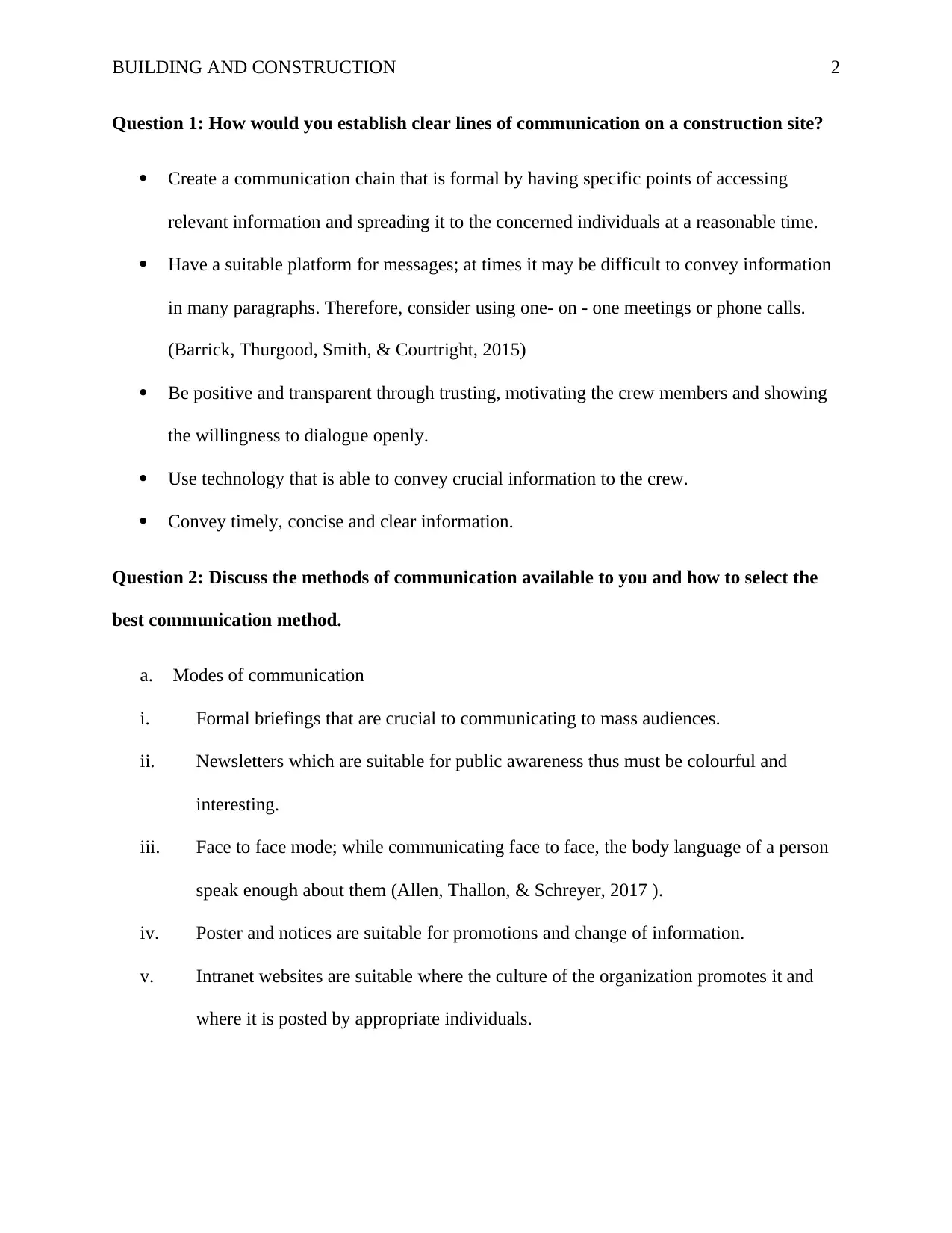
BUILDING AND CONSTRUCTION 2
Question 1: How would you establish clear lines of communication on a construction site?
Create a communication chain that is formal by having specific points of accessing
relevant information and spreading it to the concerned individuals at a reasonable time.
Have a suitable platform for messages; at times it may be difficult to convey information
in many paragraphs. Therefore, consider using one- on - one meetings or phone calls.
(Barrick, Thurgood, Smith, & Courtright, 2015)
Be positive and transparent through trusting, motivating the crew members and showing
the willingness to dialogue openly.
Use technology that is able to convey crucial information to the crew.
Convey timely, concise and clear information.
Question 2: Discuss the methods of communication available to you and how to select the
best communication method.
a. Modes of communication
i. Formal briefings that are crucial to communicating to mass audiences.
ii. Newsletters which are suitable for public awareness thus must be colourful and
interesting.
iii. Face to face mode; while communicating face to face, the body language of a person
speak enough about them (Allen, Thallon, & Schreyer, 2017 ).
iv. Poster and notices are suitable for promotions and change of information.
v. Intranet websites are suitable where the culture of the organization promotes it and
where it is posted by appropriate individuals.
Question 1: How would you establish clear lines of communication on a construction site?
Create a communication chain that is formal by having specific points of accessing
relevant information and spreading it to the concerned individuals at a reasonable time.
Have a suitable platform for messages; at times it may be difficult to convey information
in many paragraphs. Therefore, consider using one- on - one meetings or phone calls.
(Barrick, Thurgood, Smith, & Courtright, 2015)
Be positive and transparent through trusting, motivating the crew members and showing
the willingness to dialogue openly.
Use technology that is able to convey crucial information to the crew.
Convey timely, concise and clear information.
Question 2: Discuss the methods of communication available to you and how to select the
best communication method.
a. Modes of communication
i. Formal briefings that are crucial to communicating to mass audiences.
ii. Newsletters which are suitable for public awareness thus must be colourful and
interesting.
iii. Face to face mode; while communicating face to face, the body language of a person
speak enough about them (Allen, Thallon, & Schreyer, 2017 ).
iv. Poster and notices are suitable for promotions and change of information.
v. Intranet websites are suitable where the culture of the organization promotes it and
where it is posted by appropriate individuals.
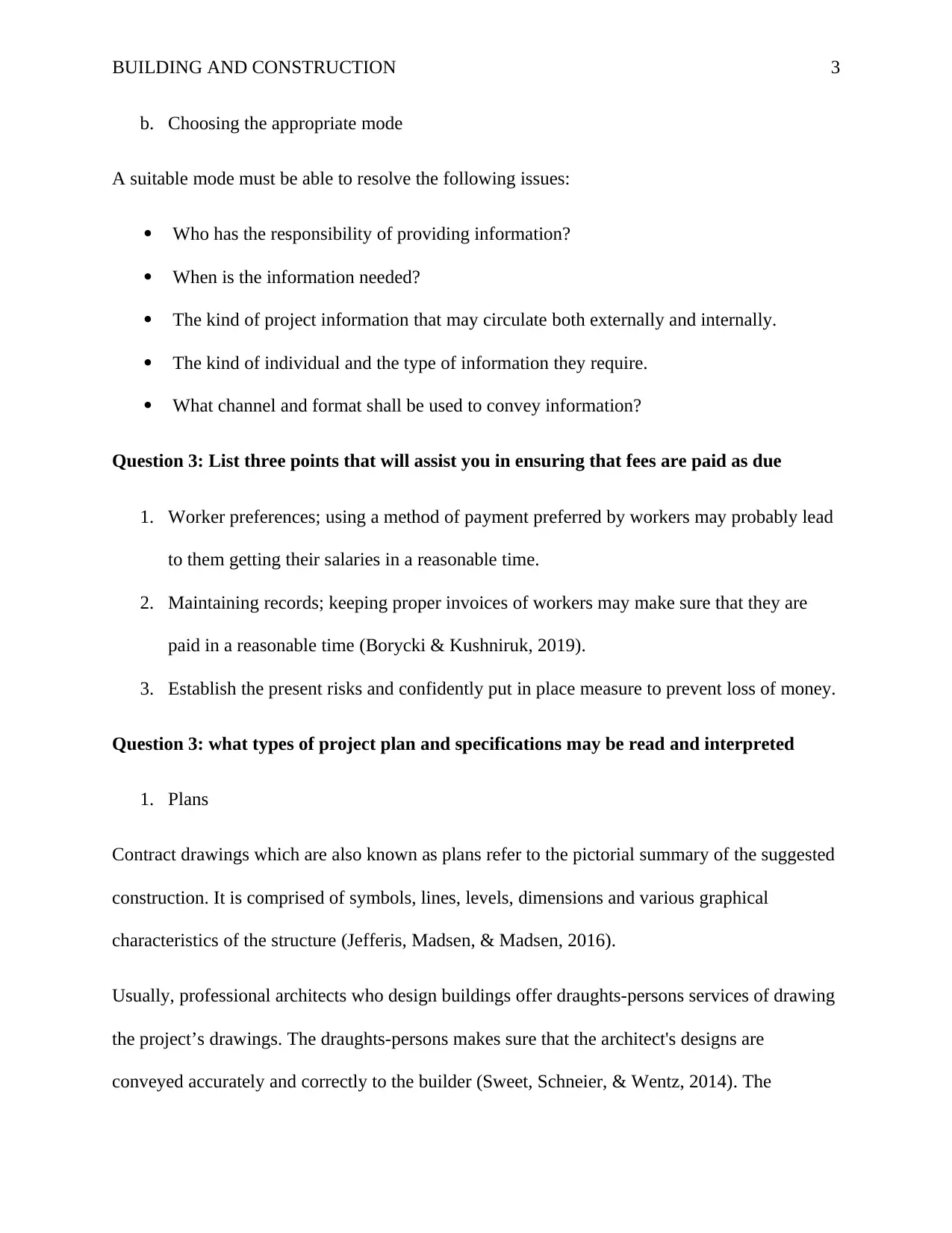
BUILDING AND CONSTRUCTION 3
b. Choosing the appropriate mode
A suitable mode must be able to resolve the following issues:
Who has the responsibility of providing information?
When is the information needed?
The kind of project information that may circulate both externally and internally.
The kind of individual and the type of information they require.
What channel and format shall be used to convey information?
Question 3: List three points that will assist you in ensuring that fees are paid as due
1. Worker preferences; using a method of payment preferred by workers may probably lead
to them getting their salaries in a reasonable time.
2. Maintaining records; keeping proper invoices of workers may make sure that they are
paid in a reasonable time (Borycki & Kushniruk, 2019).
3. Establish the present risks and confidently put in place measure to prevent loss of money.
Question 3: what types of project plan and specifications may be read and interpreted
1. Plans
Contract drawings which are also known as plans refer to the pictorial summary of the suggested
construction. It is comprised of symbols, lines, levels, dimensions and various graphical
characteristics of the structure (Jefferis, Madsen, & Madsen, 2016).
Usually, professional architects who design buildings offer draughts-persons services of drawing
the project’s drawings. The draughts-persons makes sure that the architect's designs are
conveyed accurately and correctly to the builder (Sweet, Schneier, & Wentz, 2014). The
b. Choosing the appropriate mode
A suitable mode must be able to resolve the following issues:
Who has the responsibility of providing information?
When is the information needed?
The kind of project information that may circulate both externally and internally.
The kind of individual and the type of information they require.
What channel and format shall be used to convey information?
Question 3: List three points that will assist you in ensuring that fees are paid as due
1. Worker preferences; using a method of payment preferred by workers may probably lead
to them getting their salaries in a reasonable time.
2. Maintaining records; keeping proper invoices of workers may make sure that they are
paid in a reasonable time (Borycki & Kushniruk, 2019).
3. Establish the present risks and confidently put in place measure to prevent loss of money.
Question 3: what types of project plan and specifications may be read and interpreted
1. Plans
Contract drawings which are also known as plans refer to the pictorial summary of the suggested
construction. It is comprised of symbols, lines, levels, dimensions and various graphical
characteristics of the structure (Jefferis, Madsen, & Madsen, 2016).
Usually, professional architects who design buildings offer draughts-persons services of drawing
the project’s drawings. The draughts-persons makes sure that the architect's designs are
conveyed accurately and correctly to the builder (Sweet, Schneier, & Wentz, 2014). The
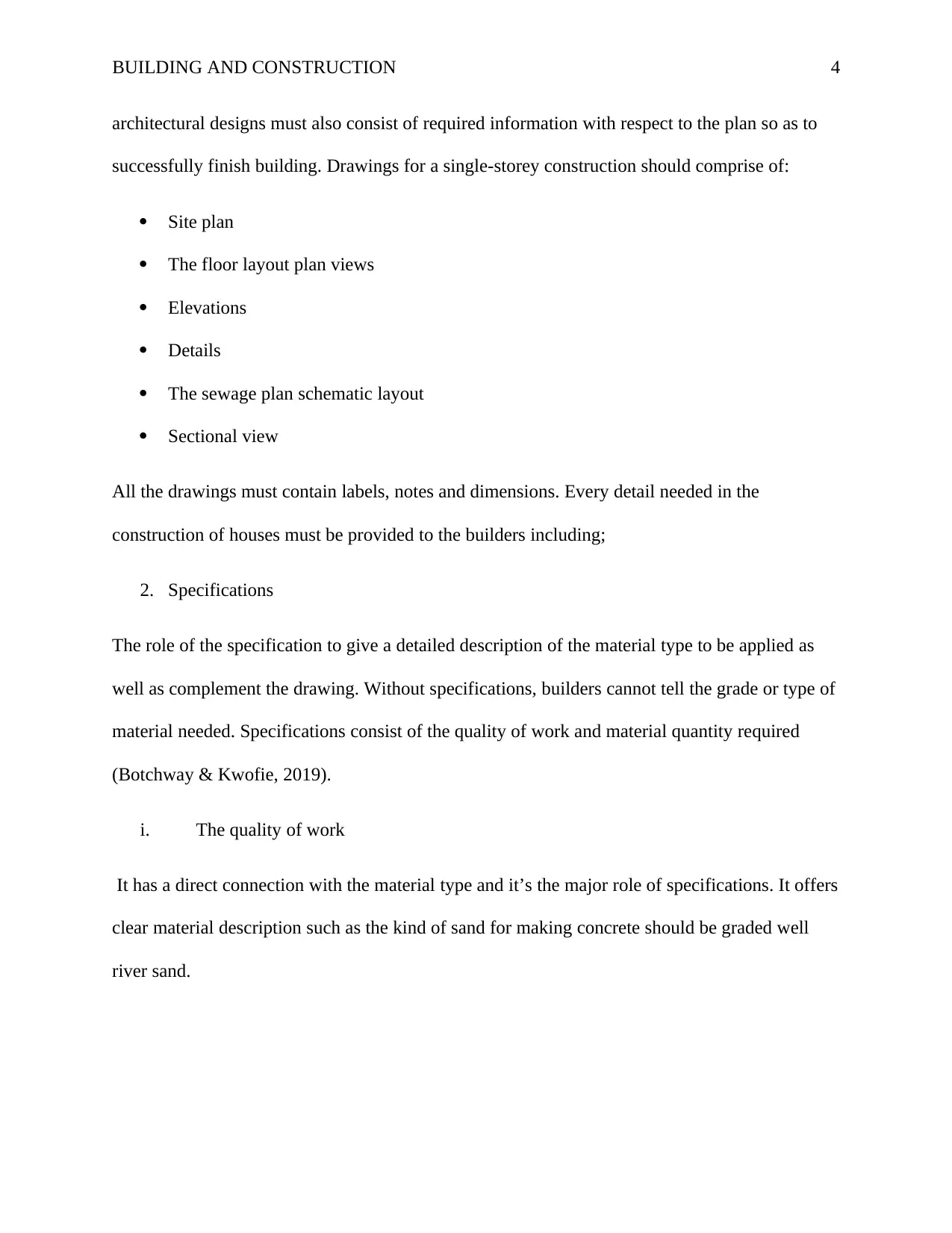
BUILDING AND CONSTRUCTION 4
architectural designs must also consist of required information with respect to the plan so as to
successfully finish building. Drawings for a single-storey construction should comprise of:
Site plan
The floor layout plan views
Elevations
Details
The sewage plan schematic layout
Sectional view
All the drawings must contain labels, notes and dimensions. Every detail needed in the
construction of houses must be provided to the builders including;
2. Specifications
The role of the specification to give a detailed description of the material type to be applied as
well as complement the drawing. Without specifications, builders cannot tell the grade or type of
material needed. Specifications consist of the quality of work and material quantity required
(Botchway & Kwofie, 2019).
i. The quality of work
It has a direct connection with the material type and it’s the major role of specifications. It offers
clear material description such as the kind of sand for making concrete should be graded well
river sand.
architectural designs must also consist of required information with respect to the plan so as to
successfully finish building. Drawings for a single-storey construction should comprise of:
Site plan
The floor layout plan views
Elevations
Details
The sewage plan schematic layout
Sectional view
All the drawings must contain labels, notes and dimensions. Every detail needed in the
construction of houses must be provided to the builders including;
2. Specifications
The role of the specification to give a detailed description of the material type to be applied as
well as complement the drawing. Without specifications, builders cannot tell the grade or type of
material needed. Specifications consist of the quality of work and material quantity required
(Botchway & Kwofie, 2019).
i. The quality of work
It has a direct connection with the material type and it’s the major role of specifications. It offers
clear material description such as the kind of sand for making concrete should be graded well
river sand.
Secure Best Marks with AI Grader
Need help grading? Try our AI Grader for instant feedback on your assignments.
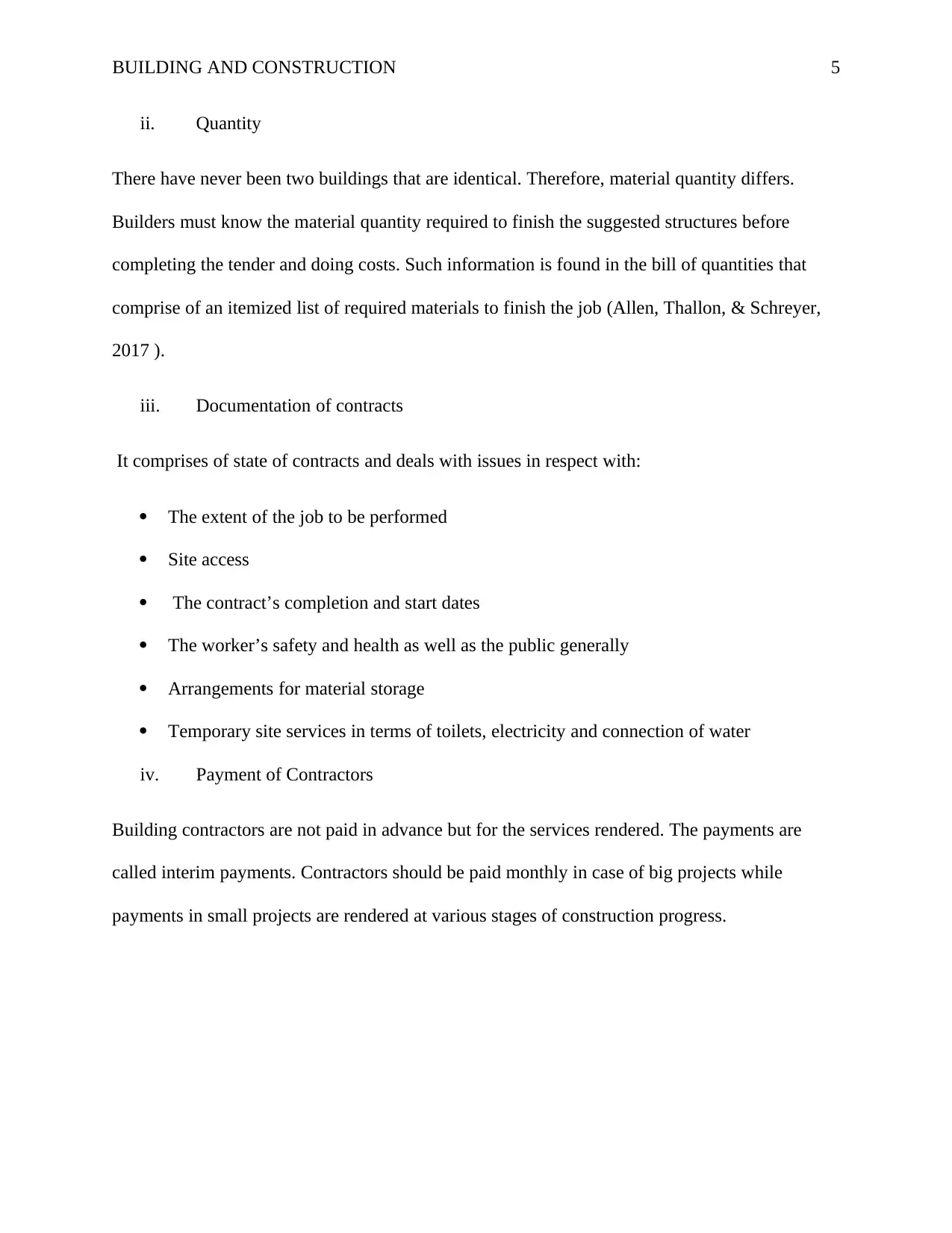
BUILDING AND CONSTRUCTION 5
ii. Quantity
There have never been two buildings that are identical. Therefore, material quantity differs.
Builders must know the material quantity required to finish the suggested structures before
completing the tender and doing costs. Such information is found in the bill of quantities that
comprise of an itemized list of required materials to finish the job (Allen, Thallon, & Schreyer,
2017 ).
iii. Documentation of contracts
It comprises of state of contracts and deals with issues in respect with:
The extent of the job to be performed
Site access
The contract’s completion and start dates
The worker’s safety and health as well as the public generally
Arrangements for material storage
Temporary site services in terms of toilets, electricity and connection of water
iv. Payment of Contractors
Building contractors are not paid in advance but for the services rendered. The payments are
called interim payments. Contractors should be paid monthly in case of big projects while
payments in small projects are rendered at various stages of construction progress.
ii. Quantity
There have never been two buildings that are identical. Therefore, material quantity differs.
Builders must know the material quantity required to finish the suggested structures before
completing the tender and doing costs. Such information is found in the bill of quantities that
comprise of an itemized list of required materials to finish the job (Allen, Thallon, & Schreyer,
2017 ).
iii. Documentation of contracts
It comprises of state of contracts and deals with issues in respect with:
The extent of the job to be performed
Site access
The contract’s completion and start dates
The worker’s safety and health as well as the public generally
Arrangements for material storage
Temporary site services in terms of toilets, electricity and connection of water
iv. Payment of Contractors
Building contractors are not paid in advance but for the services rendered. The payments are
called interim payments. Contractors should be paid monthly in case of big projects while
payments in small projects are rendered at various stages of construction progress.
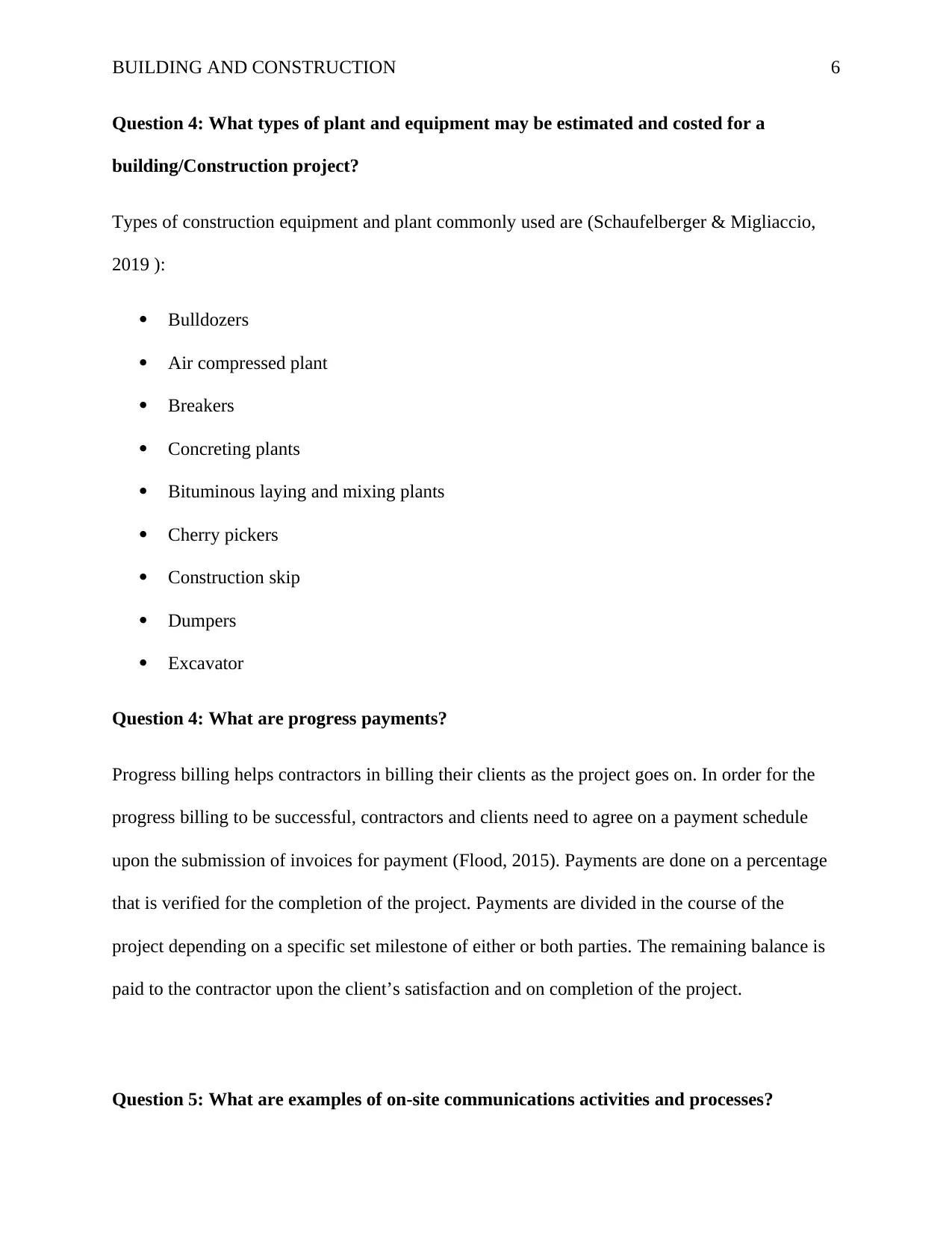
BUILDING AND CONSTRUCTION 6
Question 4: What types of plant and equipment may be estimated and costed for a
building/Construction project?
Types of construction equipment and plant commonly used are (Schaufelberger & Migliaccio,
2019 ):
Bulldozers
Air compressed plant
Breakers
Concreting plants
Bituminous laying and mixing plants
Cherry pickers
Construction skip
Dumpers
Excavator
Question 4: What are progress payments?
Progress billing helps contractors in billing their clients as the project goes on. In order for the
progress billing to be successful, contractors and clients need to agree on a payment schedule
upon the submission of invoices for payment (Flood, 2015). Payments are done on a percentage
that is verified for the completion of the project. Payments are divided in the course of the
project depending on a specific set milestone of either or both parties. The remaining balance is
paid to the contractor upon the client’s satisfaction and on completion of the project.
Question 5: What are examples of on-site communications activities and processes?
Question 4: What types of plant and equipment may be estimated and costed for a
building/Construction project?
Types of construction equipment and plant commonly used are (Schaufelberger & Migliaccio,
2019 ):
Bulldozers
Air compressed plant
Breakers
Concreting plants
Bituminous laying and mixing plants
Cherry pickers
Construction skip
Dumpers
Excavator
Question 4: What are progress payments?
Progress billing helps contractors in billing their clients as the project goes on. In order for the
progress billing to be successful, contractors and clients need to agree on a payment schedule
upon the submission of invoices for payment (Flood, 2015). Payments are done on a percentage
that is verified for the completion of the project. Payments are divided in the course of the
project depending on a specific set milestone of either or both parties. The remaining balance is
paid to the contractor upon the client’s satisfaction and on completion of the project.
Question 5: What are examples of on-site communications activities and processes?
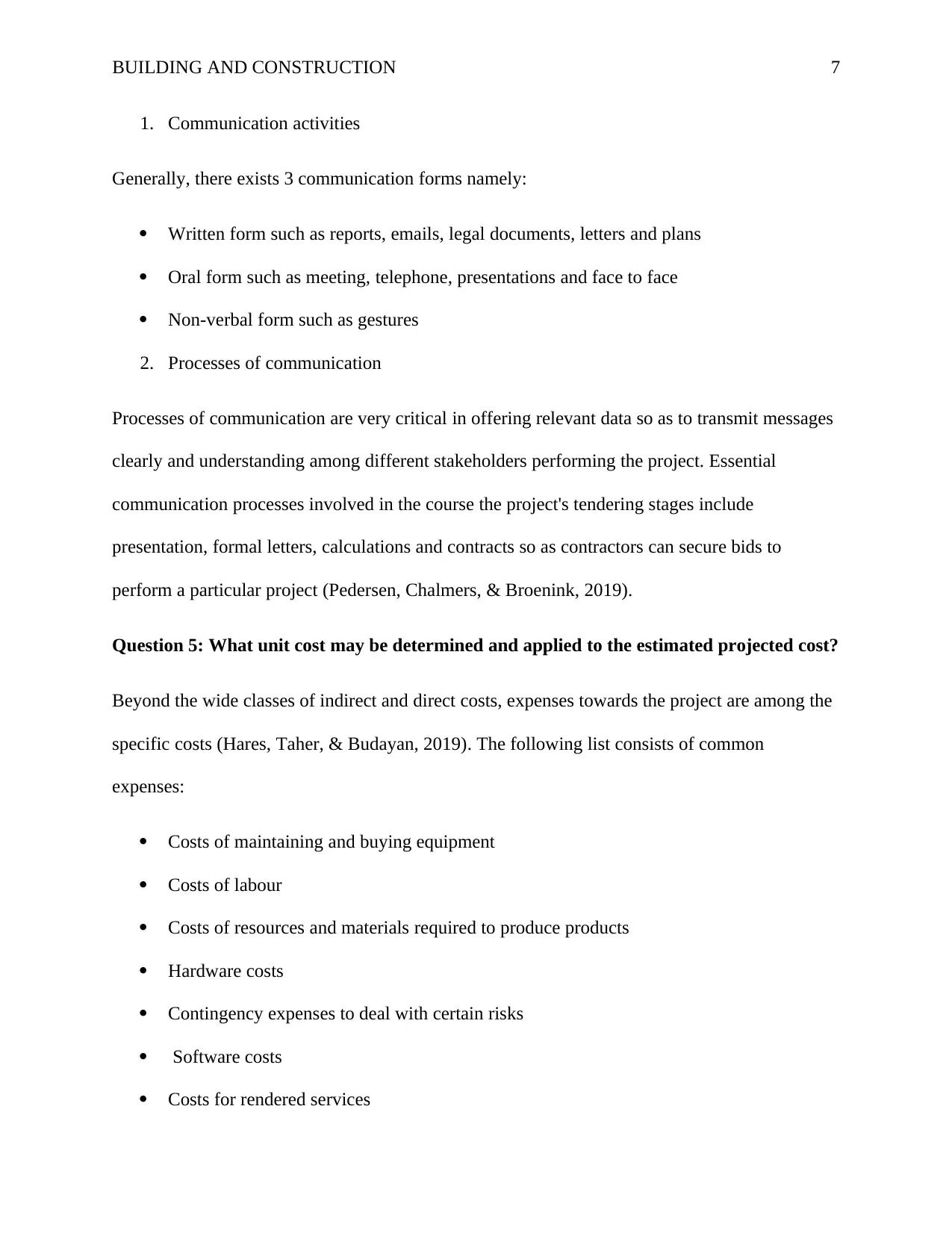
BUILDING AND CONSTRUCTION 7
1. Communication activities
Generally, there exists 3 communication forms namely:
Written form such as reports, emails, legal documents, letters and plans
Oral form such as meeting, telephone, presentations and face to face
Non-verbal form such as gestures
2. Processes of communication
Processes of communication are very critical in offering relevant data so as to transmit messages
clearly and understanding among different stakeholders performing the project. Essential
communication processes involved in the course the project's tendering stages include
presentation, formal letters, calculations and contracts so as contractors can secure bids to
perform a particular project (Pedersen, Chalmers, & Broenink, 2019).
Question 5: What unit cost may be determined and applied to the estimated projected cost?
Beyond the wide classes of indirect and direct costs, expenses towards the project are among the
specific costs (Hares, Taher, & Budayan, 2019). The following list consists of common
expenses:
Costs of maintaining and buying equipment
Costs of labour
Costs of resources and materials required to produce products
Hardware costs
Contingency expenses to deal with certain risks
Software costs
Costs for rendered services
1. Communication activities
Generally, there exists 3 communication forms namely:
Written form such as reports, emails, legal documents, letters and plans
Oral form such as meeting, telephone, presentations and face to face
Non-verbal form such as gestures
2. Processes of communication
Processes of communication are very critical in offering relevant data so as to transmit messages
clearly and understanding among different stakeholders performing the project. Essential
communication processes involved in the course the project's tendering stages include
presentation, formal letters, calculations and contracts so as contractors can secure bids to
perform a particular project (Pedersen, Chalmers, & Broenink, 2019).
Question 5: What unit cost may be determined and applied to the estimated projected cost?
Beyond the wide classes of indirect and direct costs, expenses towards the project are among the
specific costs (Hares, Taher, & Budayan, 2019). The following list consists of common
expenses:
Costs of maintaining and buying equipment
Costs of labour
Costs of resources and materials required to produce products
Hardware costs
Contingency expenses to deal with certain risks
Software costs
Costs for rendered services
Paraphrase This Document
Need a fresh take? Get an instant paraphrase of this document with our AI Paraphraser
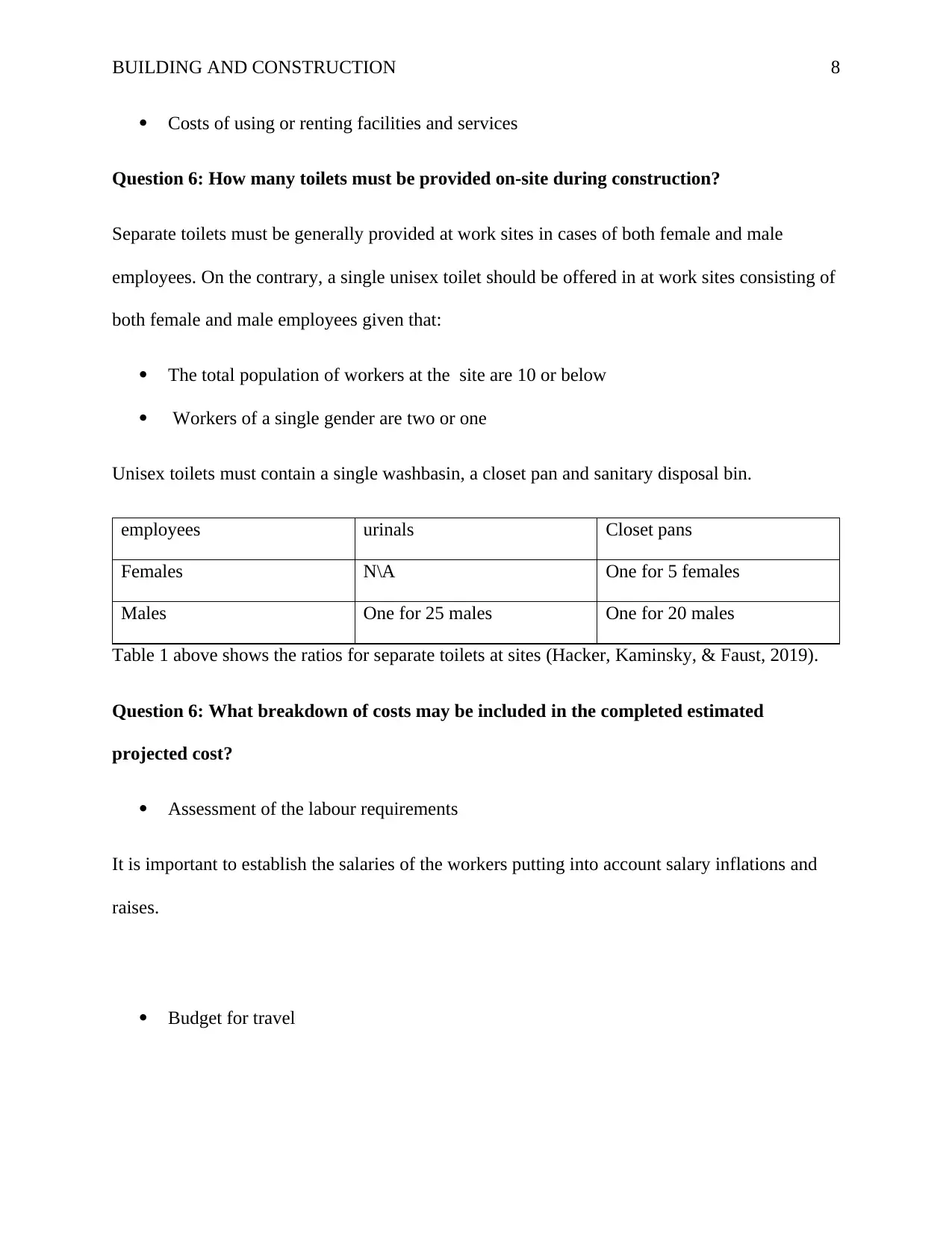
BUILDING AND CONSTRUCTION 8
Costs of using or renting facilities and services
Question 6: How many toilets must be provided on-site during construction?
Separate toilets must be generally provided at work sites in cases of both female and male
employees. On the contrary, a single unisex toilet should be offered in at work sites consisting of
both female and male employees given that:
The total population of workers at the site are 10 or below
Workers of a single gender are two or one
Unisex toilets must contain a single washbasin, a closet pan and sanitary disposal bin.
employees urinals Closet pans
Females N\A One for 5 females
Males One for 25 males One for 20 males
Table 1 above shows the ratios for separate toilets at sites (Hacker, Kaminsky, & Faust, 2019).
Question 6: What breakdown of costs may be included in the completed estimated
projected cost?
Assessment of the labour requirements
It is important to establish the salaries of the workers putting into account salary inflations and
raises.
Budget for travel
Costs of using or renting facilities and services
Question 6: How many toilets must be provided on-site during construction?
Separate toilets must be generally provided at work sites in cases of both female and male
employees. On the contrary, a single unisex toilet should be offered in at work sites consisting of
both female and male employees given that:
The total population of workers at the site are 10 or below
Workers of a single gender are two or one
Unisex toilets must contain a single washbasin, a closet pan and sanitary disposal bin.
employees urinals Closet pans
Females N\A One for 5 females
Males One for 25 males One for 20 males
Table 1 above shows the ratios for separate toilets at sites (Hacker, Kaminsky, & Faust, 2019).
Question 6: What breakdown of costs may be included in the completed estimated
projected cost?
Assessment of the labour requirements
It is important to establish the salaries of the workers putting into account salary inflations and
raises.
Budget for travel
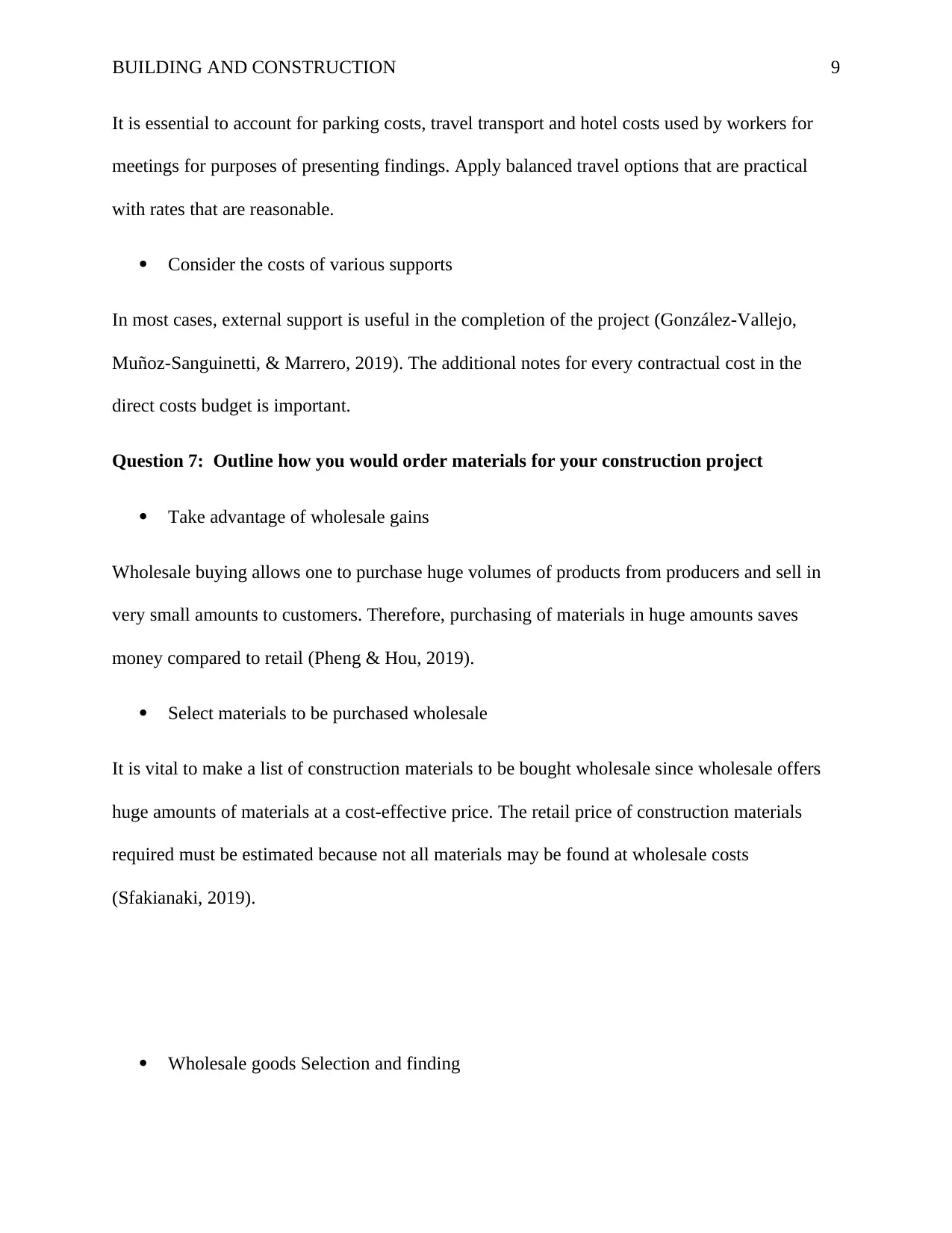
BUILDING AND CONSTRUCTION 9
It is essential to account for parking costs, travel transport and hotel costs used by workers for
meetings for purposes of presenting findings. Apply balanced travel options that are practical
with rates that are reasonable.
Consider the costs of various supports
In most cases, external support is useful in the completion of the project (González-Vallejo,
Muñoz-Sanguinetti, & Marrero, 2019). The additional notes for every contractual cost in the
direct costs budget is important.
Question 7: Outline how you would order materials for your construction project
Take advantage of wholesale gains
Wholesale buying allows one to purchase huge volumes of products from producers and sell in
very small amounts to customers. Therefore, purchasing of materials in huge amounts saves
money compared to retail (Pheng & Hou, 2019).
Select materials to be purchased wholesale
It is vital to make a list of construction materials to be bought wholesale since wholesale offers
huge amounts of materials at a cost-effective price. The retail price of construction materials
required must be estimated because not all materials may be found at wholesale costs
(Sfakianaki, 2019).
Wholesale goods Selection and finding
It is essential to account for parking costs, travel transport and hotel costs used by workers for
meetings for purposes of presenting findings. Apply balanced travel options that are practical
with rates that are reasonable.
Consider the costs of various supports
In most cases, external support is useful in the completion of the project (González-Vallejo,
Muñoz-Sanguinetti, & Marrero, 2019). The additional notes for every contractual cost in the
direct costs budget is important.
Question 7: Outline how you would order materials for your construction project
Take advantage of wholesale gains
Wholesale buying allows one to purchase huge volumes of products from producers and sell in
very small amounts to customers. Therefore, purchasing of materials in huge amounts saves
money compared to retail (Pheng & Hou, 2019).
Select materials to be purchased wholesale
It is vital to make a list of construction materials to be bought wholesale since wholesale offers
huge amounts of materials at a cost-effective price. The retail price of construction materials
required must be estimated because not all materials may be found at wholesale costs
(Sfakianaki, 2019).
Wholesale goods Selection and finding
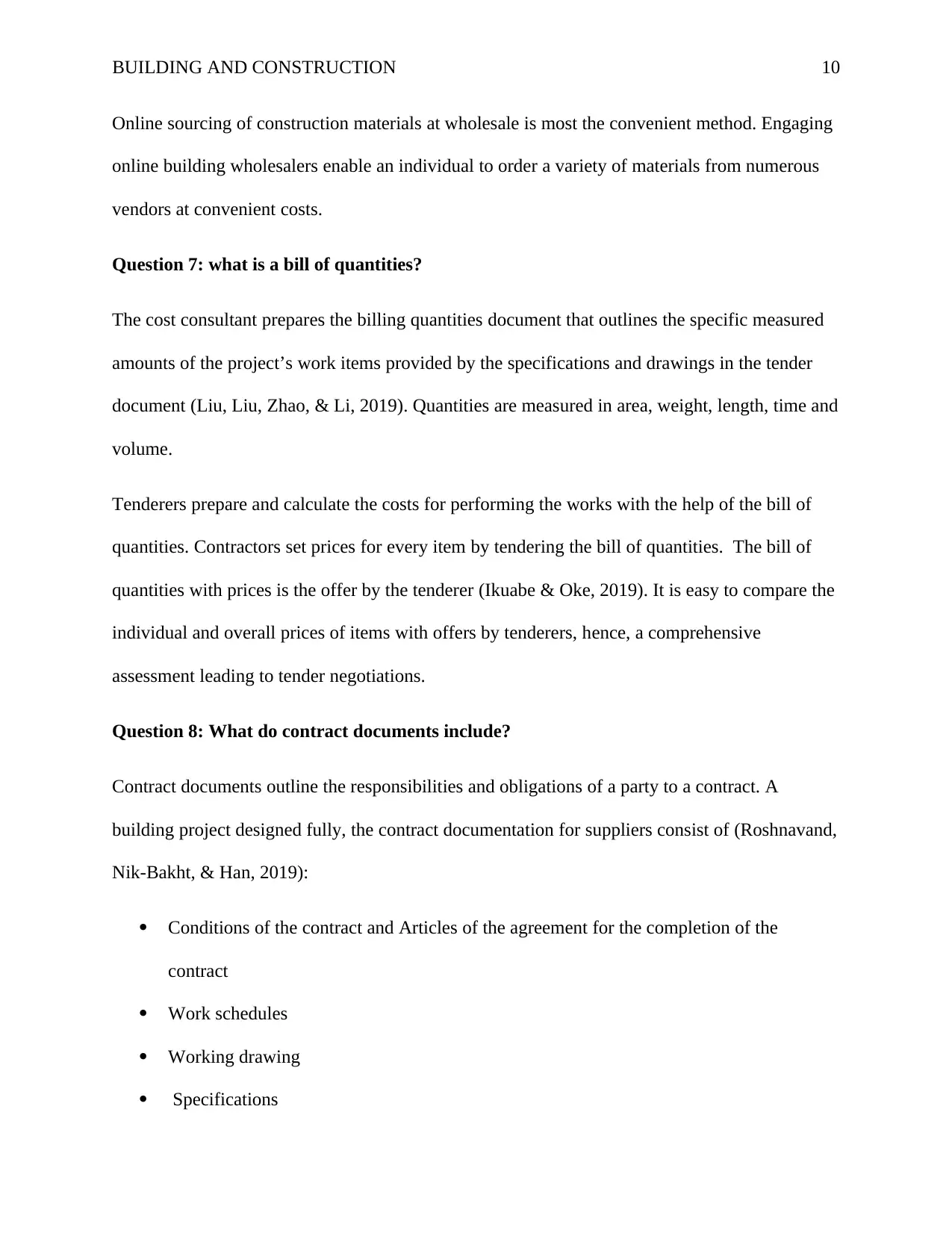
BUILDING AND CONSTRUCTION 10
Online sourcing of construction materials at wholesale is most the convenient method. Engaging
online building wholesalers enable an individual to order a variety of materials from numerous
vendors at convenient costs.
Question 7: what is a bill of quantities?
The cost consultant prepares the billing quantities document that outlines the specific measured
amounts of the project’s work items provided by the specifications and drawings in the tender
document (Liu, Liu, Zhao, & Li, 2019). Quantities are measured in area, weight, length, time and
volume.
Tenderers prepare and calculate the costs for performing the works with the help of the bill of
quantities. Contractors set prices for every item by tendering the bill of quantities. The bill of
quantities with prices is the offer by the tenderer (Ikuabe & Oke, 2019). It is easy to compare the
individual and overall prices of items with offers by tenderers, hence, a comprehensive
assessment leading to tender negotiations.
Question 8: What do contract documents include?
Contract documents outline the responsibilities and obligations of a party to a contract. A
building project designed fully, the contract documentation for suppliers consist of (Roshnavand,
Nik-Bakht, & Han, 2019):
Conditions of the contract and Articles of the agreement for the completion of the
contract
Work schedules
Working drawing
Specifications
Online sourcing of construction materials at wholesale is most the convenient method. Engaging
online building wholesalers enable an individual to order a variety of materials from numerous
vendors at convenient costs.
Question 7: what is a bill of quantities?
The cost consultant prepares the billing quantities document that outlines the specific measured
amounts of the project’s work items provided by the specifications and drawings in the tender
document (Liu, Liu, Zhao, & Li, 2019). Quantities are measured in area, weight, length, time and
volume.
Tenderers prepare and calculate the costs for performing the works with the help of the bill of
quantities. Contractors set prices for every item by tendering the bill of quantities. The bill of
quantities with prices is the offer by the tenderer (Ikuabe & Oke, 2019). It is easy to compare the
individual and overall prices of items with offers by tenderers, hence, a comprehensive
assessment leading to tender negotiations.
Question 8: What do contract documents include?
Contract documents outline the responsibilities and obligations of a party to a contract. A
building project designed fully, the contract documentation for suppliers consist of (Roshnavand,
Nik-Bakht, & Han, 2019):
Conditions of the contract and Articles of the agreement for the completion of the
contract
Work schedules
Working drawing
Specifications
Secure Best Marks with AI Grader
Need help grading? Try our AI Grader for instant feedback on your assignments.
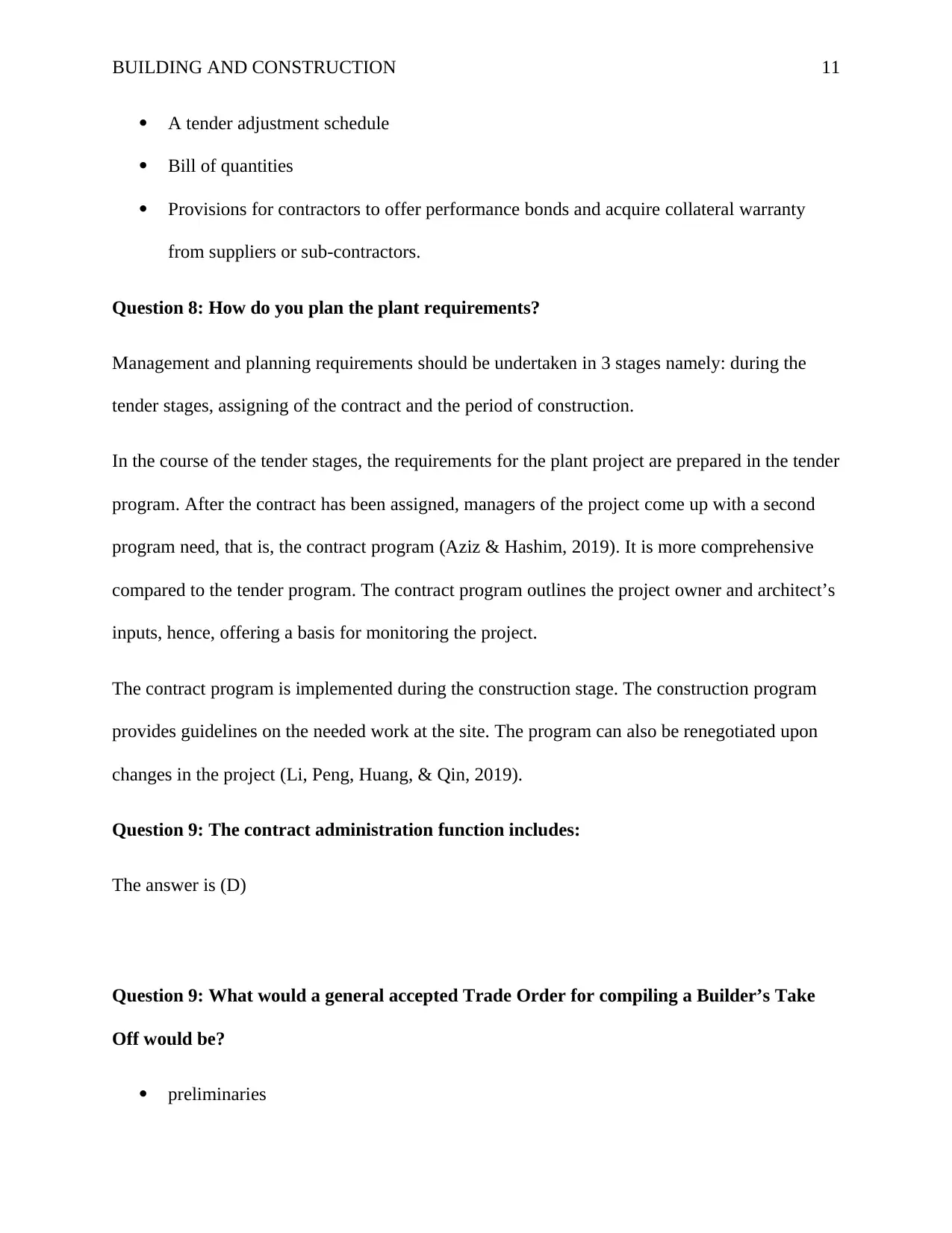
BUILDING AND CONSTRUCTION 11
A tender adjustment schedule
Bill of quantities
Provisions for contractors to offer performance bonds and acquire collateral warranty
from suppliers or sub-contractors.
Question 8: How do you plan the plant requirements?
Management and planning requirements should be undertaken in 3 stages namely: during the
tender stages, assigning of the contract and the period of construction.
In the course of the tender stages, the requirements for the plant project are prepared in the tender
program. After the contract has been assigned, managers of the project come up with a second
program need, that is, the contract program (Aziz & Hashim, 2019). It is more comprehensive
compared to the tender program. The contract program outlines the project owner and architect’s
inputs, hence, offering a basis for monitoring the project.
The contract program is implemented during the construction stage. The construction program
provides guidelines on the needed work at the site. The program can also be renegotiated upon
changes in the project (Li, Peng, Huang, & Qin, 2019).
Question 9: The contract administration function includes:
The answer is (D)
Question 9: What would a general accepted Trade Order for compiling a Builder’s Take
Off would be?
preliminaries
A tender adjustment schedule
Bill of quantities
Provisions for contractors to offer performance bonds and acquire collateral warranty
from suppliers or sub-contractors.
Question 8: How do you plan the plant requirements?
Management and planning requirements should be undertaken in 3 stages namely: during the
tender stages, assigning of the contract and the period of construction.
In the course of the tender stages, the requirements for the plant project are prepared in the tender
program. After the contract has been assigned, managers of the project come up with a second
program need, that is, the contract program (Aziz & Hashim, 2019). It is more comprehensive
compared to the tender program. The contract program outlines the project owner and architect’s
inputs, hence, offering a basis for monitoring the project.
The contract program is implemented during the construction stage. The construction program
provides guidelines on the needed work at the site. The program can also be renegotiated upon
changes in the project (Li, Peng, Huang, & Qin, 2019).
Question 9: The contract administration function includes:
The answer is (D)
Question 9: What would a general accepted Trade Order for compiling a Builder’s Take
Off would be?
preliminaries
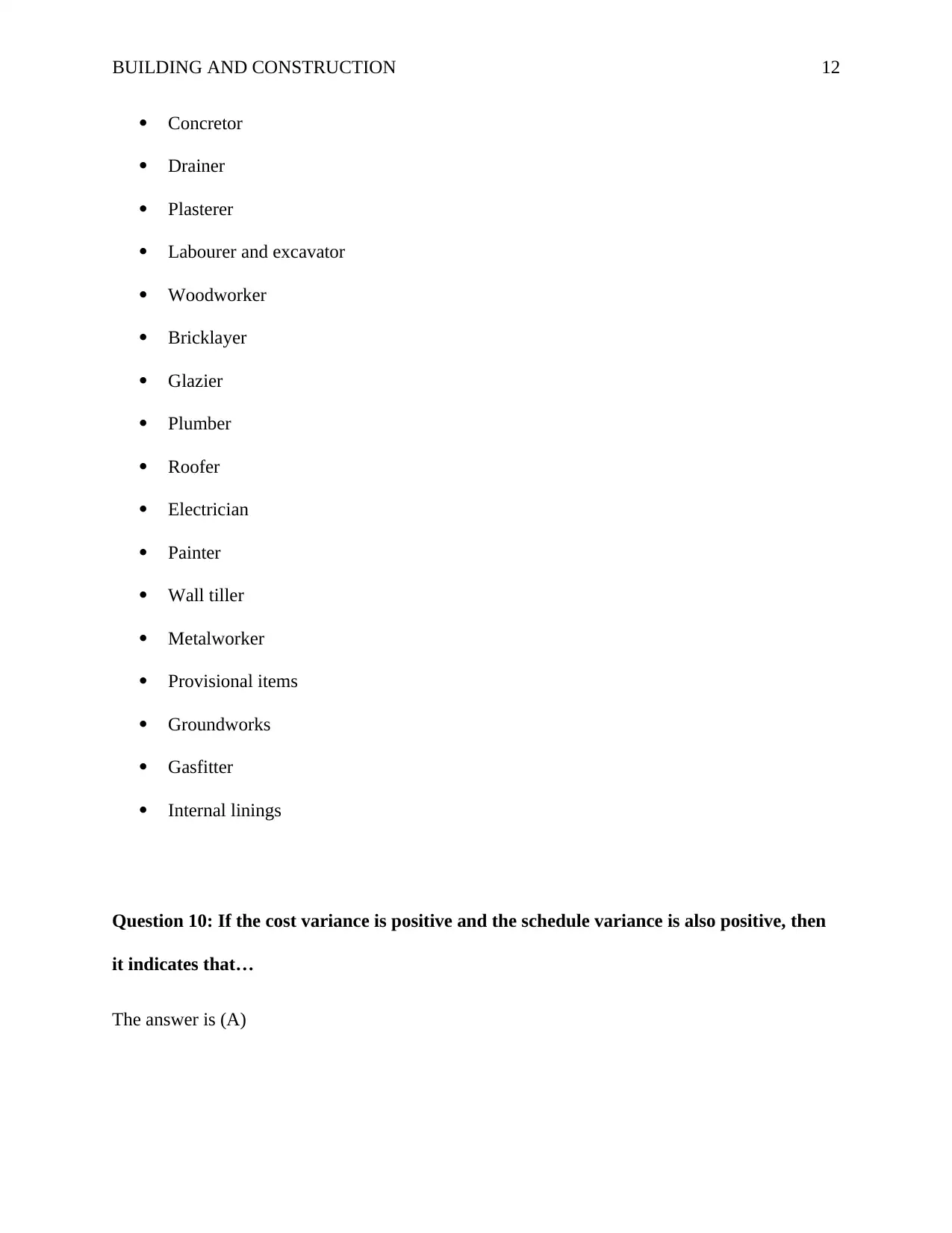
BUILDING AND CONSTRUCTION 12
Concretor
Drainer
Plasterer
Labourer and excavator
Woodworker
Bricklayer
Glazier
Plumber
Roofer
Electrician
Painter
Wall tiller
Metalworker
Provisional items
Groundworks
Gasfitter
Internal linings
Question 10: If the cost variance is positive and the schedule variance is also positive, then
it indicates that…
The answer is (A)
Concretor
Drainer
Plasterer
Labourer and excavator
Woodworker
Bricklayer
Glazier
Plumber
Roofer
Electrician
Painter
Wall tiller
Metalworker
Provisional items
Groundworks
Gasfitter
Internal linings
Question 10: If the cost variance is positive and the schedule variance is also positive, then
it indicates that…
The answer is (A)
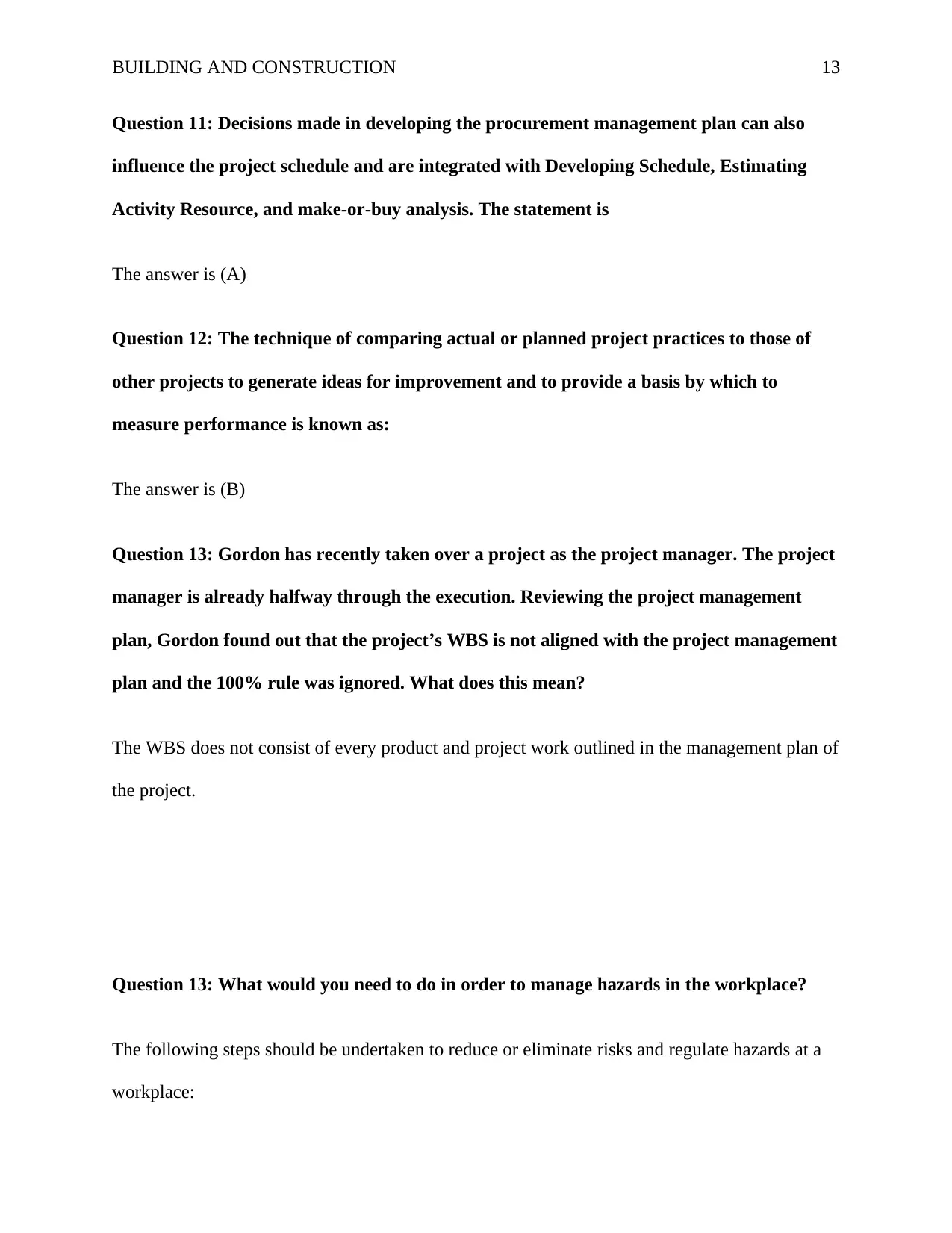
BUILDING AND CONSTRUCTION 13
Question 11: Decisions made in developing the procurement management plan can also
influence the project schedule and are integrated with Developing Schedule, Estimating
Activity Resource, and make-or-buy analysis. The statement is
The answer is (A)
Question 12: The technique of comparing actual or planned project practices to those of
other projects to generate ideas for improvement and to provide a basis by which to
measure performance is known as:
The answer is (B)
Question 13: Gordon has recently taken over a project as the project manager. The project
manager is already halfway through the execution. Reviewing the project management
plan, Gordon found out that the project’s WBS is not aligned with the project management
plan and the 100% rule was ignored. What does this mean?
The WBS does not consist of every product and project work outlined in the management plan of
the project.
Question 13: What would you need to do in order to manage hazards in the workplace?
The following steps should be undertaken to reduce or eliminate risks and regulate hazards at a
workplace:
Question 11: Decisions made in developing the procurement management plan can also
influence the project schedule and are integrated with Developing Schedule, Estimating
Activity Resource, and make-or-buy analysis. The statement is
The answer is (A)
Question 12: The technique of comparing actual or planned project practices to those of
other projects to generate ideas for improvement and to provide a basis by which to
measure performance is known as:
The answer is (B)
Question 13: Gordon has recently taken over a project as the project manager. The project
manager is already halfway through the execution. Reviewing the project management
plan, Gordon found out that the project’s WBS is not aligned with the project management
plan and the 100% rule was ignored. What does this mean?
The WBS does not consist of every product and project work outlined in the management plan of
the project.
Question 13: What would you need to do in order to manage hazards in the workplace?
The following steps should be undertaken to reduce or eliminate risks and regulate hazards at a
workplace:
Paraphrase This Document
Need a fresh take? Get an instant paraphrase of this document with our AI Paraphraser
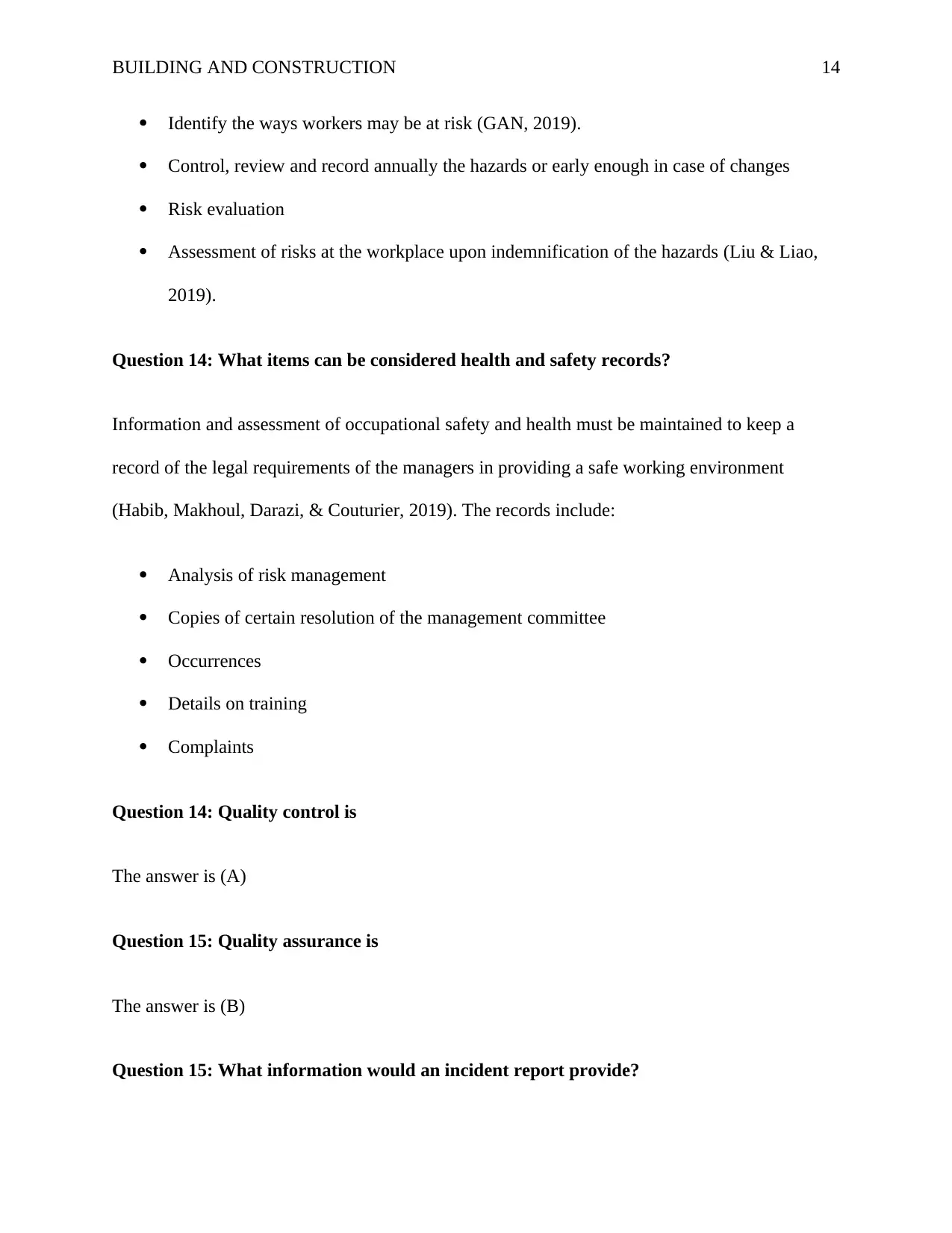
BUILDING AND CONSTRUCTION 14
Identify the ways workers may be at risk (GAN, 2019).
Control, review and record annually the hazards or early enough in case of changes
Risk evaluation
Assessment of risks at the workplace upon indemnification of the hazards (Liu & Liao,
2019).
Question 14: What items can be considered health and safety records?
Information and assessment of occupational safety and health must be maintained to keep a
record of the legal requirements of the managers in providing a safe working environment
(Habib, Makhoul, Darazi, & Couturier, 2019). The records include:
Analysis of risk management
Copies of certain resolution of the management committee
Occurrences
Details on training
Complaints
Question 14: Quality control is
The answer is (A)
Question 15: Quality assurance is
The answer is (B)
Question 15: What information would an incident report provide?
Identify the ways workers may be at risk (GAN, 2019).
Control, review and record annually the hazards or early enough in case of changes
Risk evaluation
Assessment of risks at the workplace upon indemnification of the hazards (Liu & Liao,
2019).
Question 14: What items can be considered health and safety records?
Information and assessment of occupational safety and health must be maintained to keep a
record of the legal requirements of the managers in providing a safe working environment
(Habib, Makhoul, Darazi, & Couturier, 2019). The records include:
Analysis of risk management
Copies of certain resolution of the management committee
Occurrences
Details on training
Complaints
Question 14: Quality control is
The answer is (A)
Question 15: Quality assurance is
The answer is (B)
Question 15: What information would an incident report provide?
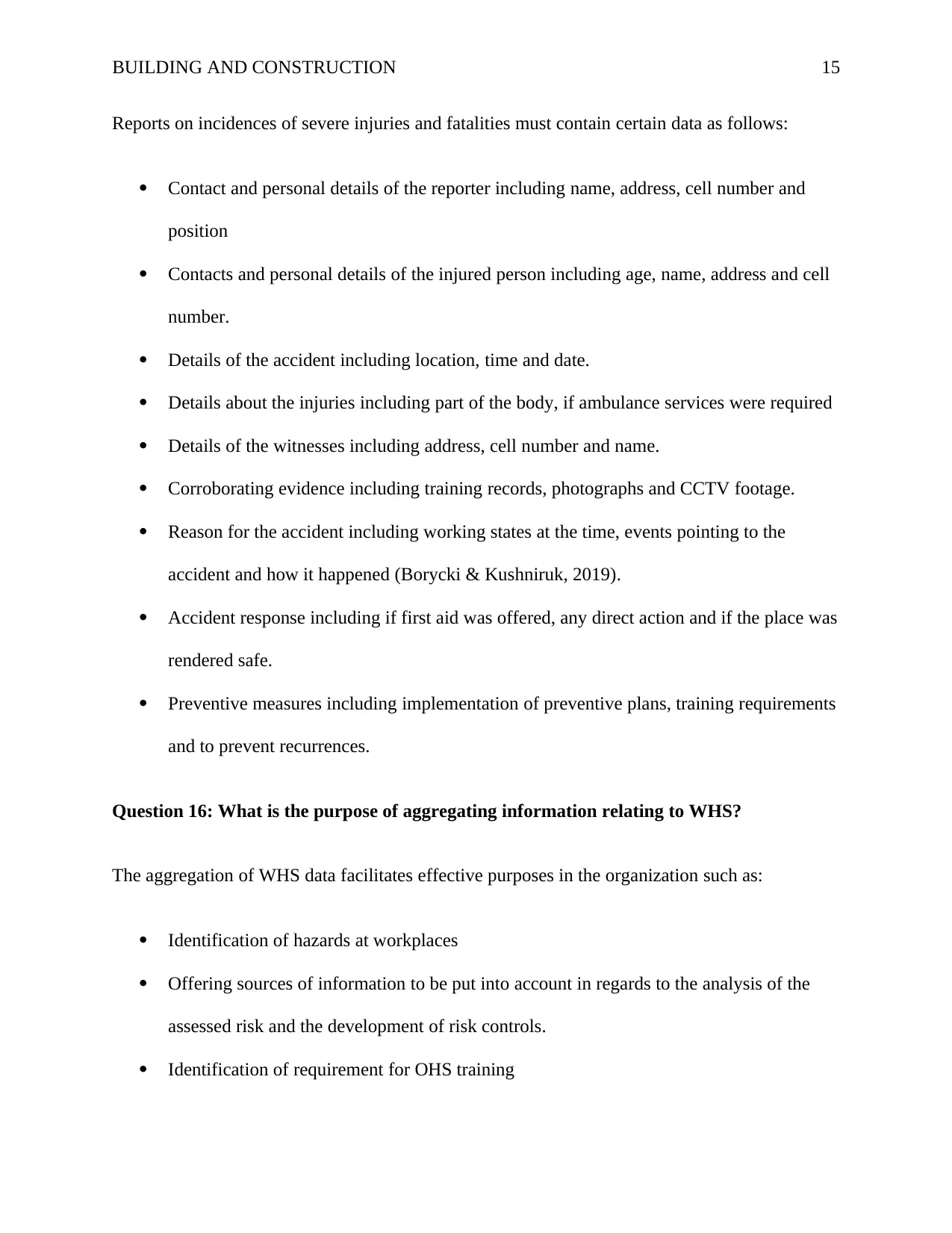
BUILDING AND CONSTRUCTION 15
Reports on incidences of severe injuries and fatalities must contain certain data as follows:
Contact and personal details of the reporter including name, address, cell number and
position
Contacts and personal details of the injured person including age, name, address and cell
number.
Details of the accident including location, time and date.
Details about the injuries including part of the body, if ambulance services were required
Details of the witnesses including address, cell number and name.
Corroborating evidence including training records, photographs and CCTV footage.
Reason for the accident including working states at the time, events pointing to the
accident and how it happened (Borycki & Kushniruk, 2019).
Accident response including if first aid was offered, any direct action and if the place was
rendered safe.
Preventive measures including implementation of preventive plans, training requirements
and to prevent recurrences.
Question 16: What is the purpose of aggregating information relating to WHS?
The aggregation of WHS data facilitates effective purposes in the organization such as:
Identification of hazards at workplaces
Offering sources of information to be put into account in regards to the analysis of the
assessed risk and the development of risk controls.
Identification of requirement for OHS training
Reports on incidences of severe injuries and fatalities must contain certain data as follows:
Contact and personal details of the reporter including name, address, cell number and
position
Contacts and personal details of the injured person including age, name, address and cell
number.
Details of the accident including location, time and date.
Details about the injuries including part of the body, if ambulance services were required
Details of the witnesses including address, cell number and name.
Corroborating evidence including training records, photographs and CCTV footage.
Reason for the accident including working states at the time, events pointing to the
accident and how it happened (Borycki & Kushniruk, 2019).
Accident response including if first aid was offered, any direct action and if the place was
rendered safe.
Preventive measures including implementation of preventive plans, training requirements
and to prevent recurrences.
Question 16: What is the purpose of aggregating information relating to WHS?
The aggregation of WHS data facilitates effective purposes in the organization such as:
Identification of hazards at workplaces
Offering sources of information to be put into account in regards to the analysis of the
assessed risk and the development of risk controls.
Identification of requirement for OHS training
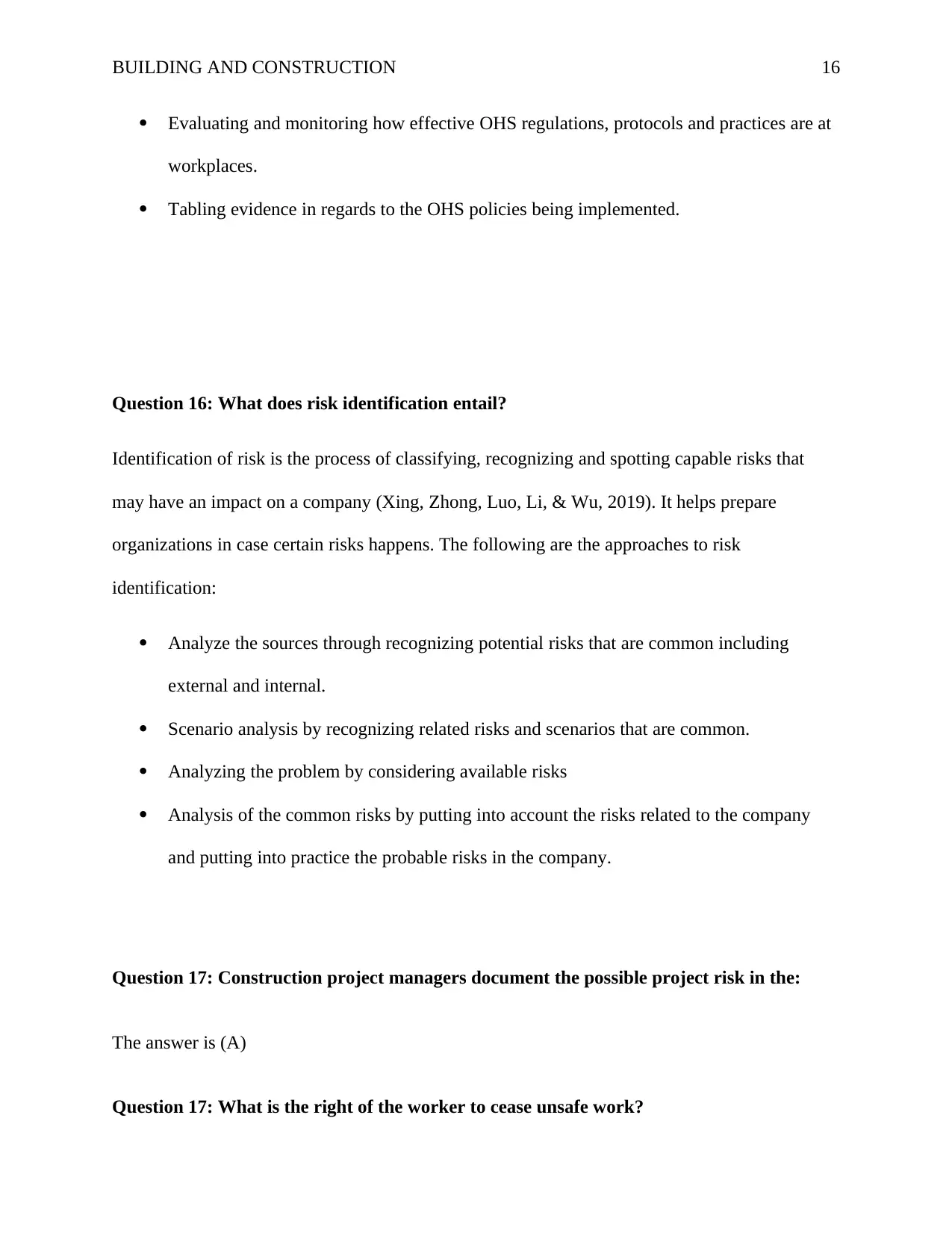
BUILDING AND CONSTRUCTION 16
Evaluating and monitoring how effective OHS regulations, protocols and practices are at
workplaces.
Tabling evidence in regards to the OHS policies being implemented.
Question 16: What does risk identification entail?
Identification of risk is the process of classifying, recognizing and spotting capable risks that
may have an impact on a company (Xing, Zhong, Luo, Li, & Wu, 2019). It helps prepare
organizations in case certain risks happens. The following are the approaches to risk
identification:
Analyze the sources through recognizing potential risks that are common including
external and internal.
Scenario analysis by recognizing related risks and scenarios that are common.
Analyzing the problem by considering available risks
Analysis of the common risks by putting into account the risks related to the company
and putting into practice the probable risks in the company.
Question 17: Construction project managers document the possible project risk in the:
The answer is (A)
Question 17: What is the right of the worker to cease unsafe work?
Evaluating and monitoring how effective OHS regulations, protocols and practices are at
workplaces.
Tabling evidence in regards to the OHS policies being implemented.
Question 16: What does risk identification entail?
Identification of risk is the process of classifying, recognizing and spotting capable risks that
may have an impact on a company (Xing, Zhong, Luo, Li, & Wu, 2019). It helps prepare
organizations in case certain risks happens. The following are the approaches to risk
identification:
Analyze the sources through recognizing potential risks that are common including
external and internal.
Scenario analysis by recognizing related risks and scenarios that are common.
Analyzing the problem by considering available risks
Analysis of the common risks by putting into account the risks related to the company
and putting into practice the probable risks in the company.
Question 17: Construction project managers document the possible project risk in the:
The answer is (A)
Question 17: What is the right of the worker to cease unsafe work?
Secure Best Marks with AI Grader
Need help grading? Try our AI Grader for instant feedback on your assignments.
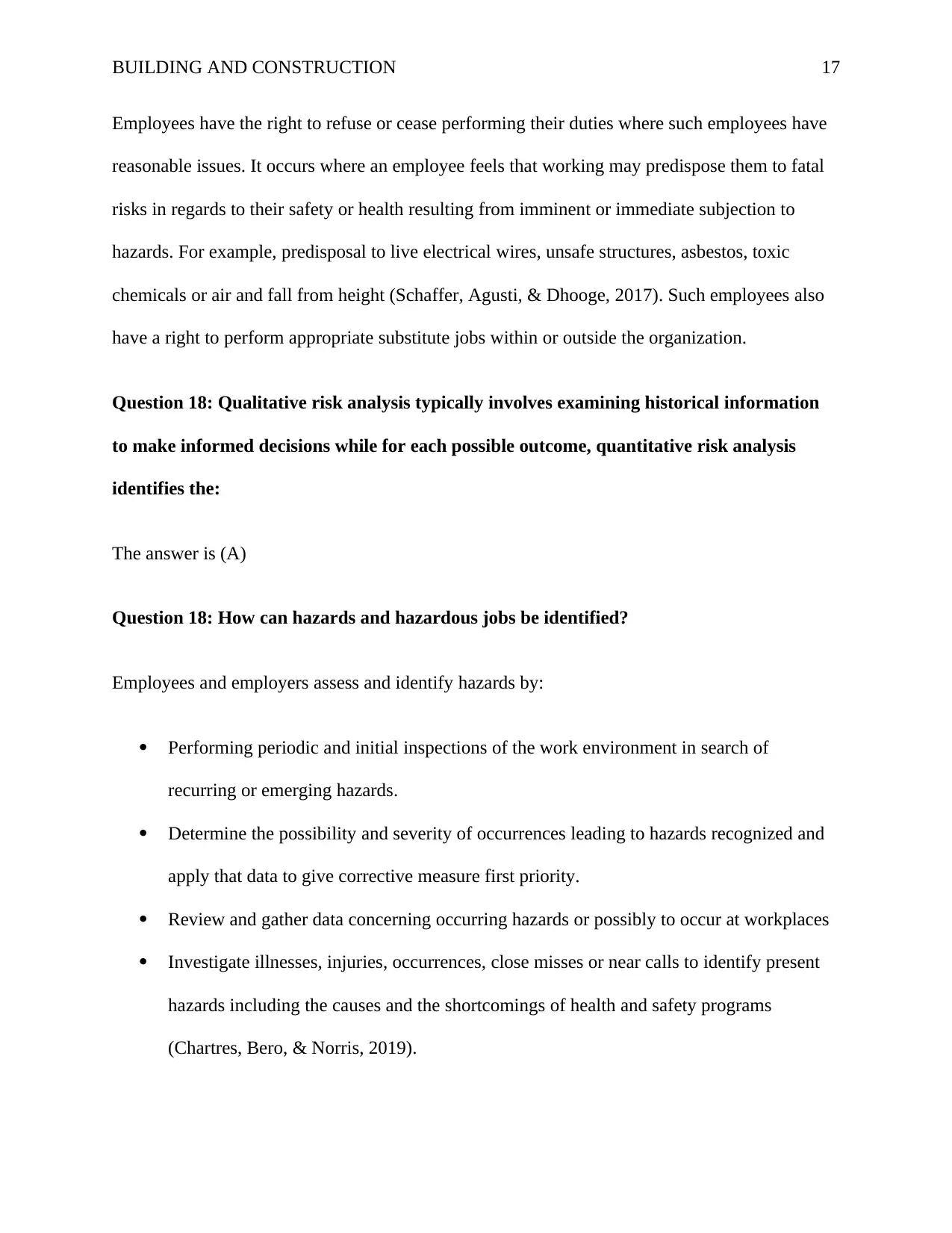
BUILDING AND CONSTRUCTION 17
Employees have the right to refuse or cease performing their duties where such employees have
reasonable issues. It occurs where an employee feels that working may predispose them to fatal
risks in regards to their safety or health resulting from imminent or immediate subjection to
hazards. For example, predisposal to live electrical wires, unsafe structures, asbestos, toxic
chemicals or air and fall from height (Schaffer, Agusti, & Dhooge, 2017). Such employees also
have a right to perform appropriate substitute jobs within or outside the organization.
Question 18: Qualitative risk analysis typically involves examining historical information
to make informed decisions while for each possible outcome, quantitative risk analysis
identifies the:
The answer is (A)
Question 18: How can hazards and hazardous jobs be identified?
Employees and employers assess and identify hazards by:
Performing periodic and initial inspections of the work environment in search of
recurring or emerging hazards.
Determine the possibility and severity of occurrences leading to hazards recognized and
apply that data to give corrective measure first priority.
Review and gather data concerning occurring hazards or possibly to occur at workplaces
Investigate illnesses, injuries, occurrences, close misses or near calls to identify present
hazards including the causes and the shortcomings of health and safety programs
(Chartres, Bero, & Norris, 2019).
Employees have the right to refuse or cease performing their duties where such employees have
reasonable issues. It occurs where an employee feels that working may predispose them to fatal
risks in regards to their safety or health resulting from imminent or immediate subjection to
hazards. For example, predisposal to live electrical wires, unsafe structures, asbestos, toxic
chemicals or air and fall from height (Schaffer, Agusti, & Dhooge, 2017). Such employees also
have a right to perform appropriate substitute jobs within or outside the organization.
Question 18: Qualitative risk analysis typically involves examining historical information
to make informed decisions while for each possible outcome, quantitative risk analysis
identifies the:
The answer is (A)
Question 18: How can hazards and hazardous jobs be identified?
Employees and employers assess and identify hazards by:
Performing periodic and initial inspections of the work environment in search of
recurring or emerging hazards.
Determine the possibility and severity of occurrences leading to hazards recognized and
apply that data to give corrective measure first priority.
Review and gather data concerning occurring hazards or possibly to occur at workplaces
Investigate illnesses, injuries, occurrences, close misses or near calls to identify present
hazards including the causes and the shortcomings of health and safety programs
(Chartres, Bero, & Norris, 2019).
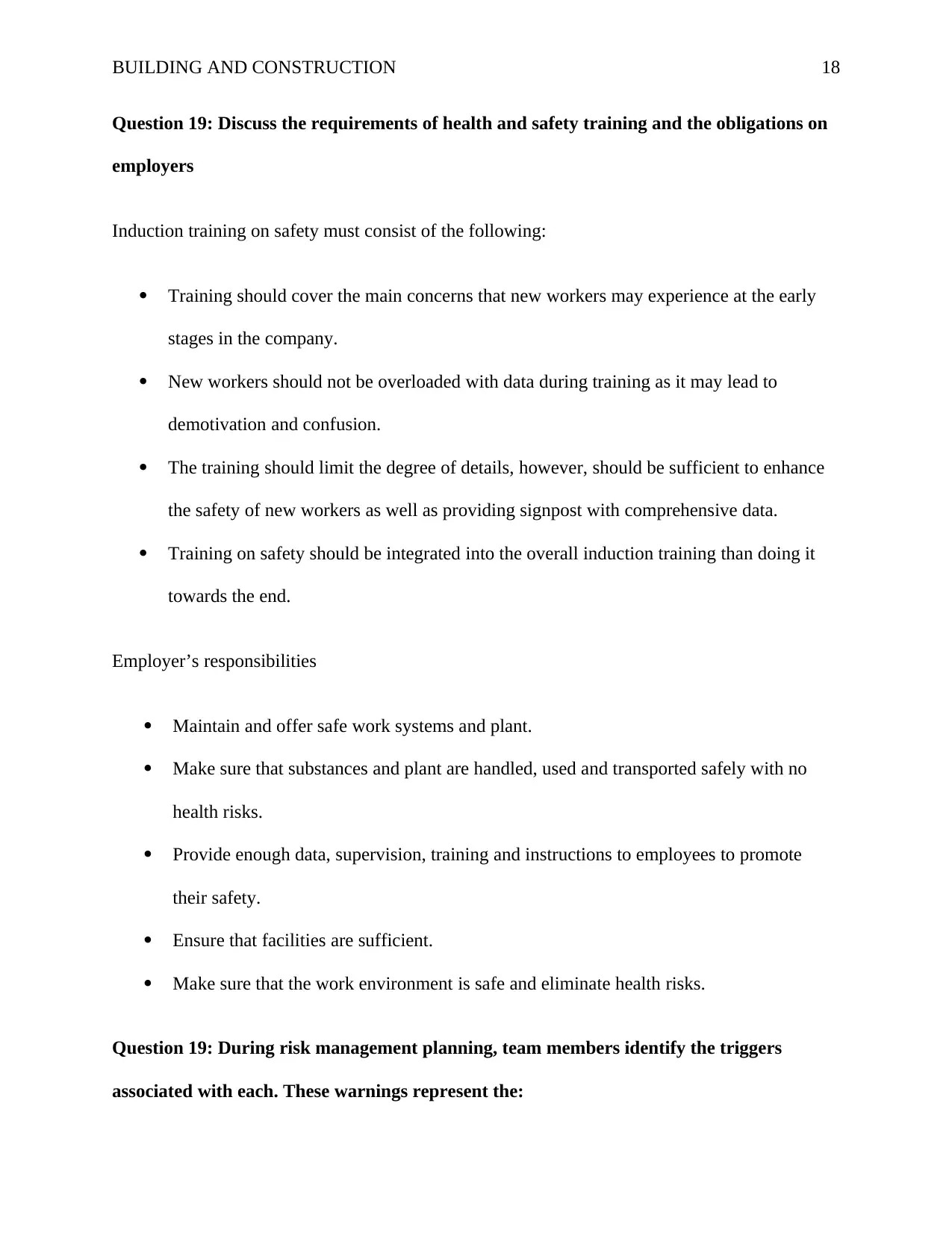
BUILDING AND CONSTRUCTION 18
Question 19: Discuss the requirements of health and safety training and the obligations on
employers
Induction training on safety must consist of the following:
Training should cover the main concerns that new workers may experience at the early
stages in the company.
New workers should not be overloaded with data during training as it may lead to
demotivation and confusion.
The training should limit the degree of details, however, should be sufficient to enhance
the safety of new workers as well as providing signpost with comprehensive data.
Training on safety should be integrated into the overall induction training than doing it
towards the end.
Employer’s responsibilities
Maintain and offer safe work systems and plant.
Make sure that substances and plant are handled, used and transported safely with no
health risks.
Provide enough data, supervision, training and instructions to employees to promote
their safety.
Ensure that facilities are sufficient.
Make sure that the work environment is safe and eliminate health risks.
Question 19: During risk management planning, team members identify the triggers
associated with each. These warnings represent the:
Question 19: Discuss the requirements of health and safety training and the obligations on
employers
Induction training on safety must consist of the following:
Training should cover the main concerns that new workers may experience at the early
stages in the company.
New workers should not be overloaded with data during training as it may lead to
demotivation and confusion.
The training should limit the degree of details, however, should be sufficient to enhance
the safety of new workers as well as providing signpost with comprehensive data.
Training on safety should be integrated into the overall induction training than doing it
towards the end.
Employer’s responsibilities
Maintain and offer safe work systems and plant.
Make sure that substances and plant are handled, used and transported safely with no
health risks.
Provide enough data, supervision, training and instructions to employees to promote
their safety.
Ensure that facilities are sufficient.
Make sure that the work environment is safe and eliminate health risks.
Question 19: During risk management planning, team members identify the triggers
associated with each. These warnings represent the:
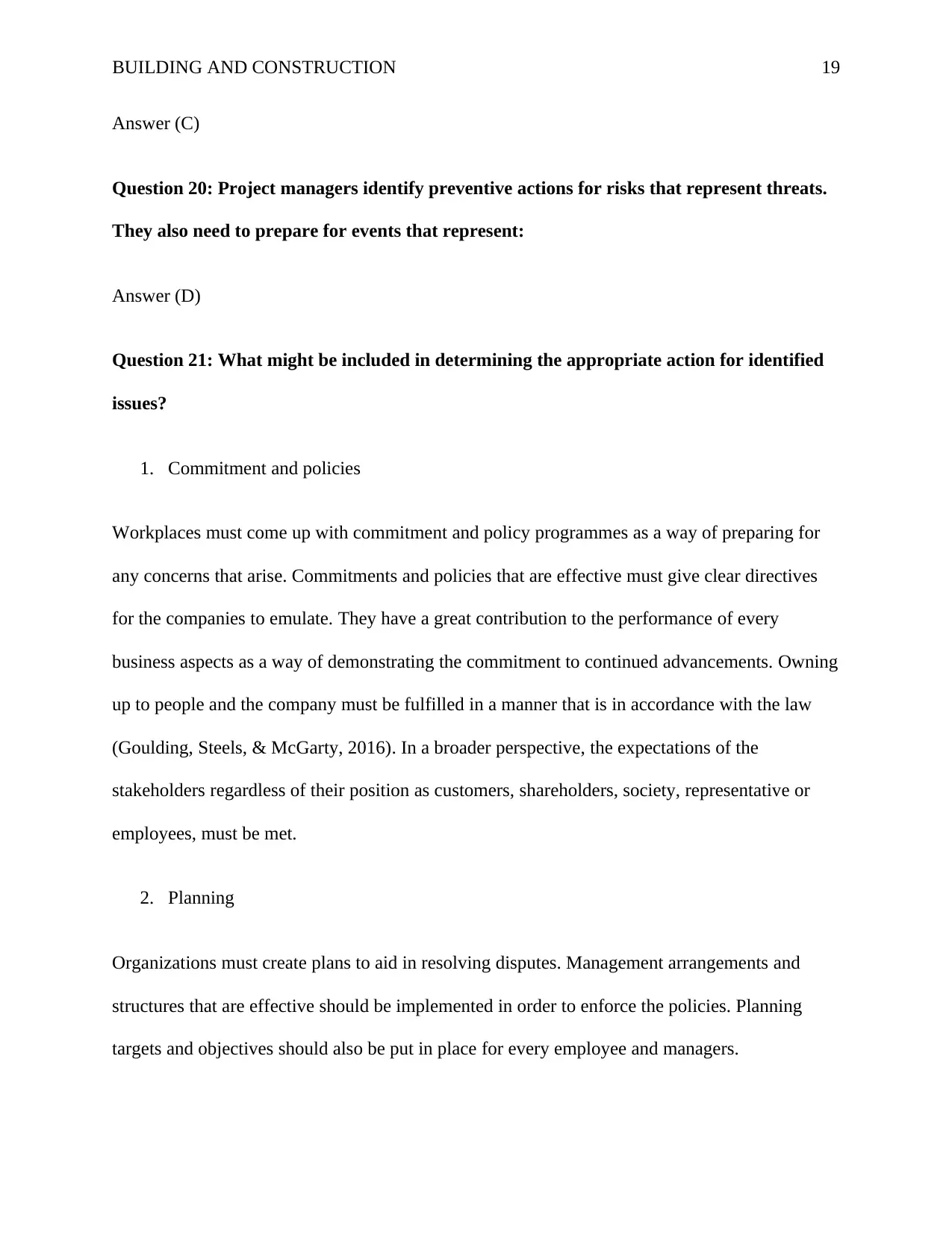
BUILDING AND CONSTRUCTION 19
Answer (C)
Question 20: Project managers identify preventive actions for risks that represent threats.
They also need to prepare for events that represent:
Answer (D)
Question 21: What might be included in determining the appropriate action for identified
issues?
1. Commitment and policies
Workplaces must come up with commitment and policy programmes as a way of preparing for
any concerns that arise. Commitments and policies that are effective must give clear directives
for the companies to emulate. They have a great contribution to the performance of every
business aspects as a way of demonstrating the commitment to continued advancements. Owning
up to people and the company must be fulfilled in a manner that is in accordance with the law
(Goulding, Steels, & McGarty, 2016). In a broader perspective, the expectations of the
stakeholders regardless of their position as customers, shareholders, society, representative or
employees, must be met.
2. Planning
Organizations must create plans to aid in resolving disputes. Management arrangements and
structures that are effective should be implemented in order to enforce the policies. Planning
targets and objectives should also be put in place for every employee and managers.
Answer (C)
Question 20: Project managers identify preventive actions for risks that represent threats.
They also need to prepare for events that represent:
Answer (D)
Question 21: What might be included in determining the appropriate action for identified
issues?
1. Commitment and policies
Workplaces must come up with commitment and policy programmes as a way of preparing for
any concerns that arise. Commitments and policies that are effective must give clear directives
for the companies to emulate. They have a great contribution to the performance of every
business aspects as a way of demonstrating the commitment to continued advancements. Owning
up to people and the company must be fulfilled in a manner that is in accordance with the law
(Goulding, Steels, & McGarty, 2016). In a broader perspective, the expectations of the
stakeholders regardless of their position as customers, shareholders, society, representative or
employees, must be met.
2. Planning
Organizations must create plans to aid in resolving disputes. Management arrangements and
structures that are effective should be implemented in order to enforce the policies. Planning
targets and objectives should also be put in place for every employee and managers.
Paraphrase This Document
Need a fresh take? Get an instant paraphrase of this document with our AI Paraphraser
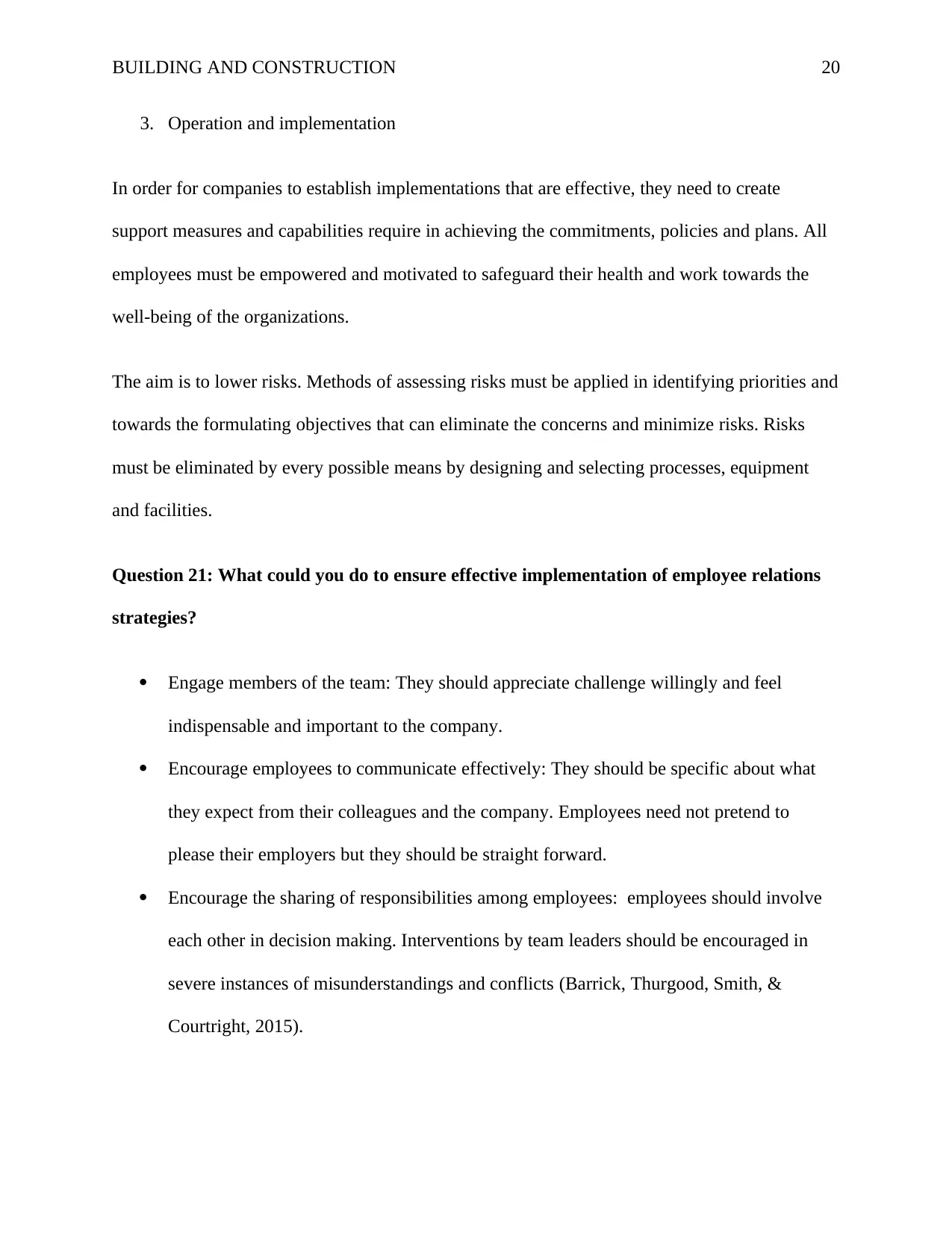
BUILDING AND CONSTRUCTION 20
3. Operation and implementation
In order for companies to establish implementations that are effective, they need to create
support measures and capabilities require in achieving the commitments, policies and plans. All
employees must be empowered and motivated to safeguard their health and work towards the
well-being of the organizations.
The aim is to lower risks. Methods of assessing risks must be applied in identifying priorities and
towards the formulating objectives that can eliminate the concerns and minimize risks. Risks
must be eliminated by every possible means by designing and selecting processes, equipment
and facilities.
Question 21: What could you do to ensure effective implementation of employee relations
strategies?
Engage members of the team: They should appreciate challenge willingly and feel
indispensable and important to the company.
Encourage employees to communicate effectively: They should be specific about what
they expect from their colleagues and the company. Employees need not pretend to
please their employers but they should be straight forward.
Encourage the sharing of responsibilities among employees: employees should involve
each other in decision making. Interventions by team leaders should be encouraged in
severe instances of misunderstandings and conflicts (Barrick, Thurgood, Smith, &
Courtright, 2015).
3. Operation and implementation
In order for companies to establish implementations that are effective, they need to create
support measures and capabilities require in achieving the commitments, policies and plans. All
employees must be empowered and motivated to safeguard their health and work towards the
well-being of the organizations.
The aim is to lower risks. Methods of assessing risks must be applied in identifying priorities and
towards the formulating objectives that can eliminate the concerns and minimize risks. Risks
must be eliminated by every possible means by designing and selecting processes, equipment
and facilities.
Question 21: What could you do to ensure effective implementation of employee relations
strategies?
Engage members of the team: They should appreciate challenge willingly and feel
indispensable and important to the company.
Encourage employees to communicate effectively: They should be specific about what
they expect from their colleagues and the company. Employees need not pretend to
please their employers but they should be straight forward.
Encourage the sharing of responsibilities among employees: employees should involve
each other in decision making. Interventions by team leaders should be encouraged in
severe instances of misunderstandings and conflicts (Barrick, Thurgood, Smith, &
Courtright, 2015).
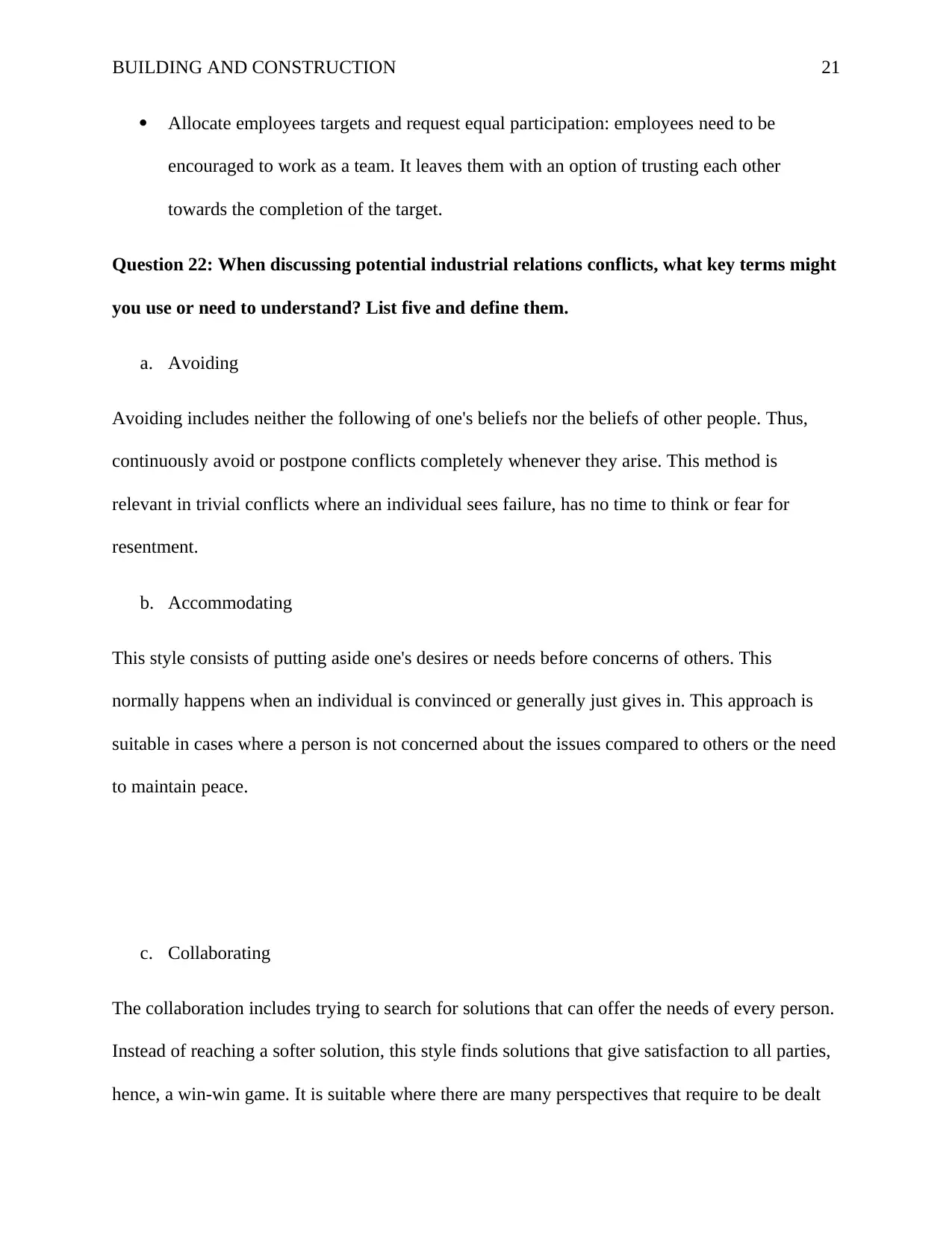
BUILDING AND CONSTRUCTION 21
Allocate employees targets and request equal participation: employees need to be
encouraged to work as a team. It leaves them with an option of trusting each other
towards the completion of the target.
Question 22: When discussing potential industrial relations conflicts, what key terms might
you use or need to understand? List five and define them.
a. Avoiding
Avoiding includes neither the following of one's beliefs nor the beliefs of other people. Thus,
continuously avoid or postpone conflicts completely whenever they arise. This method is
relevant in trivial conflicts where an individual sees failure, has no time to think or fear for
resentment.
b. Accommodating
This style consists of putting aside one's desires or needs before concerns of others. This
normally happens when an individual is convinced or generally just gives in. This approach is
suitable in cases where a person is not concerned about the issues compared to others or the need
to maintain peace.
c. Collaborating
The collaboration includes trying to search for solutions that can offer the needs of every person.
Instead of reaching a softer solution, this style finds solutions that give satisfaction to all parties,
hence, a win-win game. It is suitable where there are many perspectives that require to be dealt
Allocate employees targets and request equal participation: employees need to be
encouraged to work as a team. It leaves them with an option of trusting each other
towards the completion of the target.
Question 22: When discussing potential industrial relations conflicts, what key terms might
you use or need to understand? List five and define them.
a. Avoiding
Avoiding includes neither the following of one's beliefs nor the beliefs of other people. Thus,
continuously avoid or postpone conflicts completely whenever they arise. This method is
relevant in trivial conflicts where an individual sees failure, has no time to think or fear for
resentment.
b. Accommodating
This style consists of putting aside one's desires or needs before concerns of others. This
normally happens when an individual is convinced or generally just gives in. This approach is
suitable in cases where a person is not concerned about the issues compared to others or the need
to maintain peace.
c. Collaborating
The collaboration includes trying to search for solutions that can offer the needs of every person.
Instead of reaching a softer solution, this style finds solutions that give satisfaction to all parties,
hence, a win-win game. It is suitable where there are many perspectives that require to be dealt
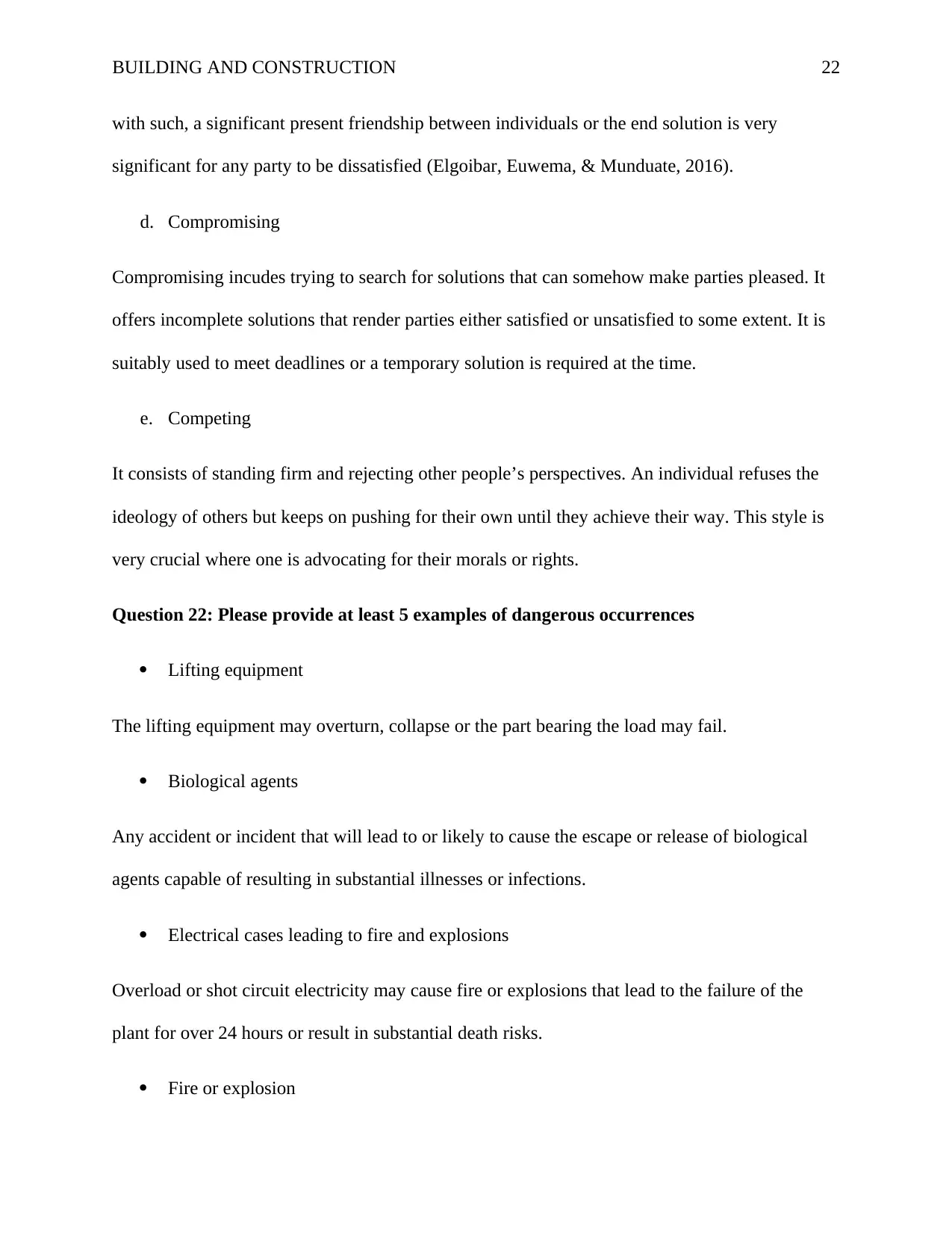
BUILDING AND CONSTRUCTION 22
with such, a significant present friendship between individuals or the end solution is very
significant for any party to be dissatisfied (Elgoibar, Euwema, & Munduate, 2016).
d. Compromising
Compromising incudes trying to search for solutions that can somehow make parties pleased. It
offers incomplete solutions that render parties either satisfied or unsatisfied to some extent. It is
suitably used to meet deadlines or a temporary solution is required at the time.
e. Competing
It consists of standing firm and rejecting other people’s perspectives. An individual refuses the
ideology of others but keeps on pushing for their own until they achieve their way. This style is
very crucial where one is advocating for their morals or rights.
Question 22: Please provide at least 5 examples of dangerous occurrences
Lifting equipment
The lifting equipment may overturn, collapse or the part bearing the load may fail.
Biological agents
Any accident or incident that will lead to or likely to cause the escape or release of biological
agents capable of resulting in substantial illnesses or infections.
Electrical cases leading to fire and explosions
Overload or shot circuit electricity may cause fire or explosions that lead to the failure of the
plant for over 24 hours or result in substantial death risks.
Fire or explosion
with such, a significant present friendship between individuals or the end solution is very
significant for any party to be dissatisfied (Elgoibar, Euwema, & Munduate, 2016).
d. Compromising
Compromising incudes trying to search for solutions that can somehow make parties pleased. It
offers incomplete solutions that render parties either satisfied or unsatisfied to some extent. It is
suitably used to meet deadlines or a temporary solution is required at the time.
e. Competing
It consists of standing firm and rejecting other people’s perspectives. An individual refuses the
ideology of others but keeps on pushing for their own until they achieve their way. This style is
very crucial where one is advocating for their morals or rights.
Question 22: Please provide at least 5 examples of dangerous occurrences
Lifting equipment
The lifting equipment may overturn, collapse or the part bearing the load may fail.
Biological agents
Any accident or incident that will lead to or likely to cause the escape or release of biological
agents capable of resulting in substantial illnesses or infections.
Electrical cases leading to fire and explosions
Overload or shot circuit electricity may cause fire or explosions that lead to the failure of the
plant for over 24 hours or result in substantial death risks.
Fire or explosion
Secure Best Marks with AI Grader
Need help grading? Try our AI Grader for instant feedback on your assignments.
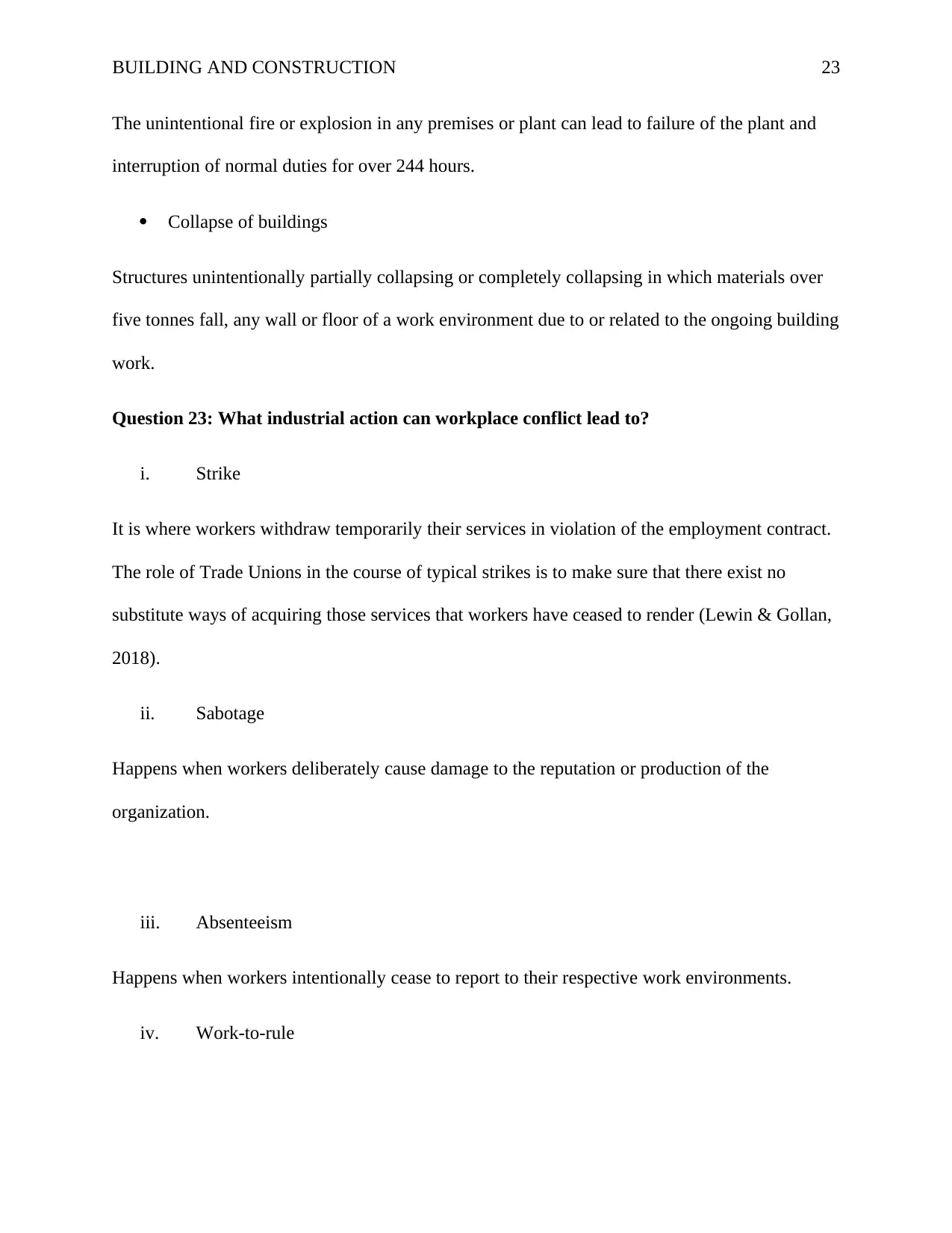
BUILDING AND CONSTRUCTION 23
The unintentional fire or explosion in any premises or plant can lead to failure of the plant and
interruption of normal duties for over 244 hours.
Collapse of buildings
Structures unintentionally partially collapsing or completely collapsing in which materials over
five tonnes fall, any wall or floor of a work environment due to or related to the ongoing building
work.
Question 23: What industrial action can workplace conflict lead to?
i. Strike
It is where workers withdraw temporarily their services in violation of the employment contract.
The role of Trade Unions in the course of typical strikes is to make sure that there exist no
substitute ways of acquiring those services that workers have ceased to render (Lewin & Gollan,
2018).
ii. Sabotage
Happens when workers deliberately cause damage to the reputation or production of the
organization.
iii. Absenteeism
Happens when workers intentionally cease to report to their respective work environments.
iv. Work-to-rule
The unintentional fire or explosion in any premises or plant can lead to failure of the plant and
interruption of normal duties for over 244 hours.
Collapse of buildings
Structures unintentionally partially collapsing or completely collapsing in which materials over
five tonnes fall, any wall or floor of a work environment due to or related to the ongoing building
work.
Question 23: What industrial action can workplace conflict lead to?
i. Strike
It is where workers withdraw temporarily their services in violation of the employment contract.
The role of Trade Unions in the course of typical strikes is to make sure that there exist no
substitute ways of acquiring those services that workers have ceased to render (Lewin & Gollan,
2018).
ii. Sabotage
Happens when workers deliberately cause damage to the reputation or production of the
organization.
iii. Absenteeism
Happens when workers intentionally cease to report to their respective work environments.
iv. Work-to-rule
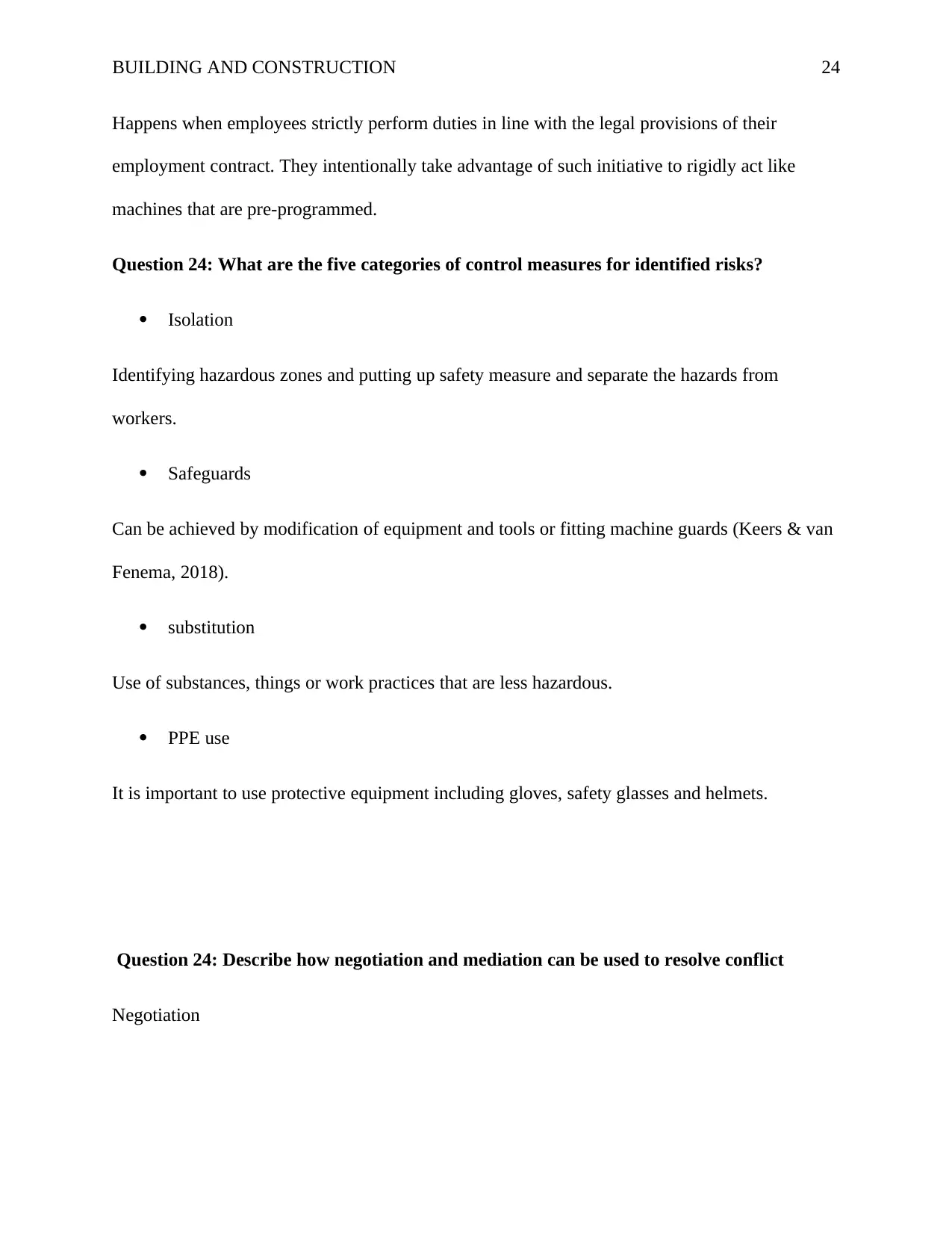
BUILDING AND CONSTRUCTION 24
Happens when employees strictly perform duties in line with the legal provisions of their
employment contract. They intentionally take advantage of such initiative to rigidly act like
machines that are pre-programmed.
Question 24: What are the five categories of control measures for identified risks?
Isolation
Identifying hazardous zones and putting up safety measure and separate the hazards from
workers.
Safeguards
Can be achieved by modification of equipment and tools or fitting machine guards (Keers & van
Fenema, 2018).
substitution
Use of substances, things or work practices that are less hazardous.
PPE use
It is important to use protective equipment including gloves, safety glasses and helmets.
Question 24: Describe how negotiation and mediation can be used to resolve conflict
Negotiation
Happens when employees strictly perform duties in line with the legal provisions of their
employment contract. They intentionally take advantage of such initiative to rigidly act like
machines that are pre-programmed.
Question 24: What are the five categories of control measures for identified risks?
Isolation
Identifying hazardous zones and putting up safety measure and separate the hazards from
workers.
Safeguards
Can be achieved by modification of equipment and tools or fitting machine guards (Keers & van
Fenema, 2018).
substitution
Use of substances, things or work practices that are less hazardous.
PPE use
It is important to use protective equipment including gloves, safety glasses and helmets.
Question 24: Describe how negotiation and mediation can be used to resolve conflict
Negotiation
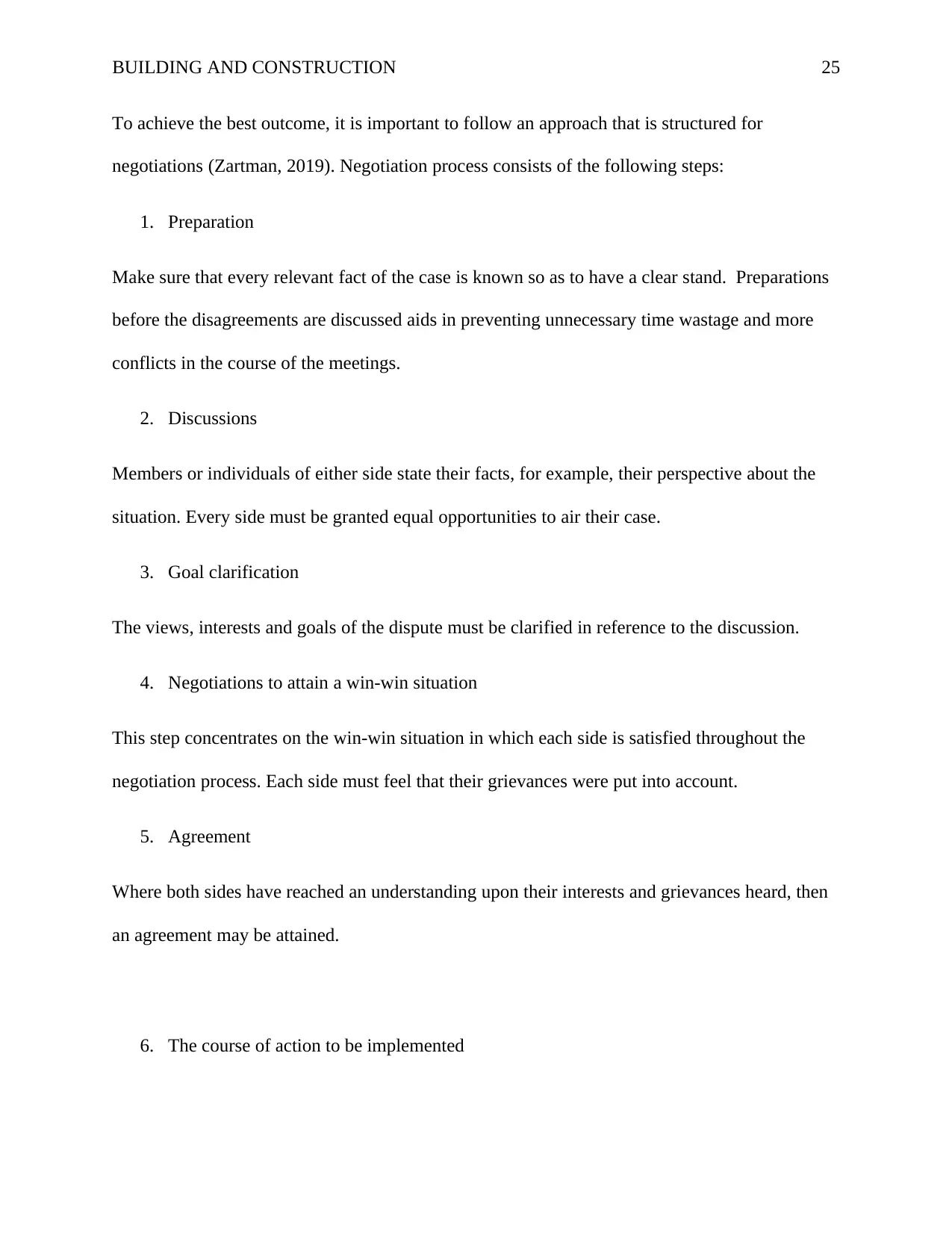
BUILDING AND CONSTRUCTION 25
To achieve the best outcome, it is important to follow an approach that is structured for
negotiations (Zartman, 2019). Negotiation process consists of the following steps:
1. Preparation
Make sure that every relevant fact of the case is known so as to have a clear stand. Preparations
before the disagreements are discussed aids in preventing unnecessary time wastage and more
conflicts in the course of the meetings.
2. Discussions
Members or individuals of either side state their facts, for example, their perspective about the
situation. Every side must be granted equal opportunities to air their case.
3. Goal clarification
The views, interests and goals of the dispute must be clarified in reference to the discussion.
4. Negotiations to attain a win-win situation
This step concentrates on the win-win situation in which each side is satisfied throughout the
negotiation process. Each side must feel that their grievances were put into account.
5. Agreement
Where both sides have reached an understanding upon their interests and grievances heard, then
an agreement may be attained.
6. The course of action to be implemented
To achieve the best outcome, it is important to follow an approach that is structured for
negotiations (Zartman, 2019). Negotiation process consists of the following steps:
1. Preparation
Make sure that every relevant fact of the case is known so as to have a clear stand. Preparations
before the disagreements are discussed aids in preventing unnecessary time wastage and more
conflicts in the course of the meetings.
2. Discussions
Members or individuals of either side state their facts, for example, their perspective about the
situation. Every side must be granted equal opportunities to air their case.
3. Goal clarification
The views, interests and goals of the dispute must be clarified in reference to the discussion.
4. Negotiations to attain a win-win situation
This step concentrates on the win-win situation in which each side is satisfied throughout the
negotiation process. Each side must feel that their grievances were put into account.
5. Agreement
Where both sides have reached an understanding upon their interests and grievances heard, then
an agreement may be attained.
6. The course of action to be implemented
Paraphrase This Document
Need a fresh take? Get an instant paraphrase of this document with our AI Paraphraser

BUILDING AND CONSTRUCTION 26
There has to be an implementation of the course of action resulting from the agreement to
enforce the decision arrived at.
Mediation
Mediation is the conflict resolution process whereby a neutral third party called a mediator, aids
in solving the dispute between or among the disputants. It is a voluntary process and mediators
do not engage in the end result of the agreement. Parties in dispute have power over the
agreements they desire (McKenzie, 2015).
The following are the aims of mediators:
To promote active mediation which means the potential to build voluntary cooperative
engagements during negotiation.
Promotes information between and to parties to the dispute.
Boost, keep and cultivate communication between parties to the dispute.
Question 25: Who are the WHS duty holders in any organization?
The WHS laws of Australia imposes obligations to certain individuals:
a. The person undertaking a Business or Undertaking ( PCBU)
PCBUs are entities at law doing or undertaking businesses. They are either companies or
individuals operating or undertaking businesses (Bennett, Dexter, & Sakoulas, 2016). The
following refers to organizations undertaking businesses:
Company trustees
Public companies
There has to be an implementation of the course of action resulting from the agreement to
enforce the decision arrived at.
Mediation
Mediation is the conflict resolution process whereby a neutral third party called a mediator, aids
in solving the dispute between or among the disputants. It is a voluntary process and mediators
do not engage in the end result of the agreement. Parties in dispute have power over the
agreements they desire (McKenzie, 2015).
The following are the aims of mediators:
To promote active mediation which means the potential to build voluntary cooperative
engagements during negotiation.
Promotes information between and to parties to the dispute.
Boost, keep and cultivate communication between parties to the dispute.
Question 25: Who are the WHS duty holders in any organization?
The WHS laws of Australia imposes obligations to certain individuals:
a. The person undertaking a Business or Undertaking ( PCBU)
PCBUs are entities at law doing or undertaking businesses. They are either companies or
individuals operating or undertaking businesses (Bennett, Dexter, & Sakoulas, 2016). The
following refers to organizations undertaking businesses:
Company trustees
Public companies
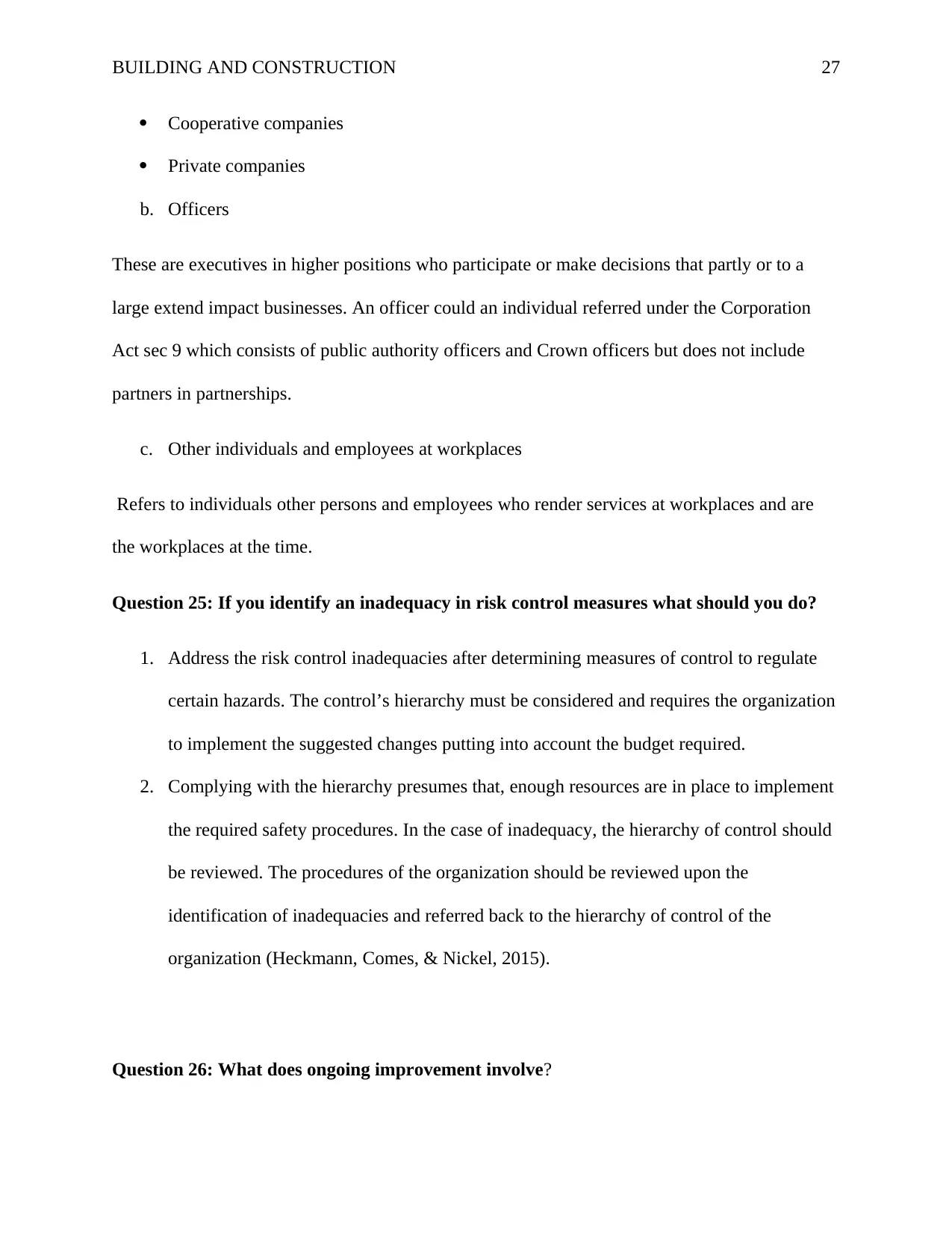
BUILDING AND CONSTRUCTION 27
Cooperative companies
Private companies
b. Officers
These are executives in higher positions who participate or make decisions that partly or to a
large extend impact businesses. An officer could an individual referred under the Corporation
Act sec 9 which consists of public authority officers and Crown officers but does not include
partners in partnerships.
c. Other individuals and employees at workplaces
Refers to individuals other persons and employees who render services at workplaces and are
the workplaces at the time.
Question 25: If you identify an inadequacy in risk control measures what should you do?
1. Address the risk control inadequacies after determining measures of control to regulate
certain hazards. The control’s hierarchy must be considered and requires the organization
to implement the suggested changes putting into account the budget required.
2. Complying with the hierarchy presumes that, enough resources are in place to implement
the required safety procedures. In the case of inadequacy, the hierarchy of control should
be reviewed. The procedures of the organization should be reviewed upon the
identification of inadequacies and referred back to the hierarchy of control of the
organization (Heckmann, Comes, & Nickel, 2015).
Question 26: What does ongoing improvement involve?
Cooperative companies
Private companies
b. Officers
These are executives in higher positions who participate or make decisions that partly or to a
large extend impact businesses. An officer could an individual referred under the Corporation
Act sec 9 which consists of public authority officers and Crown officers but does not include
partners in partnerships.
c. Other individuals and employees at workplaces
Refers to individuals other persons and employees who render services at workplaces and are
the workplaces at the time.
Question 25: If you identify an inadequacy in risk control measures what should you do?
1. Address the risk control inadequacies after determining measures of control to regulate
certain hazards. The control’s hierarchy must be considered and requires the organization
to implement the suggested changes putting into account the budget required.
2. Complying with the hierarchy presumes that, enough resources are in place to implement
the required safety procedures. In the case of inadequacy, the hierarchy of control should
be reviewed. The procedures of the organization should be reviewed upon the
identification of inadequacies and referred back to the hierarchy of control of the
organization (Heckmann, Comes, & Nickel, 2015).
Question 26: What does ongoing improvement involve?
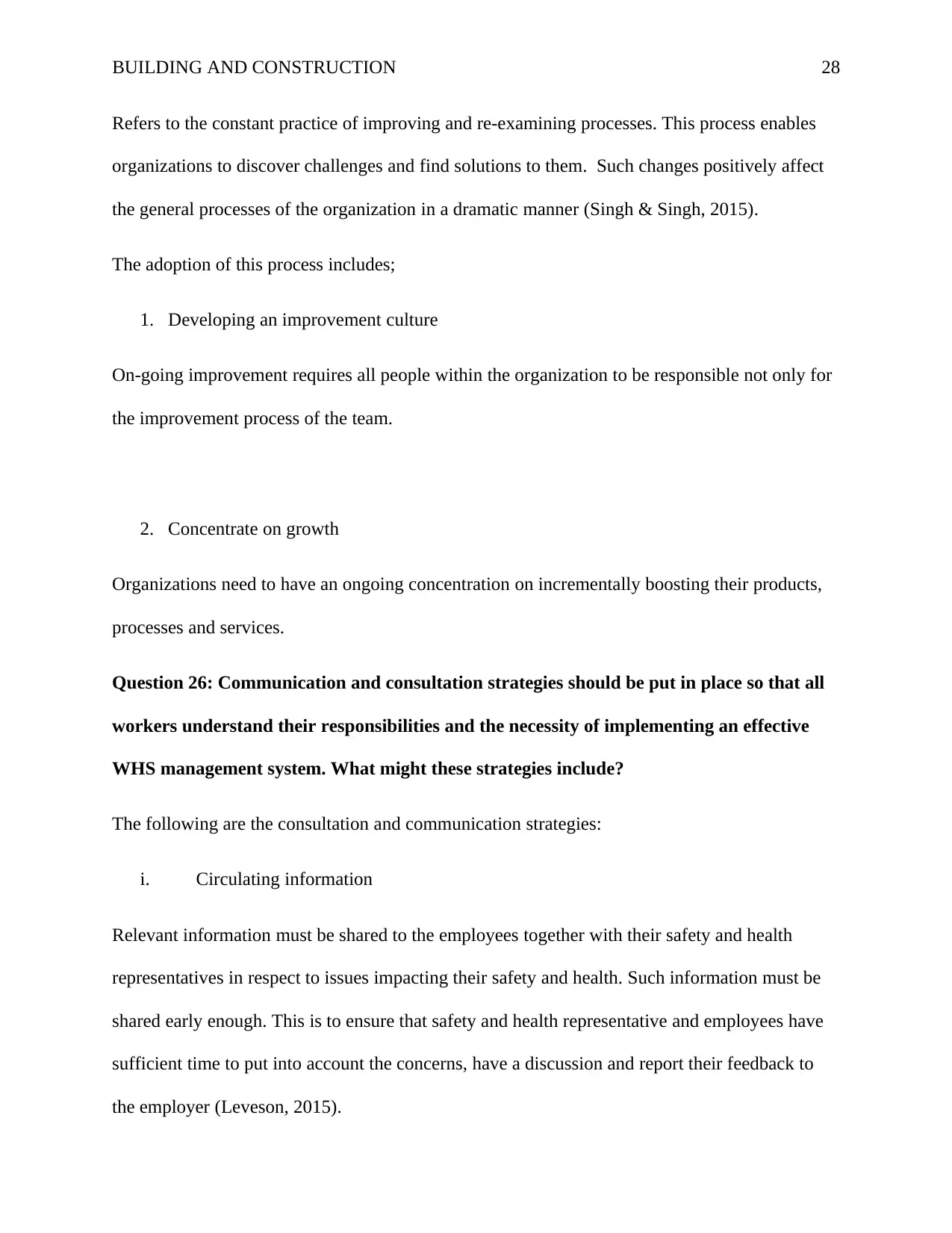
BUILDING AND CONSTRUCTION 28
Refers to the constant practice of improving and re-examining processes. This process enables
organizations to discover challenges and find solutions to them. Such changes positively affect
the general processes of the organization in a dramatic manner (Singh & Singh, 2015).
The adoption of this process includes;
1. Developing an improvement culture
On-going improvement requires all people within the organization to be responsible not only for
the improvement process of the team.
2. Concentrate on growth
Organizations need to have an ongoing concentration on incrementally boosting their products,
processes and services.
Question 26: Communication and consultation strategies should be put in place so that all
workers understand their responsibilities and the necessity of implementing an effective
WHS management system. What might these strategies include?
The following are the consultation and communication strategies:
i. Circulating information
Relevant information must be shared to the employees together with their safety and health
representatives in respect to issues impacting their safety and health. Such information must be
shared early enough. This is to ensure that safety and health representative and employees have
sufficient time to put into account the concerns, have a discussion and report their feedback to
the employer (Leveson, 2015).
Refers to the constant practice of improving and re-examining processes. This process enables
organizations to discover challenges and find solutions to them. Such changes positively affect
the general processes of the organization in a dramatic manner (Singh & Singh, 2015).
The adoption of this process includes;
1. Developing an improvement culture
On-going improvement requires all people within the organization to be responsible not only for
the improvement process of the team.
2. Concentrate on growth
Organizations need to have an ongoing concentration on incrementally boosting their products,
processes and services.
Question 26: Communication and consultation strategies should be put in place so that all
workers understand their responsibilities and the necessity of implementing an effective
WHS management system. What might these strategies include?
The following are the consultation and communication strategies:
i. Circulating information
Relevant information must be shared to the employees together with their safety and health
representatives in respect to issues impacting their safety and health. Such information must be
shared early enough. This is to ensure that safety and health representative and employees have
sufficient time to put into account the concerns, have a discussion and report their feedback to
the employer (Leveson, 2015).
Secure Best Marks with AI Grader
Need help grading? Try our AI Grader for instant feedback on your assignments.
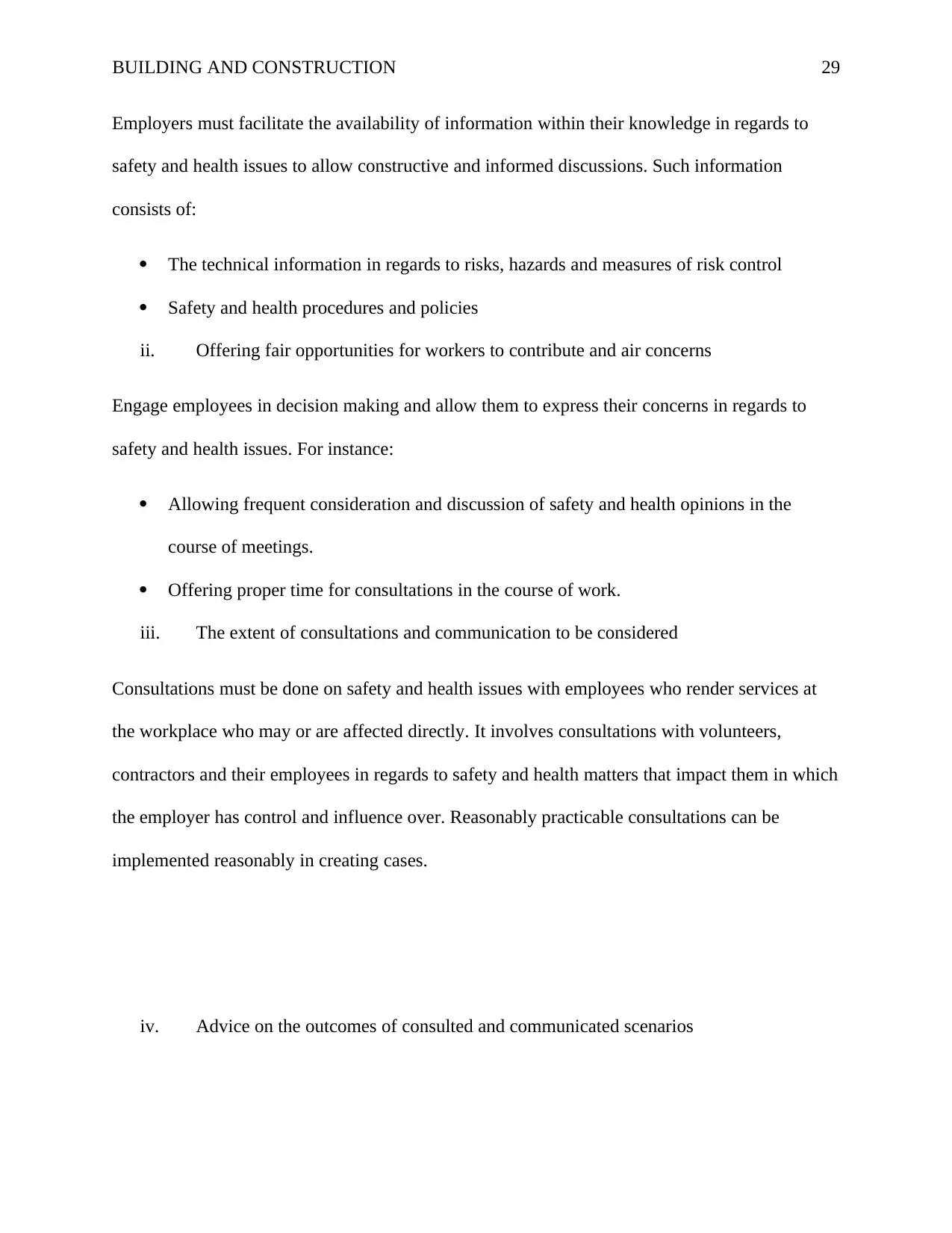
BUILDING AND CONSTRUCTION 29
Employers must facilitate the availability of information within their knowledge in regards to
safety and health issues to allow constructive and informed discussions. Such information
consists of:
The technical information in regards to risks, hazards and measures of risk control
Safety and health procedures and policies
ii. Offering fair opportunities for workers to contribute and air concerns
Engage employees in decision making and allow them to express their concerns in regards to
safety and health issues. For instance:
Allowing frequent consideration and discussion of safety and health opinions in the
course of meetings.
Offering proper time for consultations in the course of work.
iii. The extent of consultations and communication to be considered
Consultations must be done on safety and health issues with employees who render services at
the workplace who may or are affected directly. It involves consultations with volunteers,
contractors and their employees in regards to safety and health matters that impact them in which
the employer has control and influence over. Reasonably practicable consultations can be
implemented reasonably in creating cases.
iv. Advice on the outcomes of consulted and communicated scenarios
Employers must facilitate the availability of information within their knowledge in regards to
safety and health issues to allow constructive and informed discussions. Such information
consists of:
The technical information in regards to risks, hazards and measures of risk control
Safety and health procedures and policies
ii. Offering fair opportunities for workers to contribute and air concerns
Engage employees in decision making and allow them to express their concerns in regards to
safety and health issues. For instance:
Allowing frequent consideration and discussion of safety and health opinions in the
course of meetings.
Offering proper time for consultations in the course of work.
iii. The extent of consultations and communication to be considered
Consultations must be done on safety and health issues with employees who render services at
the workplace who may or are affected directly. It involves consultations with volunteers,
contractors and their employees in regards to safety and health matters that impact them in which
the employer has control and influence over. Reasonably practicable consultations can be
implemented reasonably in creating cases.
iv. Advice on the outcomes of consulted and communicated scenarios
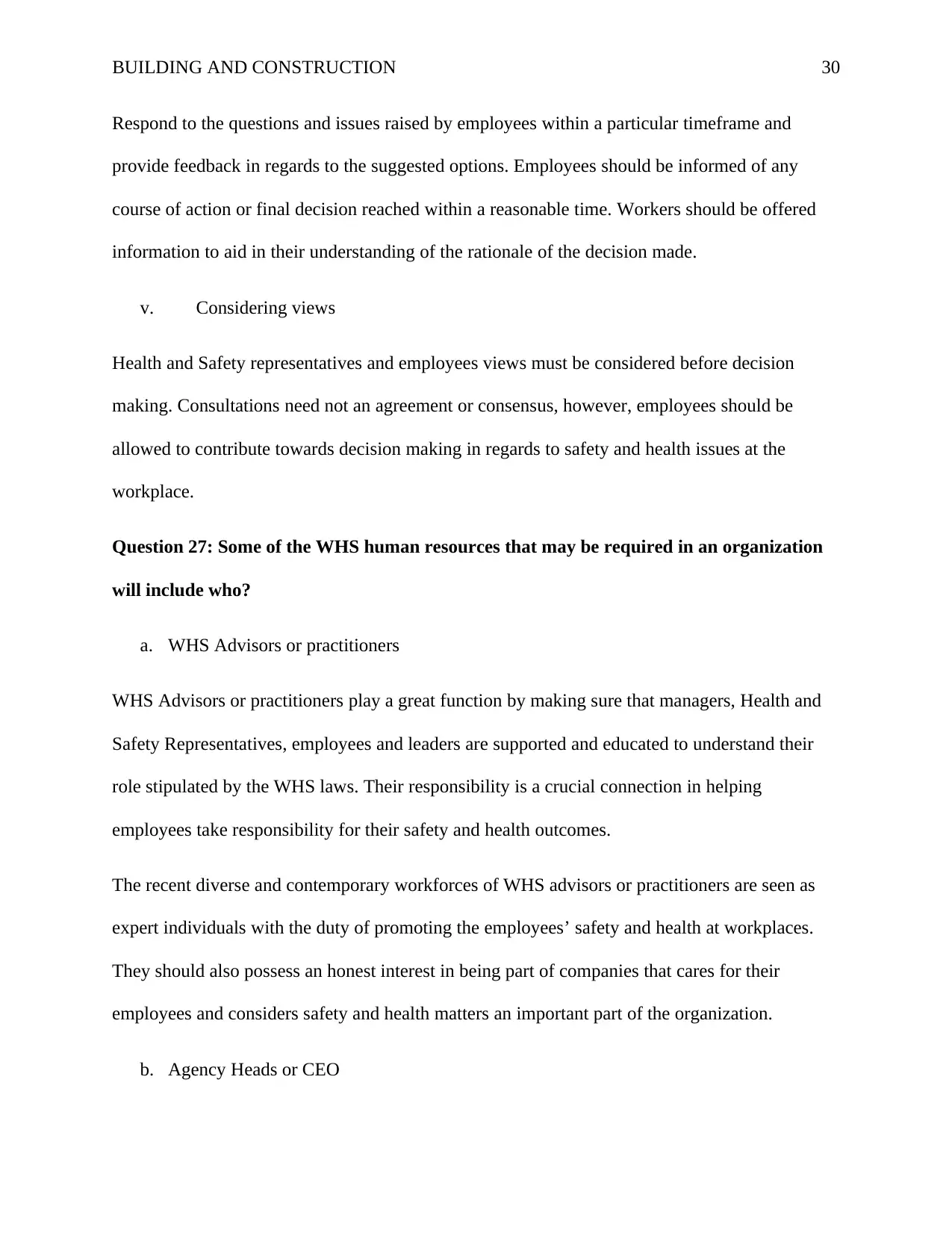
BUILDING AND CONSTRUCTION 30
Respond to the questions and issues raised by employees within a particular timeframe and
provide feedback in regards to the suggested options. Employees should be informed of any
course of action or final decision reached within a reasonable time. Workers should be offered
information to aid in their understanding of the rationale of the decision made.
v. Considering views
Health and Safety representatives and employees views must be considered before decision
making. Consultations need not an agreement or consensus, however, employees should be
allowed to contribute towards decision making in regards to safety and health issues at the
workplace.
Question 27: Some of the WHS human resources that may be required in an organization
will include who?
a. WHS Advisors or practitioners
WHS Advisors or practitioners play a great function by making sure that managers, Health and
Safety Representatives, employees and leaders are supported and educated to understand their
role stipulated by the WHS laws. Their responsibility is a crucial connection in helping
employees take responsibility for their safety and health outcomes.
The recent diverse and contemporary workforces of WHS advisors or practitioners are seen as
expert individuals with the duty of promoting the employees’ safety and health at workplaces.
They should also possess an honest interest in being part of companies that cares for their
employees and considers safety and health matters an important part of the organization.
b. Agency Heads or CEO
Respond to the questions and issues raised by employees within a particular timeframe and
provide feedback in regards to the suggested options. Employees should be informed of any
course of action or final decision reached within a reasonable time. Workers should be offered
information to aid in their understanding of the rationale of the decision made.
v. Considering views
Health and Safety representatives and employees views must be considered before decision
making. Consultations need not an agreement or consensus, however, employees should be
allowed to contribute towards decision making in regards to safety and health issues at the
workplace.
Question 27: Some of the WHS human resources that may be required in an organization
will include who?
a. WHS Advisors or practitioners
WHS Advisors or practitioners play a great function by making sure that managers, Health and
Safety Representatives, employees and leaders are supported and educated to understand their
role stipulated by the WHS laws. Their responsibility is a crucial connection in helping
employees take responsibility for their safety and health outcomes.
The recent diverse and contemporary workforces of WHS advisors or practitioners are seen as
expert individuals with the duty of promoting the employees’ safety and health at workplaces.
They should also possess an honest interest in being part of companies that cares for their
employees and considers safety and health matters an important part of the organization.
b. Agency Heads or CEO
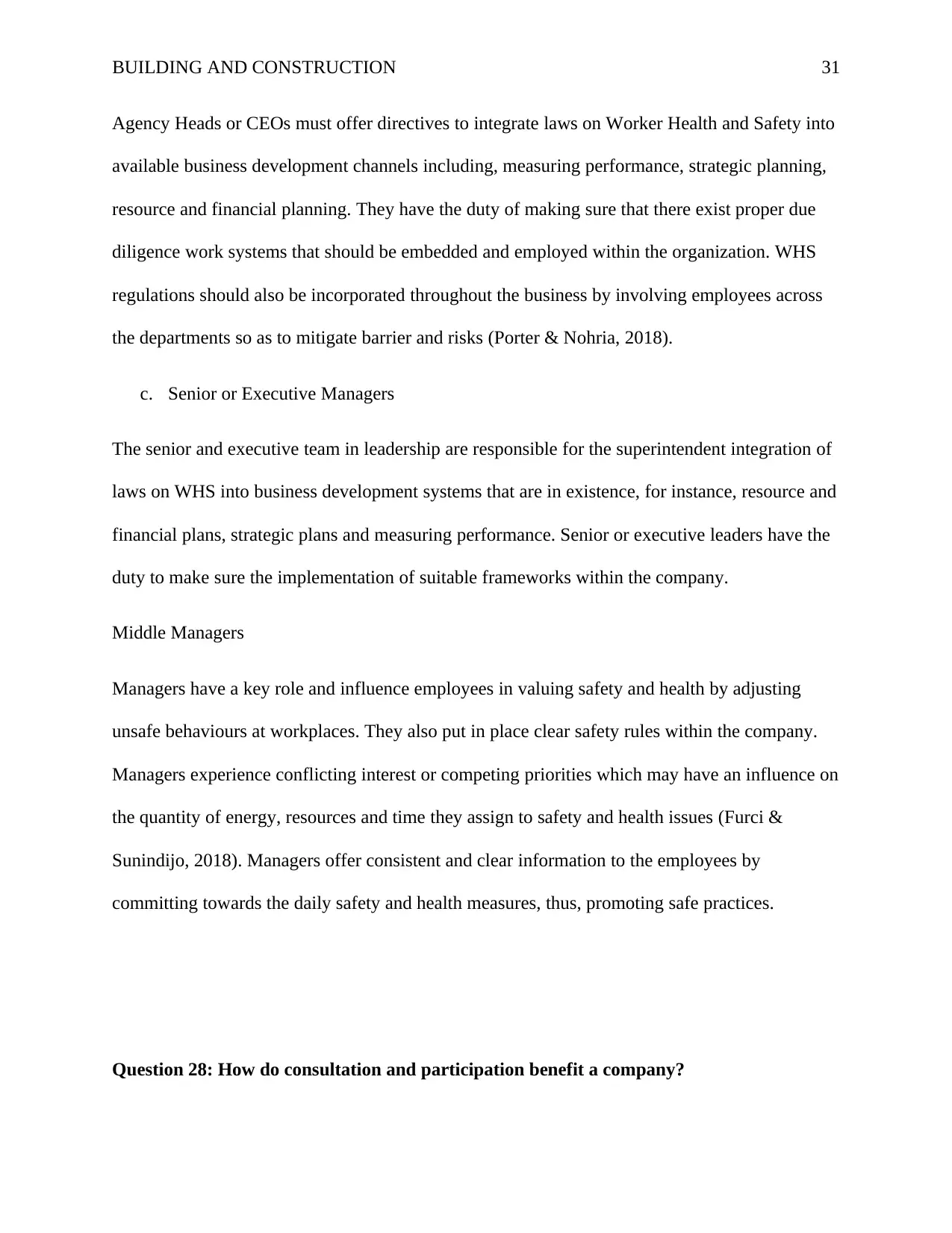
BUILDING AND CONSTRUCTION 31
Agency Heads or CEOs must offer directives to integrate laws on Worker Health and Safety into
available business development channels including, measuring performance, strategic planning,
resource and financial planning. They have the duty of making sure that there exist proper due
diligence work systems that should be embedded and employed within the organization. WHS
regulations should also be incorporated throughout the business by involving employees across
the departments so as to mitigate barrier and risks (Porter & Nohria, 2018).
c. Senior or Executive Managers
The senior and executive team in leadership are responsible for the superintendent integration of
laws on WHS into business development systems that are in existence, for instance, resource and
financial plans, strategic plans and measuring performance. Senior or executive leaders have the
duty to make sure the implementation of suitable frameworks within the company.
Middle Managers
Managers have a key role and influence employees in valuing safety and health by adjusting
unsafe behaviours at workplaces. They also put in place clear safety rules within the company.
Managers experience conflicting interest or competing priorities which may have an influence on
the quantity of energy, resources and time they assign to safety and health issues (Furci &
Sunindijo, 2018). Managers offer consistent and clear information to the employees by
committing towards the daily safety and health measures, thus, promoting safe practices.
Question 28: How do consultation and participation benefit a company?
Agency Heads or CEOs must offer directives to integrate laws on Worker Health and Safety into
available business development channels including, measuring performance, strategic planning,
resource and financial planning. They have the duty of making sure that there exist proper due
diligence work systems that should be embedded and employed within the organization. WHS
regulations should also be incorporated throughout the business by involving employees across
the departments so as to mitigate barrier and risks (Porter & Nohria, 2018).
c. Senior or Executive Managers
The senior and executive team in leadership are responsible for the superintendent integration of
laws on WHS into business development systems that are in existence, for instance, resource and
financial plans, strategic plans and measuring performance. Senior or executive leaders have the
duty to make sure the implementation of suitable frameworks within the company.
Middle Managers
Managers have a key role and influence employees in valuing safety and health by adjusting
unsafe behaviours at workplaces. They also put in place clear safety rules within the company.
Managers experience conflicting interest or competing priorities which may have an influence on
the quantity of energy, resources and time they assign to safety and health issues (Furci &
Sunindijo, 2018). Managers offer consistent and clear information to the employees by
committing towards the daily safety and health measures, thus, promoting safe practices.
Question 28: How do consultation and participation benefit a company?
Paraphrase This Document
Need a fresh take? Get an instant paraphrase of this document with our AI Paraphraser
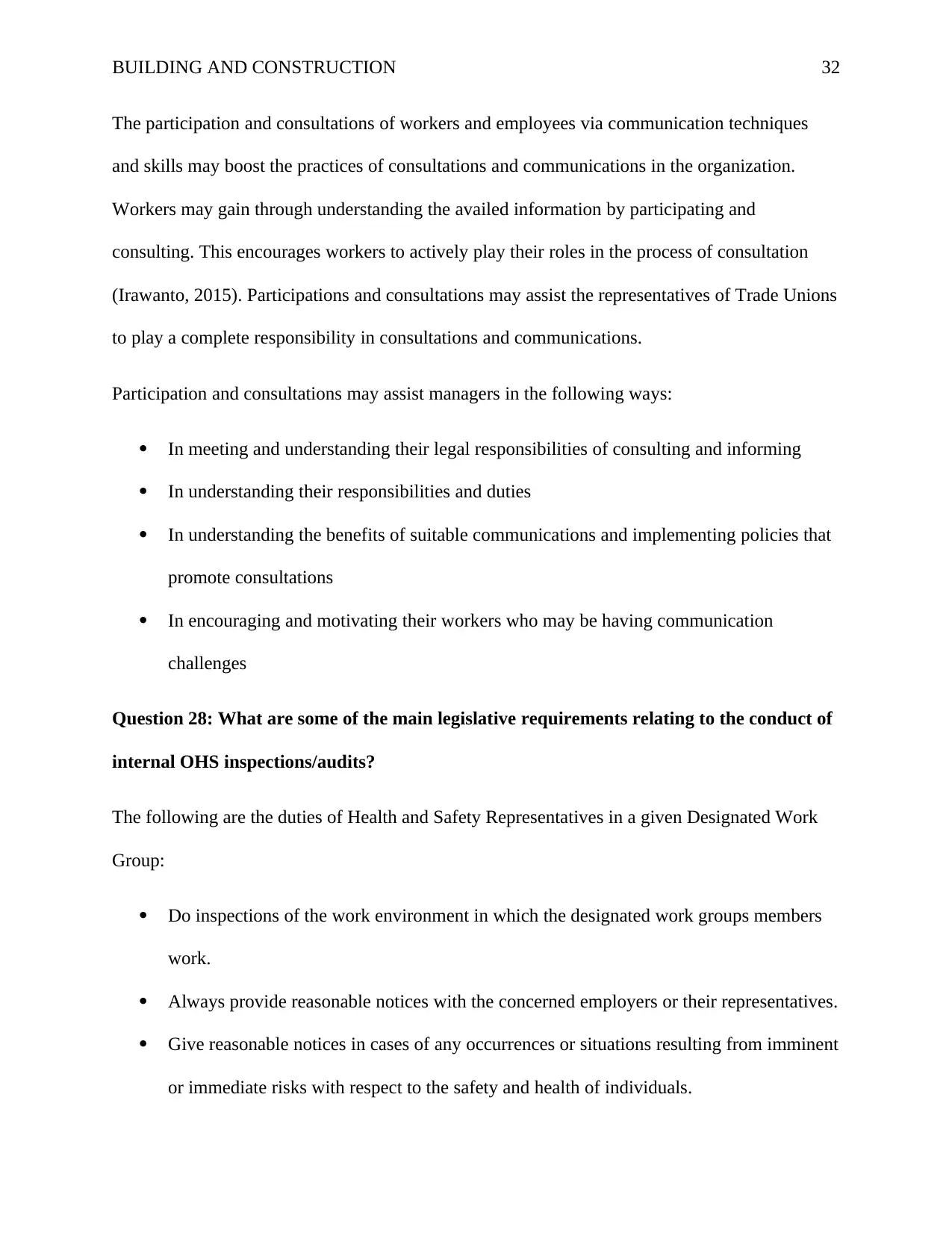
BUILDING AND CONSTRUCTION 32
The participation and consultations of workers and employees via communication techniques
and skills may boost the practices of consultations and communications in the organization.
Workers may gain through understanding the availed information by participating and
consulting. This encourages workers to actively play their roles in the process of consultation
(Irawanto, 2015). Participations and consultations may assist the representatives of Trade Unions
to play a complete responsibility in consultations and communications.
Participation and consultations may assist managers in the following ways:
In meeting and understanding their legal responsibilities of consulting and informing
In understanding their responsibilities and duties
In understanding the benefits of suitable communications and implementing policies that
promote consultations
In encouraging and motivating their workers who may be having communication
challenges
Question 28: What are some of the main legislative requirements relating to the conduct of
internal OHS inspections/audits?
The following are the duties of Health and Safety Representatives in a given Designated Work
Group:
Do inspections of the work environment in which the designated work groups members
work.
Always provide reasonable notices with the concerned employers or their representatives.
Give reasonable notices in cases of any occurrences or situations resulting from imminent
or immediate risks with respect to the safety and health of individuals.
The participation and consultations of workers and employees via communication techniques
and skills may boost the practices of consultations and communications in the organization.
Workers may gain through understanding the availed information by participating and
consulting. This encourages workers to actively play their roles in the process of consultation
(Irawanto, 2015). Participations and consultations may assist the representatives of Trade Unions
to play a complete responsibility in consultations and communications.
Participation and consultations may assist managers in the following ways:
In meeting and understanding their legal responsibilities of consulting and informing
In understanding their responsibilities and duties
In understanding the benefits of suitable communications and implementing policies that
promote consultations
In encouraging and motivating their workers who may be having communication
challenges
Question 28: What are some of the main legislative requirements relating to the conduct of
internal OHS inspections/audits?
The following are the duties of Health and Safety Representatives in a given Designated Work
Group:
Do inspections of the work environment in which the designated work groups members
work.
Always provide reasonable notices with the concerned employers or their representatives.
Give reasonable notices in cases of any occurrences or situations resulting from imminent
or immediate risks with respect to the safety and health of individuals.
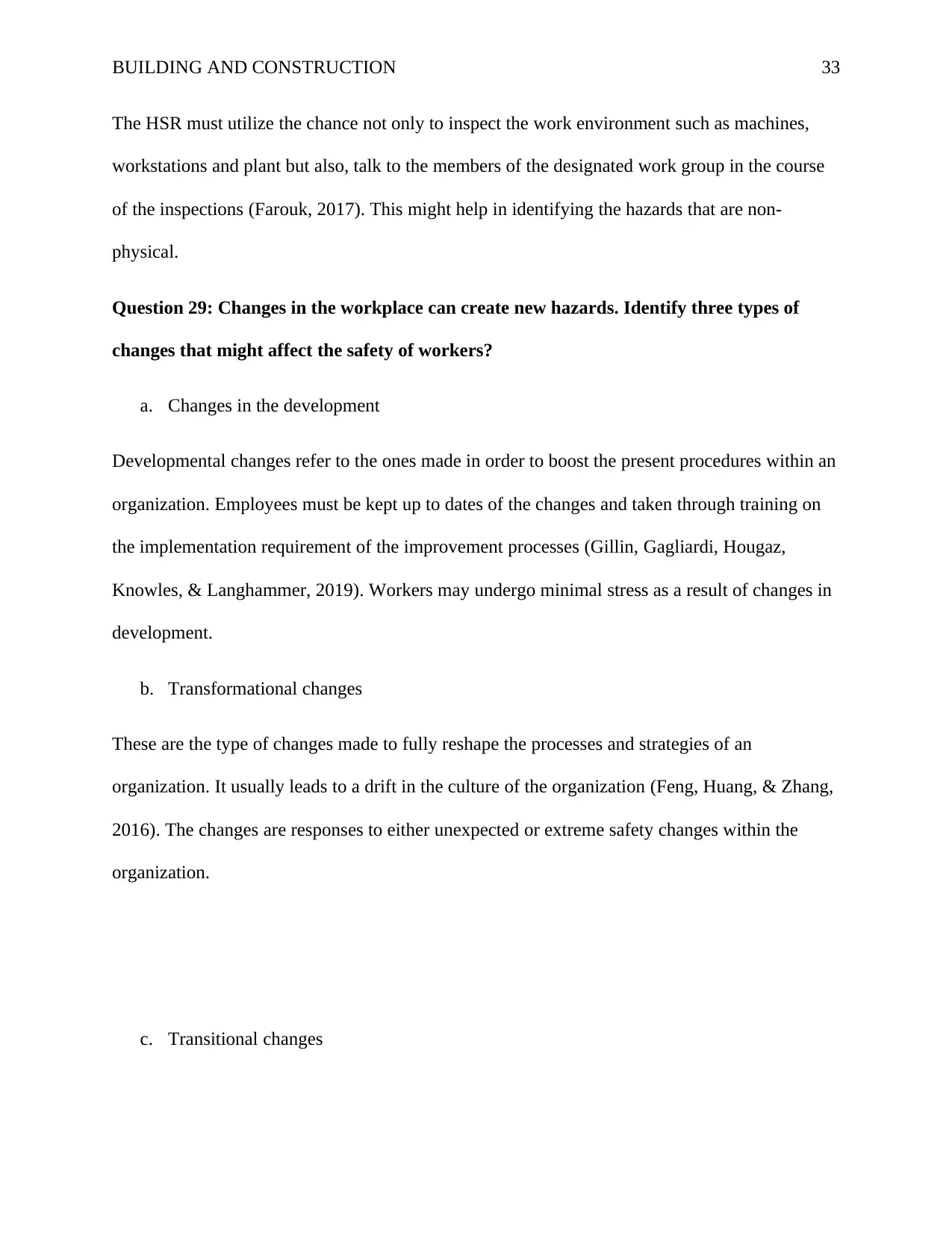
BUILDING AND CONSTRUCTION 33
The HSR must utilize the chance not only to inspect the work environment such as machines,
workstations and plant but also, talk to the members of the designated work group in the course
of the inspections (Farouk, 2017). This might help in identifying the hazards that are non-
physical.
Question 29: Changes in the workplace can create new hazards. Identify three types of
changes that might affect the safety of workers?
a. Changes in the development
Developmental changes refer to the ones made in order to boost the present procedures within an
organization. Employees must be kept up to dates of the changes and taken through training on
the implementation requirement of the improvement processes (Gillin, Gagliardi, Hougaz,
Knowles, & Langhammer, 2019). Workers may undergo minimal stress as a result of changes in
development.
b. Transformational changes
These are the type of changes made to fully reshape the processes and strategies of an
organization. It usually leads to a drift in the culture of the organization (Feng, Huang, & Zhang,
2016). The changes are responses to either unexpected or extreme safety changes within the
organization.
c. Transitional changes
The HSR must utilize the chance not only to inspect the work environment such as machines,
workstations and plant but also, talk to the members of the designated work group in the course
of the inspections (Farouk, 2017). This might help in identifying the hazards that are non-
physical.
Question 29: Changes in the workplace can create new hazards. Identify three types of
changes that might affect the safety of workers?
a. Changes in the development
Developmental changes refer to the ones made in order to boost the present procedures within an
organization. Employees must be kept up to dates of the changes and taken through training on
the implementation requirement of the improvement processes (Gillin, Gagliardi, Hougaz,
Knowles, & Langhammer, 2019). Workers may undergo minimal stress as a result of changes in
development.
b. Transformational changes
These are the type of changes made to fully reshape the processes and strategies of an
organization. It usually leads to a drift in the culture of the organization (Feng, Huang, & Zhang,
2016). The changes are responses to either unexpected or extreme safety changes within the
organization.
c. Transitional changes
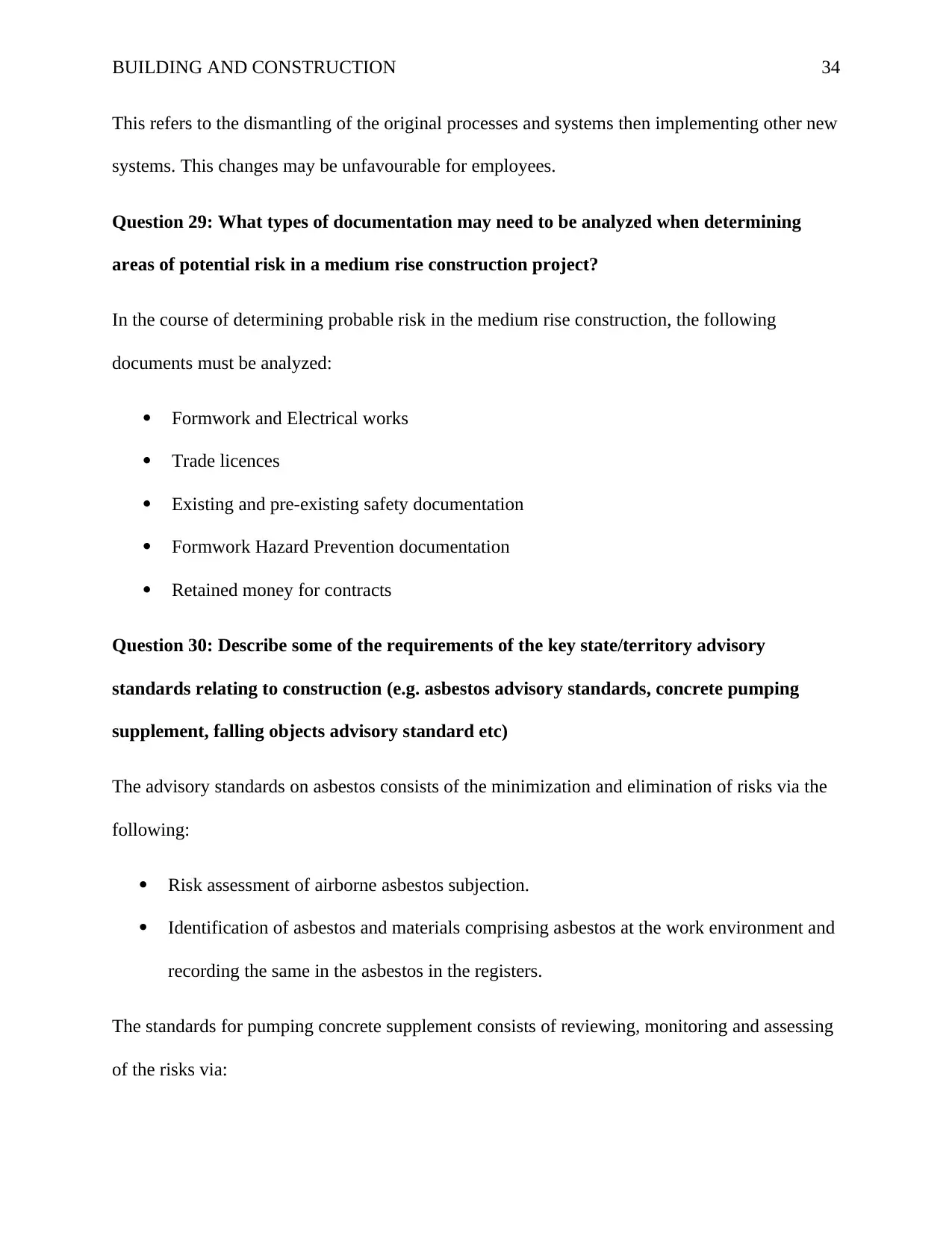
BUILDING AND CONSTRUCTION 34
This refers to the dismantling of the original processes and systems then implementing other new
systems. This changes may be unfavourable for employees.
Question 29: What types of documentation may need to be analyzed when determining
areas of potential risk in a medium rise construction project?
In the course of determining probable risk in the medium rise construction, the following
documents must be analyzed:
Formwork and Electrical works
Trade licences
Existing and pre-existing safety documentation
Formwork Hazard Prevention documentation
Retained money for contracts
Question 30: Describe some of the requirements of the key state/territory advisory
standards relating to construction (e.g. asbestos advisory standards, concrete pumping
supplement, falling objects advisory standard etc)
The advisory standards on asbestos consists of the minimization and elimination of risks via the
following:
Risk assessment of airborne asbestos subjection.
Identification of asbestos and materials comprising asbestos at the work environment and
recording the same in the asbestos in the registers.
The standards for pumping concrete supplement consists of reviewing, monitoring and assessing
of the risks via:
This refers to the dismantling of the original processes and systems then implementing other new
systems. This changes may be unfavourable for employees.
Question 29: What types of documentation may need to be analyzed when determining
areas of potential risk in a medium rise construction project?
In the course of determining probable risk in the medium rise construction, the following
documents must be analyzed:
Formwork and Electrical works
Trade licences
Existing and pre-existing safety documentation
Formwork Hazard Prevention documentation
Retained money for contracts
Question 30: Describe some of the requirements of the key state/territory advisory
standards relating to construction (e.g. asbestos advisory standards, concrete pumping
supplement, falling objects advisory standard etc)
The advisory standards on asbestos consists of the minimization and elimination of risks via the
following:
Risk assessment of airborne asbestos subjection.
Identification of asbestos and materials comprising asbestos at the work environment and
recording the same in the asbestos in the registers.
The standards for pumping concrete supplement consists of reviewing, monitoring and assessing
of the risks via:
Secure Best Marks with AI Grader
Need help grading? Try our AI Grader for instant feedback on your assignments.
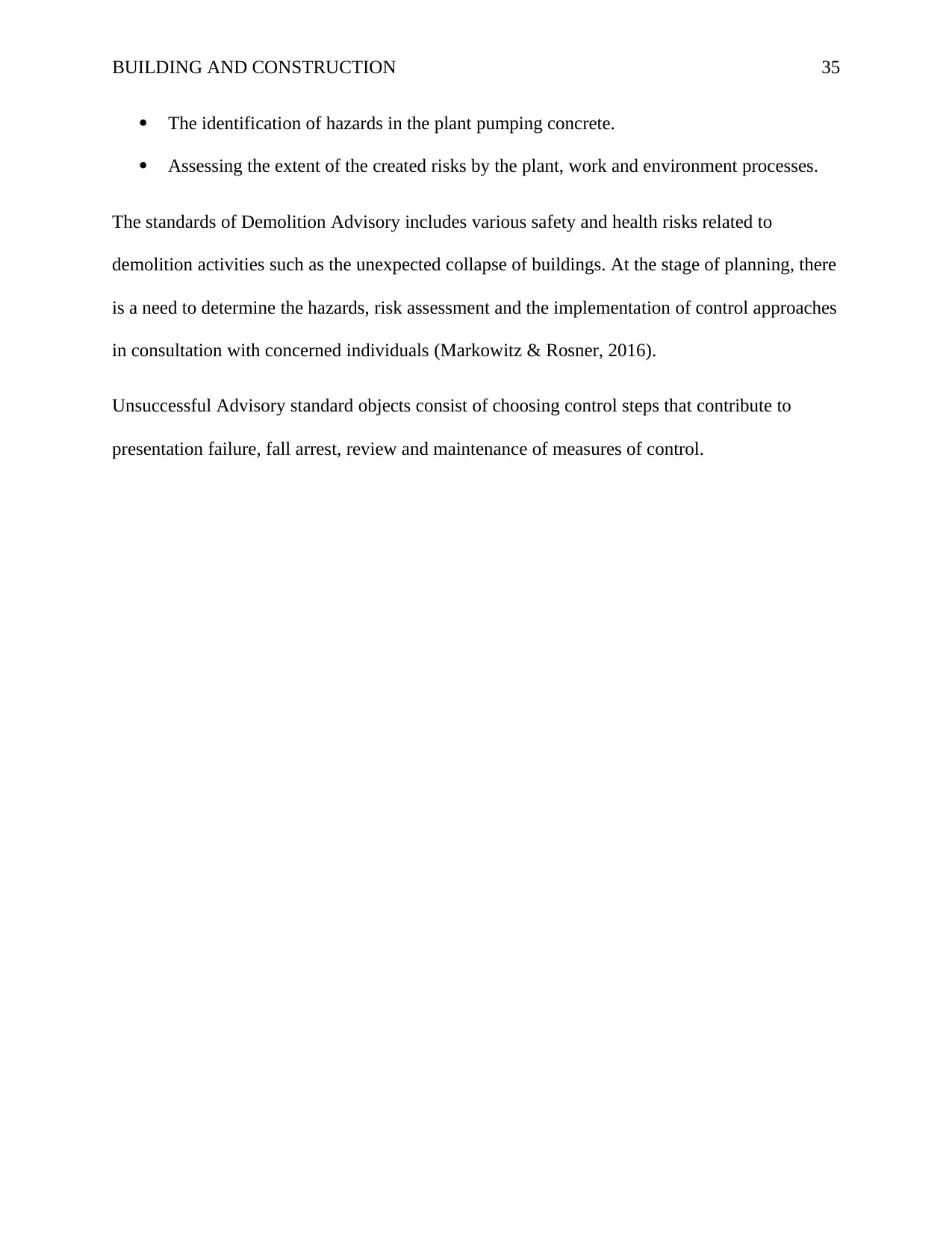
BUILDING AND CONSTRUCTION 35
The identification of hazards in the plant pumping concrete.
Assessing the extent of the created risks by the plant, work and environment processes.
The standards of Demolition Advisory includes various safety and health risks related to
demolition activities such as the unexpected collapse of buildings. At the stage of planning, there
is a need to determine the hazards, risk assessment and the implementation of control approaches
in consultation with concerned individuals (Markowitz & Rosner, 2016).
Unsuccessful Advisory standard objects consist of choosing control steps that contribute to
presentation failure, fall arrest, review and maintenance of measures of control.
The identification of hazards in the plant pumping concrete.
Assessing the extent of the created risks by the plant, work and environment processes.
The standards of Demolition Advisory includes various safety and health risks related to
demolition activities such as the unexpected collapse of buildings. At the stage of planning, there
is a need to determine the hazards, risk assessment and the implementation of control approaches
in consultation with concerned individuals (Markowitz & Rosner, 2016).
Unsuccessful Advisory standard objects consist of choosing control steps that contribute to
presentation failure, fall arrest, review and maintenance of measures of control.
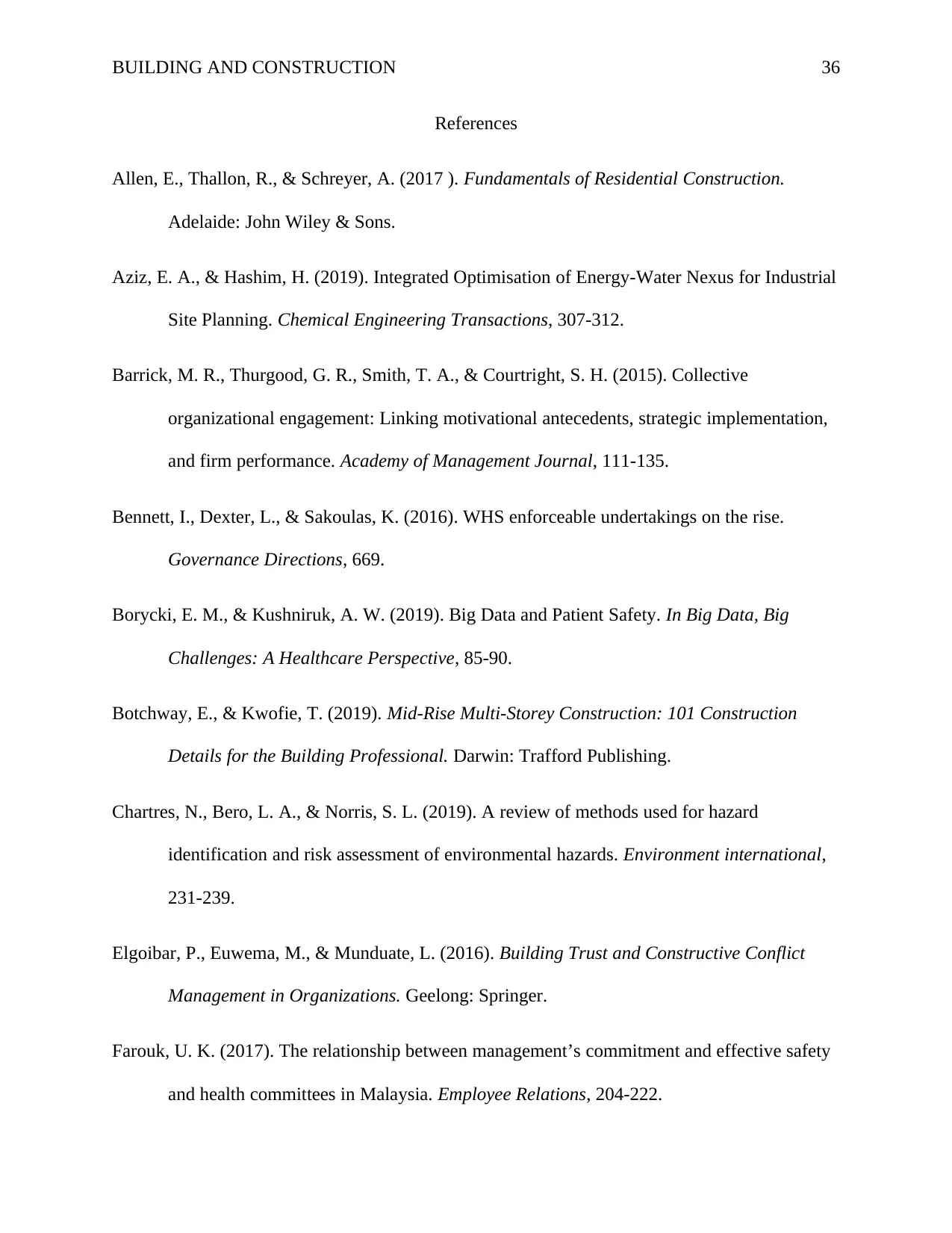
BUILDING AND CONSTRUCTION 36
References
Allen, E., Thallon, R., & Schreyer, A. (2017 ). Fundamentals of Residential Construction.
Adelaide: John Wiley & Sons.
Aziz, E. A., & Hashim, H. (2019). Integrated Optimisation of Energy-Water Nexus for Industrial
Site Planning. Chemical Engineering Transactions, 307-312.
Barrick, M. R., Thurgood, G. R., Smith, T. A., & Courtright, S. H. (2015). Collective
organizational engagement: Linking motivational antecedents, strategic implementation,
and firm performance. Academy of Management Journal, 111-135.
Bennett, I., Dexter, L., & Sakoulas, K. (2016). WHS enforceable undertakings on the rise.
Governance Directions, 669.
Borycki, E. M., & Kushniruk, A. W. (2019). Big Data and Patient Safety. In Big Data, Big
Challenges: A Healthcare Perspective, 85-90.
Botchway, E., & Kwofie, T. (2019). Mid-Rise Multi-Storey Construction: 101 Construction
Details for the Building Professional. Darwin: Trafford Publishing.
Chartres, N., Bero, L. A., & Norris, S. L. (2019). A review of methods used for hazard
identification and risk assessment of environmental hazards. Environment international,
231-239.
Elgoibar, P., Euwema, M., & Munduate, L. (2016). Building Trust and Constructive Conflict
Management in Organizations. Geelong: Springer.
Farouk, U. K. (2017). The relationship between management’s commitment and effective safety
and health committees in Malaysia. Employee Relations, 204-222.
References
Allen, E., Thallon, R., & Schreyer, A. (2017 ). Fundamentals of Residential Construction.
Adelaide: John Wiley & Sons.
Aziz, E. A., & Hashim, H. (2019). Integrated Optimisation of Energy-Water Nexus for Industrial
Site Planning. Chemical Engineering Transactions, 307-312.
Barrick, M. R., Thurgood, G. R., Smith, T. A., & Courtright, S. H. (2015). Collective
organizational engagement: Linking motivational antecedents, strategic implementation,
and firm performance. Academy of Management Journal, 111-135.
Bennett, I., Dexter, L., & Sakoulas, K. (2016). WHS enforceable undertakings on the rise.
Governance Directions, 669.
Borycki, E. M., & Kushniruk, A. W. (2019). Big Data and Patient Safety. In Big Data, Big
Challenges: A Healthcare Perspective, 85-90.
Botchway, E., & Kwofie, T. (2019). Mid-Rise Multi-Storey Construction: 101 Construction
Details for the Building Professional. Darwin: Trafford Publishing.
Chartres, N., Bero, L. A., & Norris, S. L. (2019). A review of methods used for hazard
identification and risk assessment of environmental hazards. Environment international,
231-239.
Elgoibar, P., Euwema, M., & Munduate, L. (2016). Building Trust and Constructive Conflict
Management in Organizations. Geelong: Springer.
Farouk, U. K. (2017). The relationship between management’s commitment and effective safety
and health committees in Malaysia. Employee Relations, 204-222.
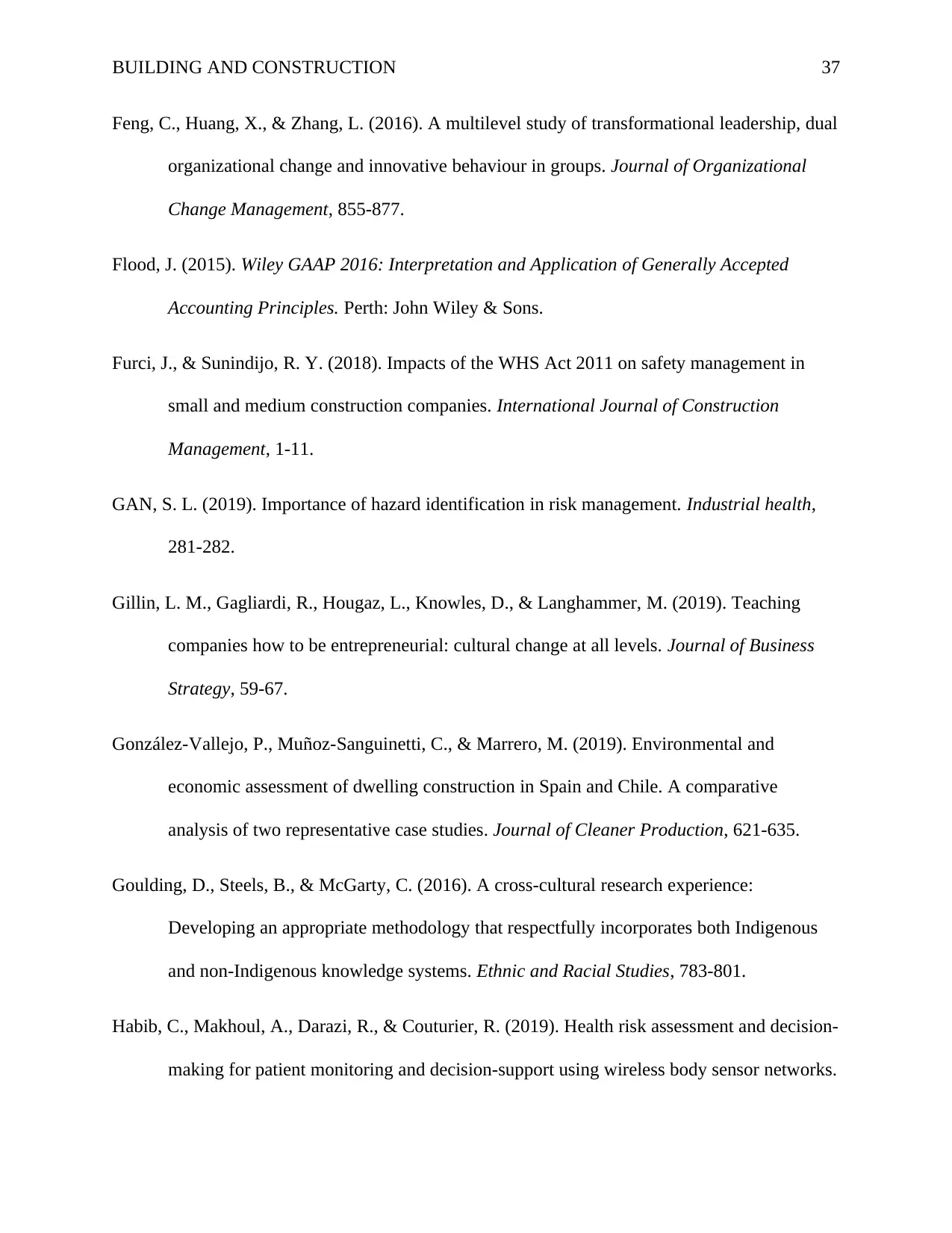
BUILDING AND CONSTRUCTION 37
Feng, C., Huang, X., & Zhang, L. (2016). A multilevel study of transformational leadership, dual
organizational change and innovative behaviour in groups. Journal of Organizational
Change Management, 855-877.
Flood, J. (2015). Wiley GAAP 2016: Interpretation and Application of Generally Accepted
Accounting Principles. Perth: John Wiley & Sons.
Furci, J., & Sunindijo, R. Y. (2018). Impacts of the WHS Act 2011 on safety management in
small and medium construction companies. International Journal of Construction
Management, 1-11.
GAN, S. L. (2019). Importance of hazard identification in risk management. Industrial health,
281-282.
Gillin, L. M., Gagliardi, R., Hougaz, L., Knowles, D., & Langhammer, M. (2019). Teaching
companies how to be entrepreneurial: cultural change at all levels. Journal of Business
Strategy, 59-67.
González-Vallejo, P., Muñoz-Sanguinetti, C., & Marrero, M. (2019). Environmental and
economic assessment of dwelling construction in Spain and Chile. A comparative
analysis of two representative case studies. Journal of Cleaner Production, 621-635.
Goulding, D., Steels, B., & McGarty, C. (2016). A cross-cultural research experience:
Developing an appropriate methodology that respectfully incorporates both Indigenous
and non-Indigenous knowledge systems. Ethnic and Racial Studies, 783-801.
Habib, C., Makhoul, A., Darazi, R., & Couturier, R. (2019). Health risk assessment and decision-
making for patient monitoring and decision-support using wireless body sensor networks.
Feng, C., Huang, X., & Zhang, L. (2016). A multilevel study of transformational leadership, dual
organizational change and innovative behaviour in groups. Journal of Organizational
Change Management, 855-877.
Flood, J. (2015). Wiley GAAP 2016: Interpretation and Application of Generally Accepted
Accounting Principles. Perth: John Wiley & Sons.
Furci, J., & Sunindijo, R. Y. (2018). Impacts of the WHS Act 2011 on safety management in
small and medium construction companies. International Journal of Construction
Management, 1-11.
GAN, S. L. (2019). Importance of hazard identification in risk management. Industrial health,
281-282.
Gillin, L. M., Gagliardi, R., Hougaz, L., Knowles, D., & Langhammer, M. (2019). Teaching
companies how to be entrepreneurial: cultural change at all levels. Journal of Business
Strategy, 59-67.
González-Vallejo, P., Muñoz-Sanguinetti, C., & Marrero, M. (2019). Environmental and
economic assessment of dwelling construction in Spain and Chile. A comparative
analysis of two representative case studies. Journal of Cleaner Production, 621-635.
Goulding, D., Steels, B., & McGarty, C. (2016). A cross-cultural research experience:
Developing an appropriate methodology that respectfully incorporates both Indigenous
and non-Indigenous knowledge systems. Ethnic and Racial Studies, 783-801.
Habib, C., Makhoul, A., Darazi, R., & Couturier, R. (2019). Health risk assessment and decision-
making for patient monitoring and decision-support using wireless body sensor networks.
Paraphrase This Document
Need a fresh take? Get an instant paraphrase of this document with our AI Paraphraser
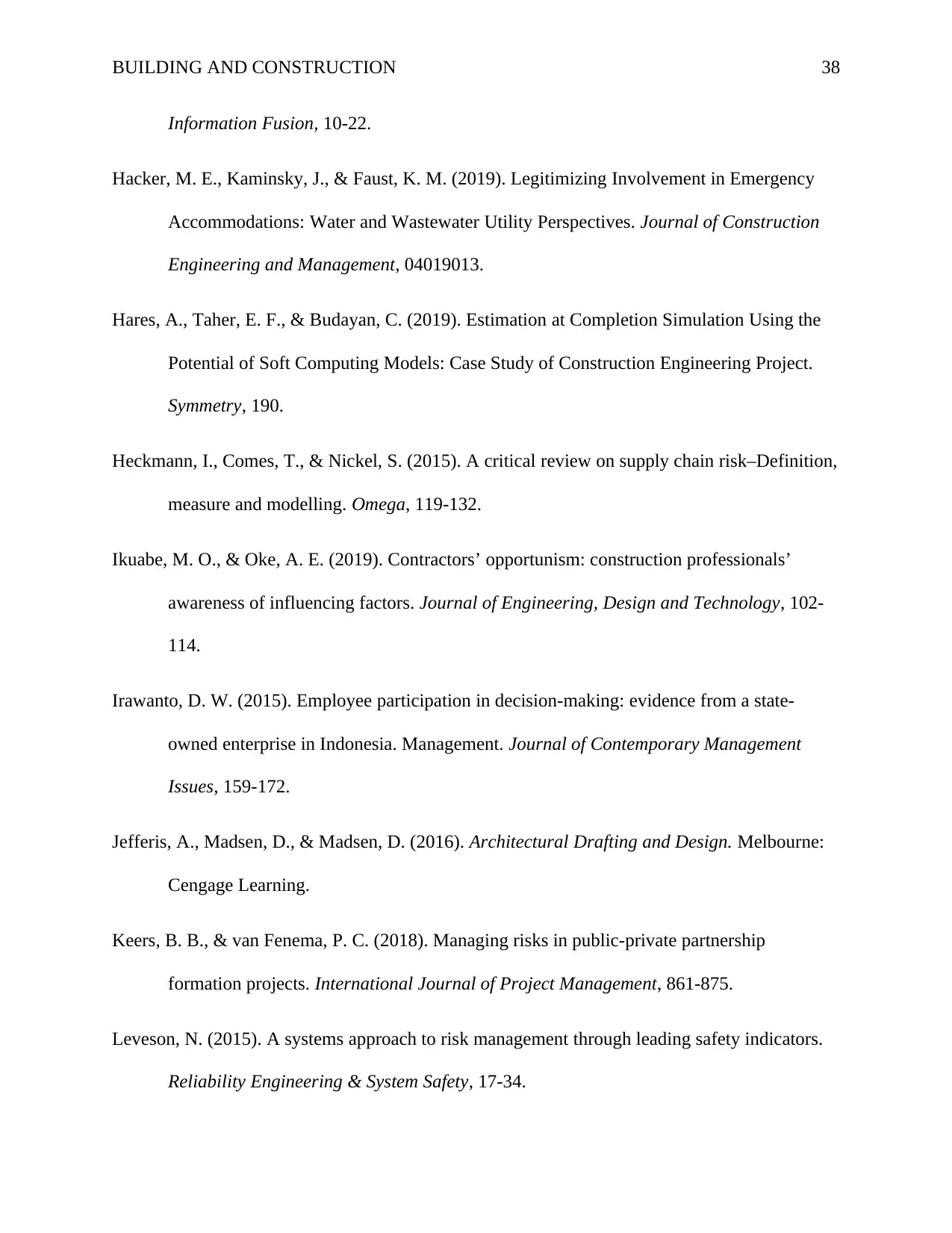
BUILDING AND CONSTRUCTION 38
Information Fusion, 10-22.
Hacker, M. E., Kaminsky, J., & Faust, K. M. (2019). Legitimizing Involvement in Emergency
Accommodations: Water and Wastewater Utility Perspectives. Journal of Construction
Engineering and Management, 04019013.
Hares, A., Taher, E. F., & Budayan, C. (2019). Estimation at Completion Simulation Using the
Potential of Soft Computing Models: Case Study of Construction Engineering Project.
Symmetry, 190.
Heckmann, I., Comes, T., & Nickel, S. (2015). A critical review on supply chain risk–Definition,
measure and modelling. Omega, 119-132.
Ikuabe, M. O., & Oke, A. E. (2019). Contractors’ opportunism: construction professionals’
awareness of influencing factors. Journal of Engineering, Design and Technology, 102-
114.
Irawanto, D. W. (2015). Employee participation in decision-making: evidence from a state-
owned enterprise in Indonesia. Management. Journal of Contemporary Management
Issues, 159-172.
Jefferis, A., Madsen, D., & Madsen, D. (2016). Architectural Drafting and Design. Melbourne:
Cengage Learning.
Keers, B. B., & van Fenema, P. C. (2018). Managing risks in public-private partnership
formation projects. International Journal of Project Management, 861-875.
Leveson, N. (2015). A systems approach to risk management through leading safety indicators.
Reliability Engineering & System Safety, 17-34.
Information Fusion, 10-22.
Hacker, M. E., Kaminsky, J., & Faust, K. M. (2019). Legitimizing Involvement in Emergency
Accommodations: Water and Wastewater Utility Perspectives. Journal of Construction
Engineering and Management, 04019013.
Hares, A., Taher, E. F., & Budayan, C. (2019). Estimation at Completion Simulation Using the
Potential of Soft Computing Models: Case Study of Construction Engineering Project.
Symmetry, 190.
Heckmann, I., Comes, T., & Nickel, S. (2015). A critical review on supply chain risk–Definition,
measure and modelling. Omega, 119-132.
Ikuabe, M. O., & Oke, A. E. (2019). Contractors’ opportunism: construction professionals’
awareness of influencing factors. Journal of Engineering, Design and Technology, 102-
114.
Irawanto, D. W. (2015). Employee participation in decision-making: evidence from a state-
owned enterprise in Indonesia. Management. Journal of Contemporary Management
Issues, 159-172.
Jefferis, A., Madsen, D., & Madsen, D. (2016). Architectural Drafting and Design. Melbourne:
Cengage Learning.
Keers, B. B., & van Fenema, P. C. (2018). Managing risks in public-private partnership
formation projects. International Journal of Project Management, 861-875.
Leveson, N. (2015). A systems approach to risk management through leading safety indicators.
Reliability Engineering & System Safety, 17-34.
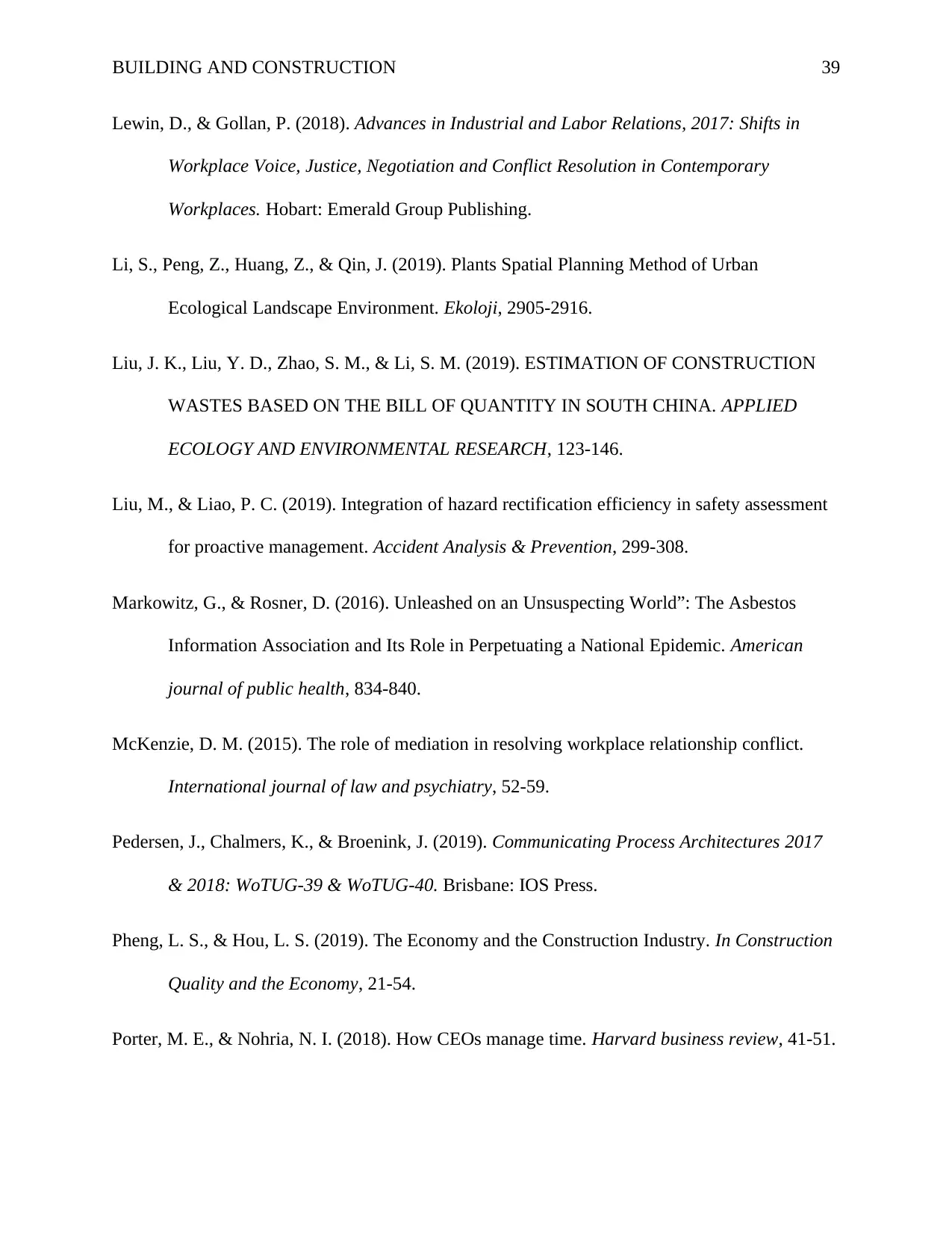
BUILDING AND CONSTRUCTION 39
Lewin, D., & Gollan, P. (2018). Advances in Industrial and Labor Relations, 2017: Shifts in
Workplace Voice, Justice, Negotiation and Conflict Resolution in Contemporary
Workplaces. Hobart: Emerald Group Publishing.
Li, S., Peng, Z., Huang, Z., & Qin, J. (2019). Plants Spatial Planning Method of Urban
Ecological Landscape Environment. Ekoloji, 2905-2916.
Liu, J. K., Liu, Y. D., Zhao, S. M., & Li, S. M. (2019). ESTIMATION OF CONSTRUCTION
WASTES BASED ON THE BILL OF QUANTITY IN SOUTH CHINA. APPLIED
ECOLOGY AND ENVIRONMENTAL RESEARCH, 123-146.
Liu, M., & Liao, P. C. (2019). Integration of hazard rectification efficiency in safety assessment
for proactive management. Accident Analysis & Prevention, 299-308.
Markowitz, G., & Rosner, D. (2016). Unleashed on an Unsuspecting World”: The Asbestos
Information Association and Its Role in Perpetuating a National Epidemic. American
journal of public health, 834-840.
McKenzie, D. M. (2015). The role of mediation in resolving workplace relationship conflict.
International journal of law and psychiatry, 52-59.
Pedersen, J., Chalmers, K., & Broenink, J. (2019). Communicating Process Architectures 2017
& 2018: WoTUG-39 & WoTUG-40. Brisbane: IOS Press.
Pheng, L. S., & Hou, L. S. (2019). The Economy and the Construction Industry. In Construction
Quality and the Economy, 21-54.
Porter, M. E., & Nohria, N. I. (2018). How CEOs manage time. Harvard business review, 41-51.
Lewin, D., & Gollan, P. (2018). Advances in Industrial and Labor Relations, 2017: Shifts in
Workplace Voice, Justice, Negotiation and Conflict Resolution in Contemporary
Workplaces. Hobart: Emerald Group Publishing.
Li, S., Peng, Z., Huang, Z., & Qin, J. (2019). Plants Spatial Planning Method of Urban
Ecological Landscape Environment. Ekoloji, 2905-2916.
Liu, J. K., Liu, Y. D., Zhao, S. M., & Li, S. M. (2019). ESTIMATION OF CONSTRUCTION
WASTES BASED ON THE BILL OF QUANTITY IN SOUTH CHINA. APPLIED
ECOLOGY AND ENVIRONMENTAL RESEARCH, 123-146.
Liu, M., & Liao, P. C. (2019). Integration of hazard rectification efficiency in safety assessment
for proactive management. Accident Analysis & Prevention, 299-308.
Markowitz, G., & Rosner, D. (2016). Unleashed on an Unsuspecting World”: The Asbestos
Information Association and Its Role in Perpetuating a National Epidemic. American
journal of public health, 834-840.
McKenzie, D. M. (2015). The role of mediation in resolving workplace relationship conflict.
International journal of law and psychiatry, 52-59.
Pedersen, J., Chalmers, K., & Broenink, J. (2019). Communicating Process Architectures 2017
& 2018: WoTUG-39 & WoTUG-40. Brisbane: IOS Press.
Pheng, L. S., & Hou, L. S. (2019). The Economy and the Construction Industry. In Construction
Quality and the Economy, 21-54.
Porter, M. E., & Nohria, N. I. (2018). How CEOs manage time. Harvard business review, 41-51.
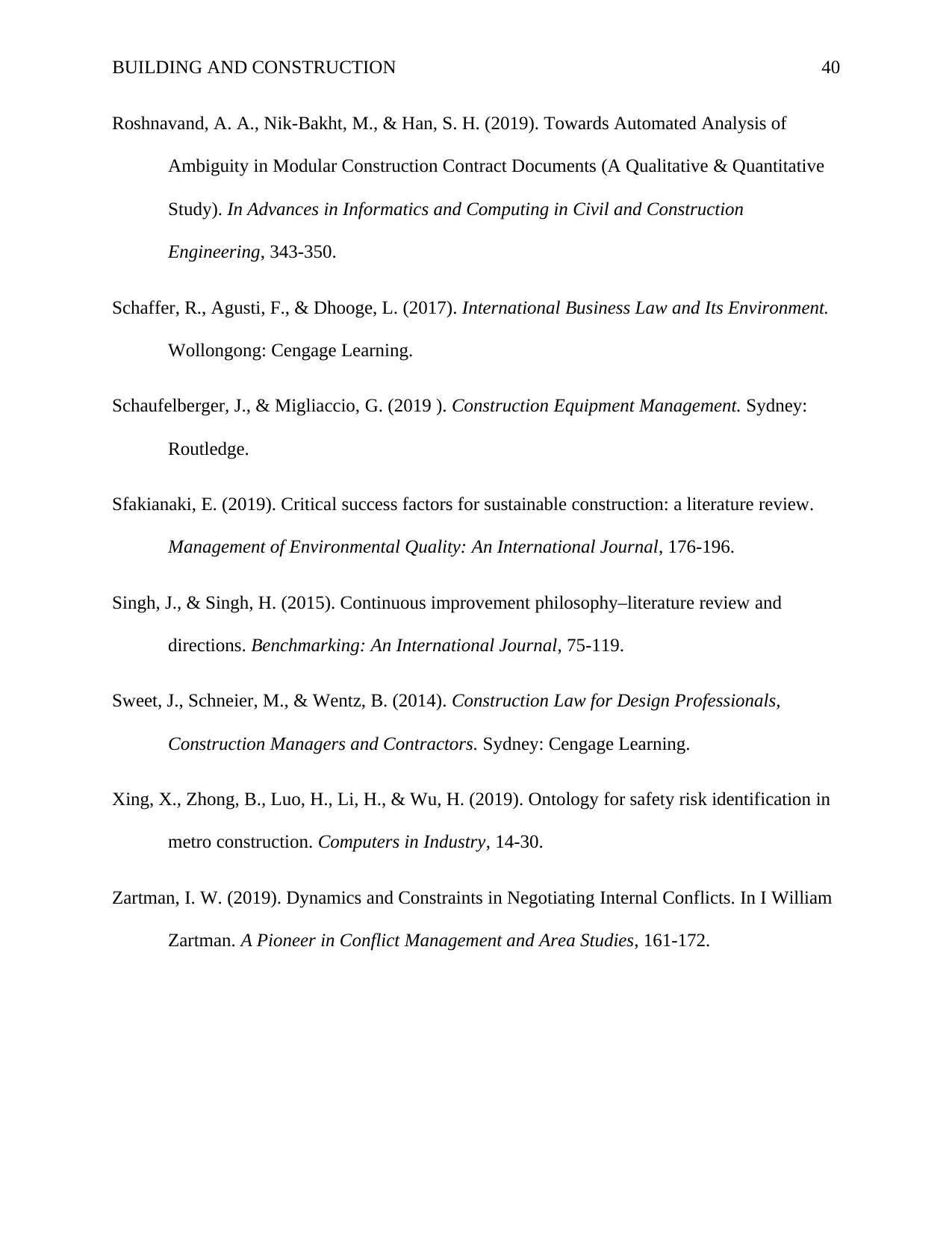
BUILDING AND CONSTRUCTION 40
Roshnavand, A. A., Nik-Bakht, M., & Han, S. H. (2019). Towards Automated Analysis of
Ambiguity in Modular Construction Contract Documents (A Qualitative & Quantitative
Study). In Advances in Informatics and Computing in Civil and Construction
Engineering, 343-350.
Schaffer, R., Agusti, F., & Dhooge, L. (2017). International Business Law and Its Environment.
Wollongong: Cengage Learning.
Schaufelberger, J., & Migliaccio, G. (2019 ). Construction Equipment Management. Sydney:
Routledge.
Sfakianaki, E. (2019). Critical success factors for sustainable construction: a literature review.
Management of Environmental Quality: An International Journal, 176-196.
Singh, J., & Singh, H. (2015). Continuous improvement philosophy–literature review and
directions. Benchmarking: An International Journal, 75-119.
Sweet, J., Schneier, M., & Wentz, B. (2014). Construction Law for Design Professionals,
Construction Managers and Contractors. Sydney: Cengage Learning.
Xing, X., Zhong, B., Luo, H., Li, H., & Wu, H. (2019). Ontology for safety risk identification in
metro construction. Computers in Industry, 14-30.
Zartman, I. W. (2019). Dynamics and Constraints in Negotiating Internal Conflicts. In I William
Zartman. A Pioneer in Conflict Management and Area Studies, 161-172.
Roshnavand, A. A., Nik-Bakht, M., & Han, S. H. (2019). Towards Automated Analysis of
Ambiguity in Modular Construction Contract Documents (A Qualitative & Quantitative
Study). In Advances in Informatics and Computing in Civil and Construction
Engineering, 343-350.
Schaffer, R., Agusti, F., & Dhooge, L. (2017). International Business Law and Its Environment.
Wollongong: Cengage Learning.
Schaufelberger, J., & Migliaccio, G. (2019 ). Construction Equipment Management. Sydney:
Routledge.
Sfakianaki, E. (2019). Critical success factors for sustainable construction: a literature review.
Management of Environmental Quality: An International Journal, 176-196.
Singh, J., & Singh, H. (2015). Continuous improvement philosophy–literature review and
directions. Benchmarking: An International Journal, 75-119.
Sweet, J., Schneier, M., & Wentz, B. (2014). Construction Law for Design Professionals,
Construction Managers and Contractors. Sydney: Cengage Learning.
Xing, X., Zhong, B., Luo, H., Li, H., & Wu, H. (2019). Ontology for safety risk identification in
metro construction. Computers in Industry, 14-30.
Zartman, I. W. (2019). Dynamics and Constraints in Negotiating Internal Conflicts. In I William
Zartman. A Pioneer in Conflict Management and Area Studies, 161-172.
1 out of 40
Related Documents
Your All-in-One AI-Powered Toolkit for Academic Success.
+13062052269
info@desklib.com
Available 24*7 on WhatsApp / Email
![[object Object]](/_next/static/media/star-bottom.7253800d.svg)
Unlock your academic potential
© 2024 | Zucol Services PVT LTD | All rights reserved.




